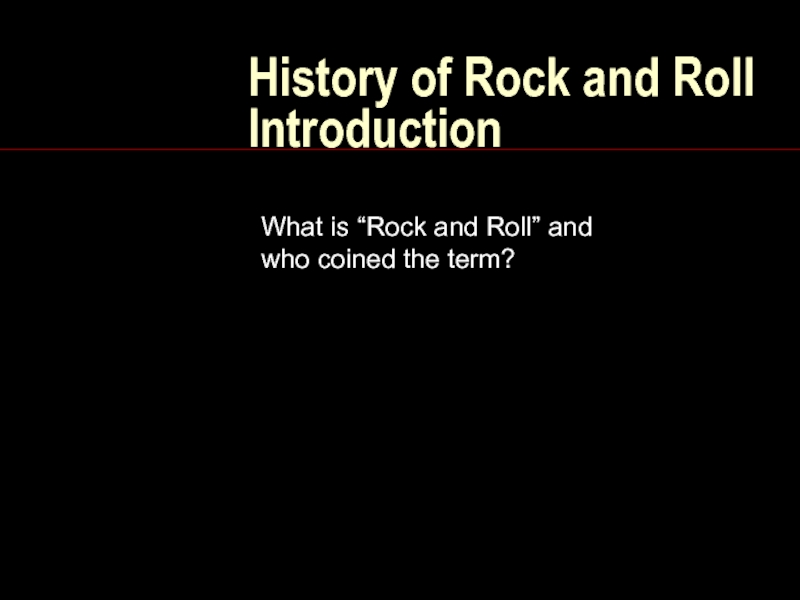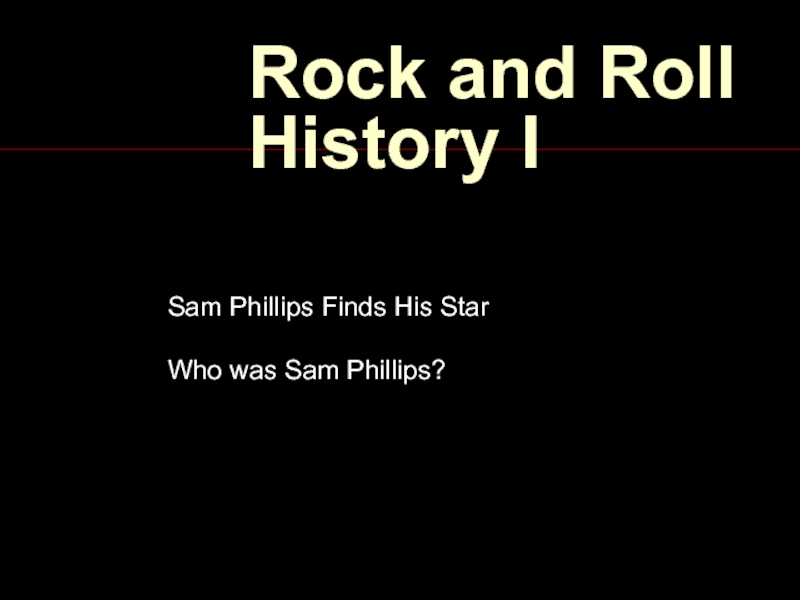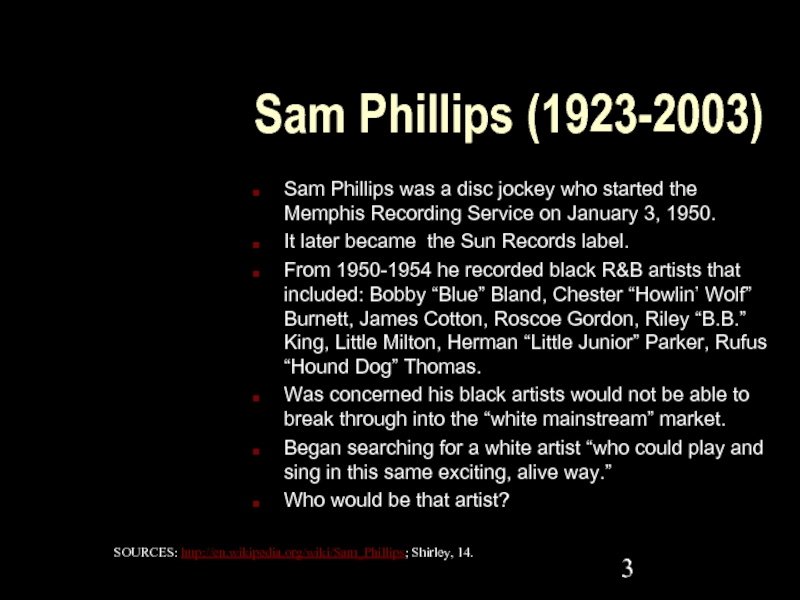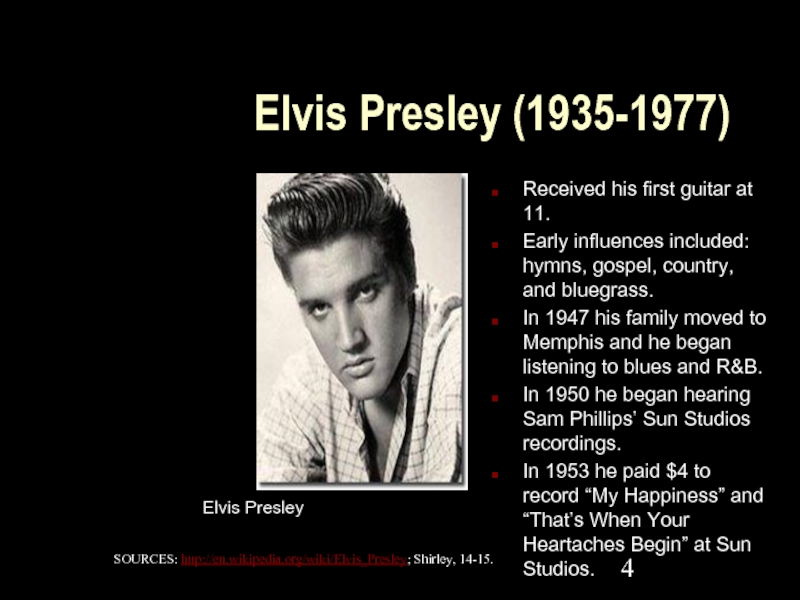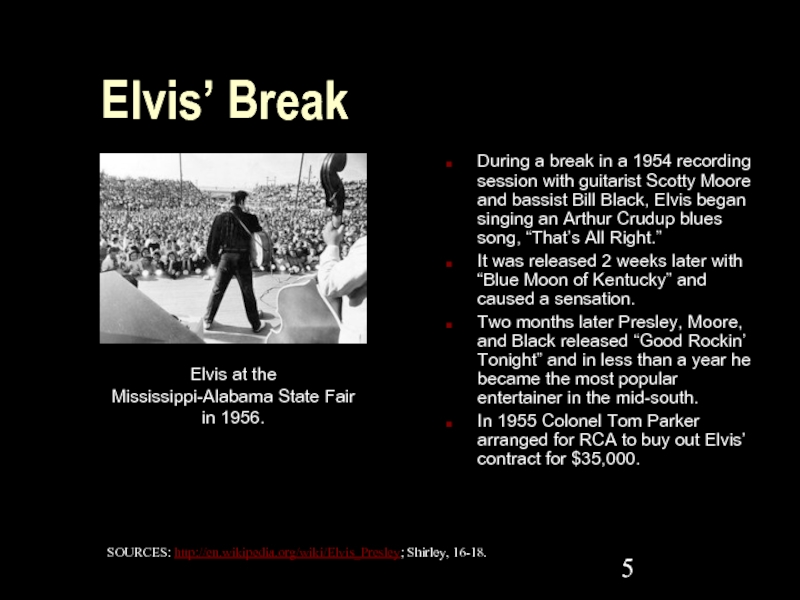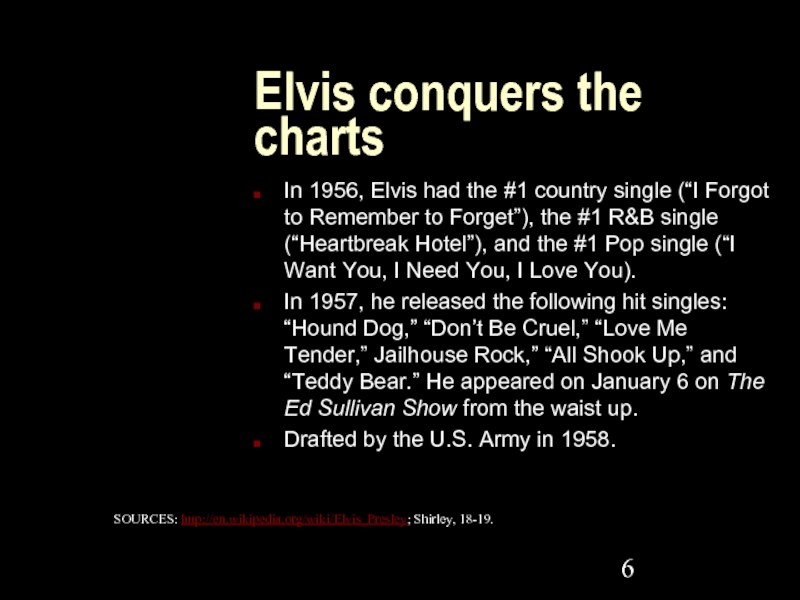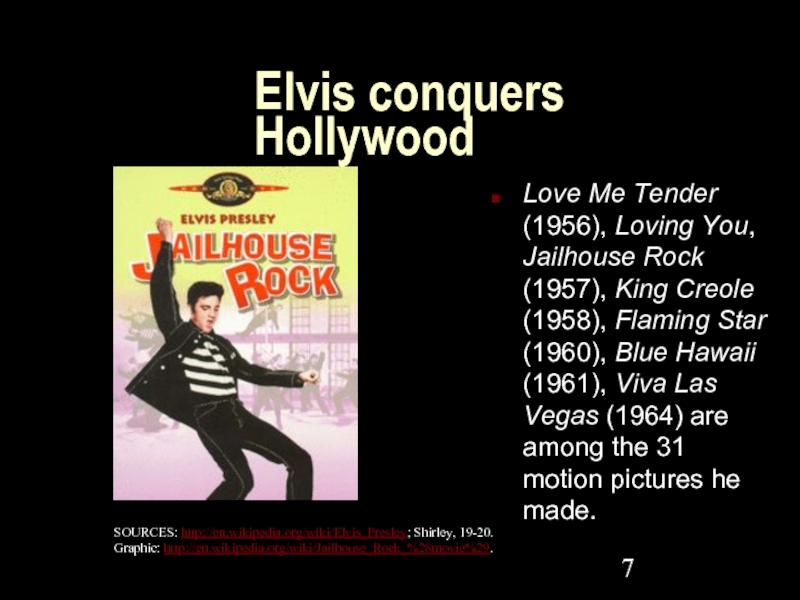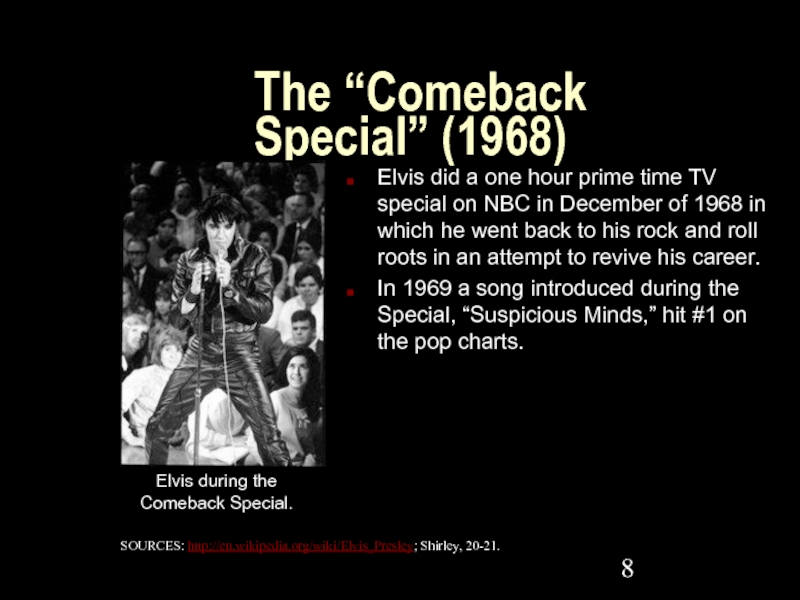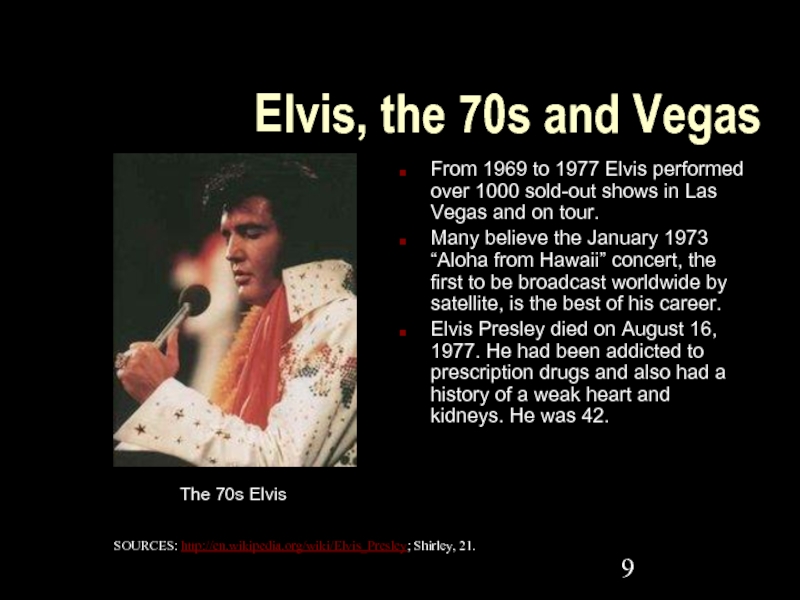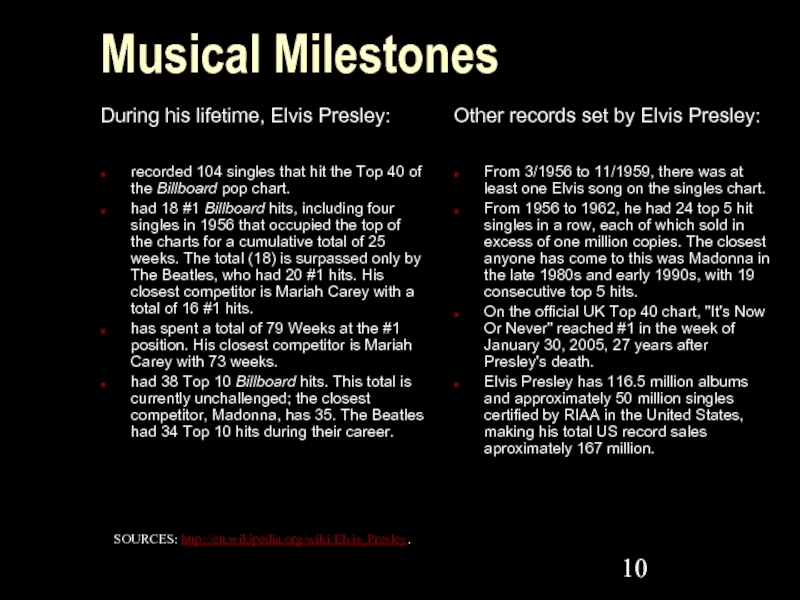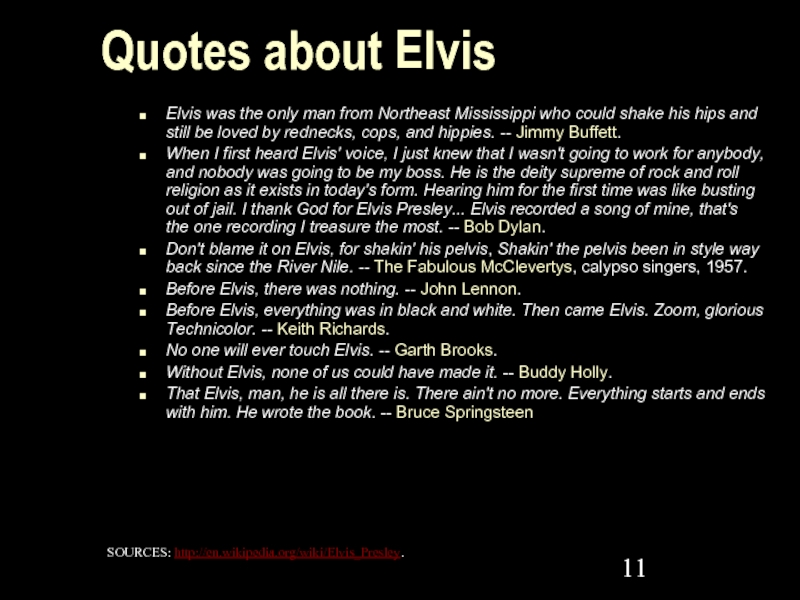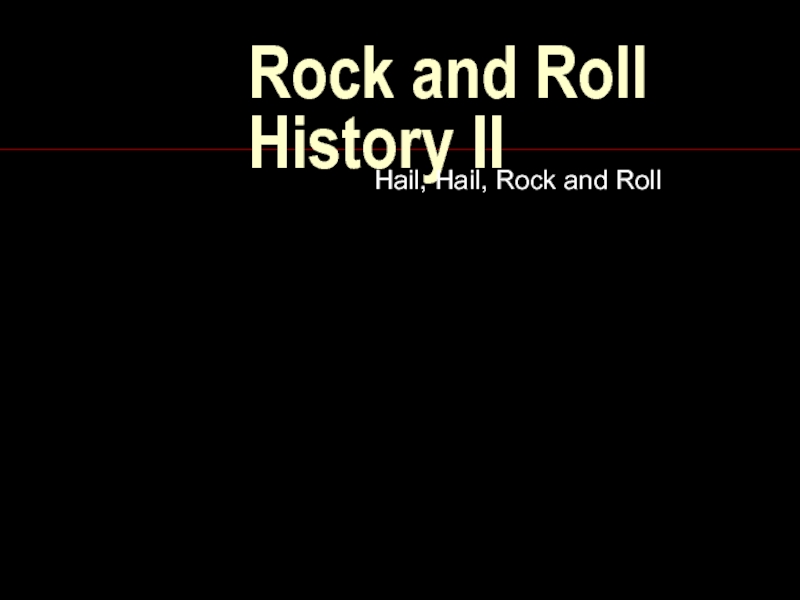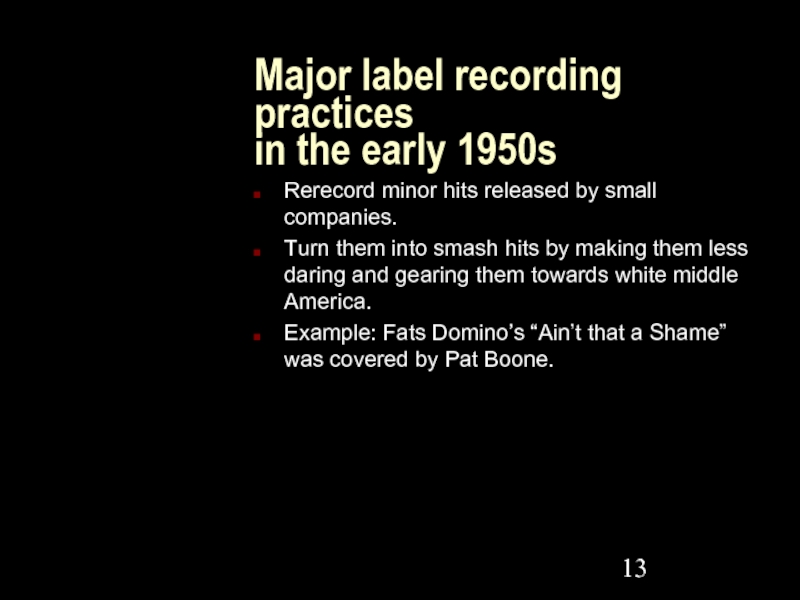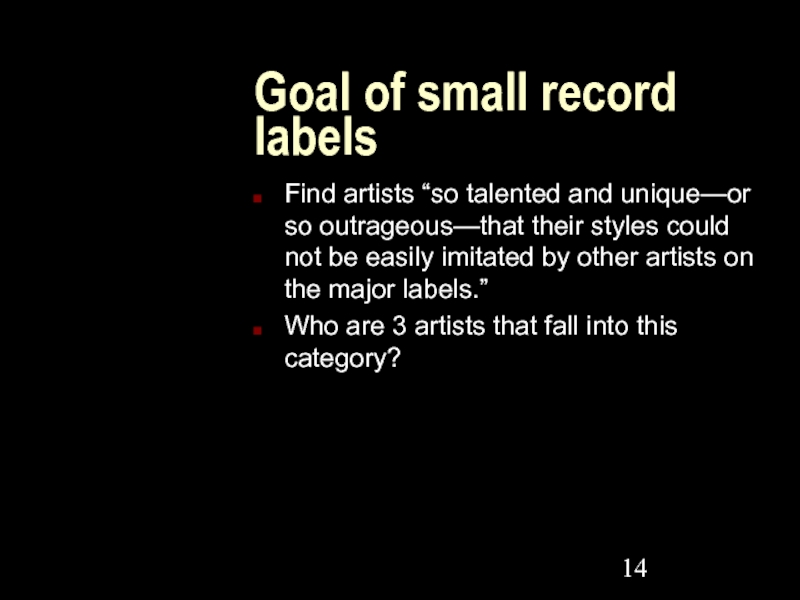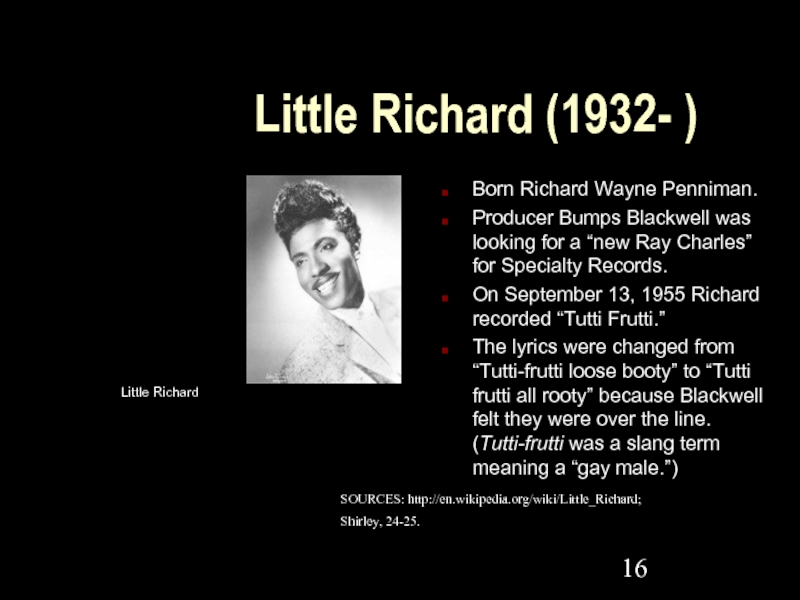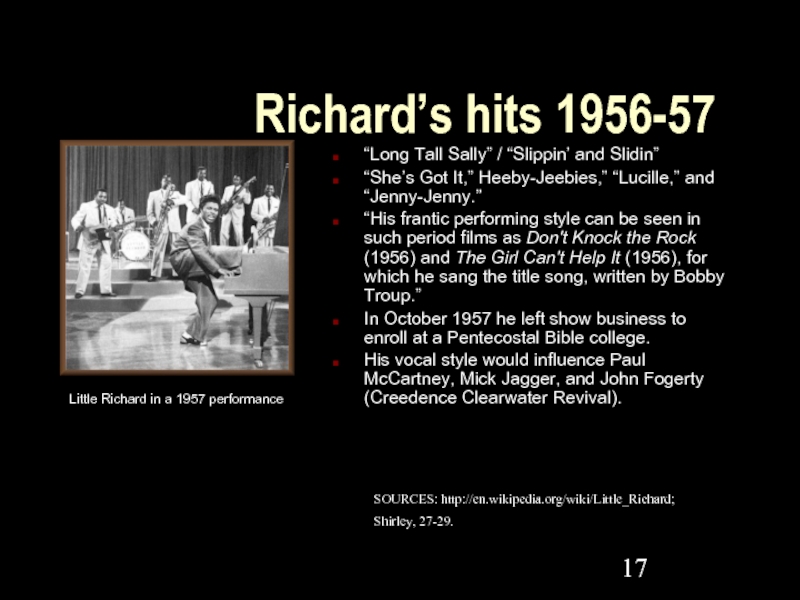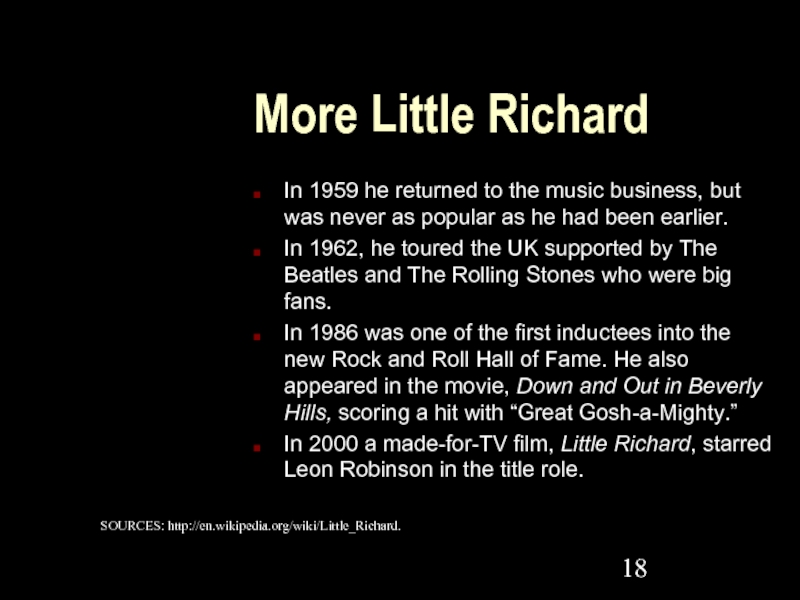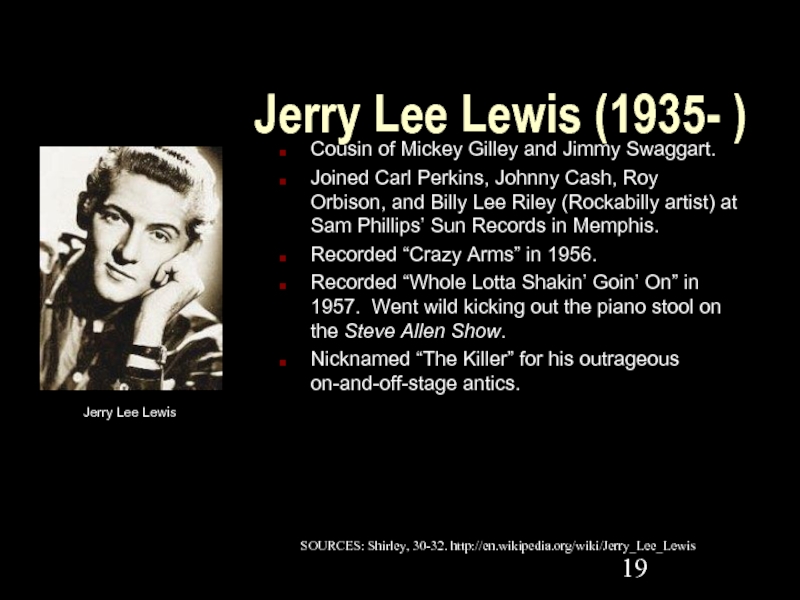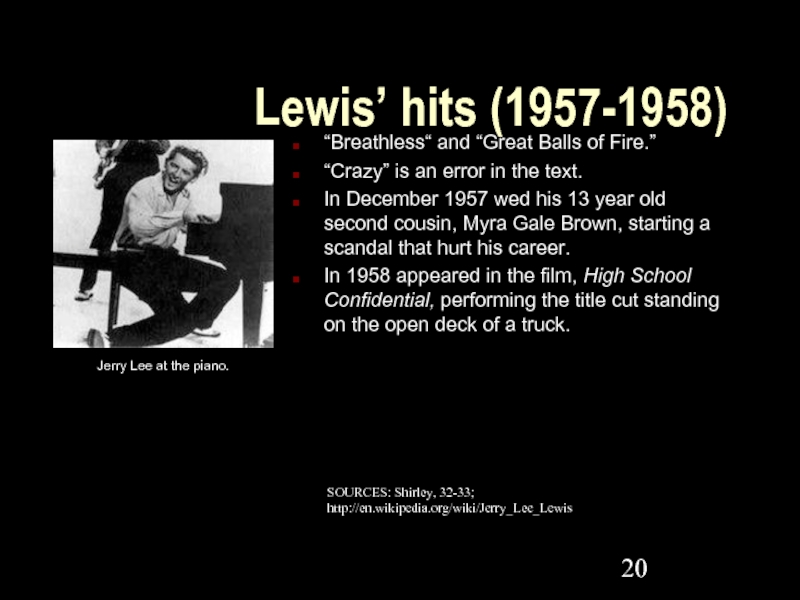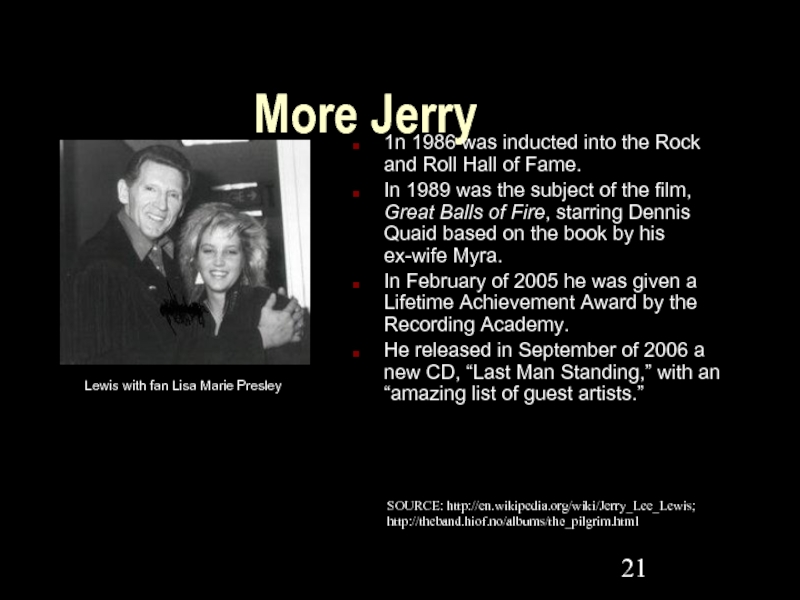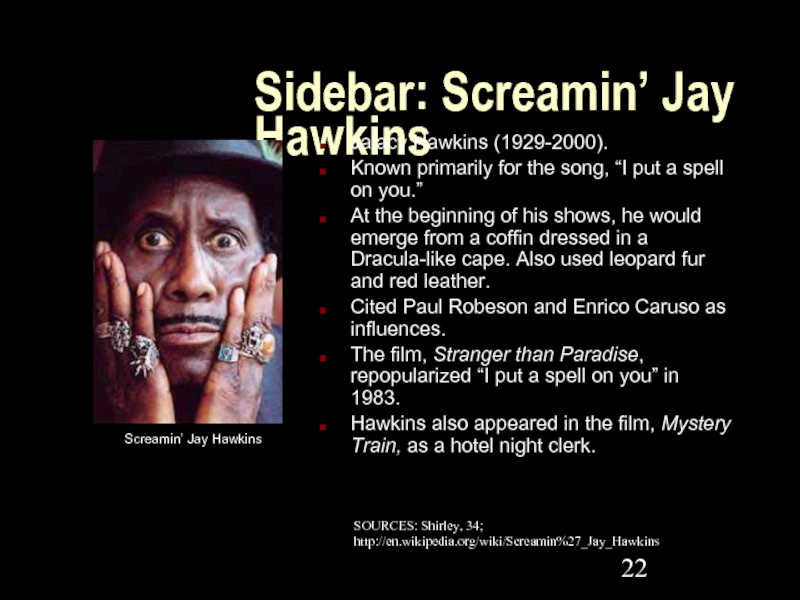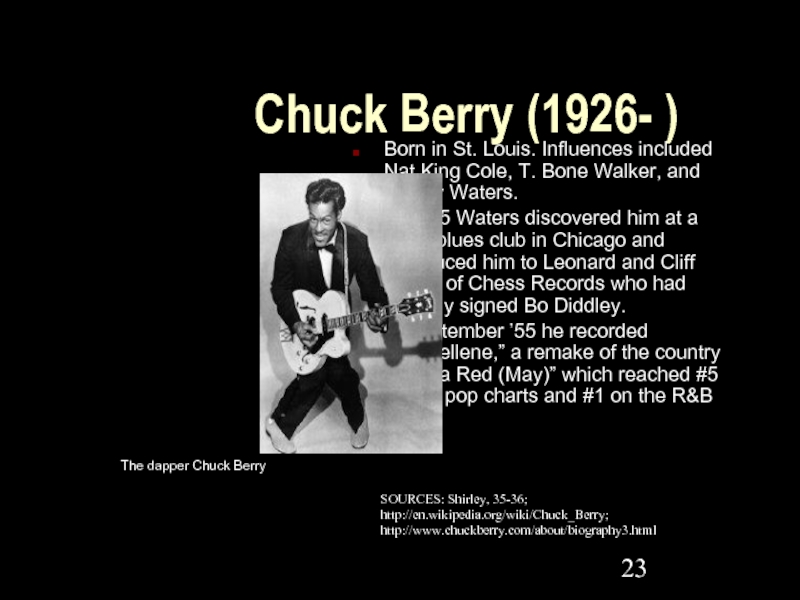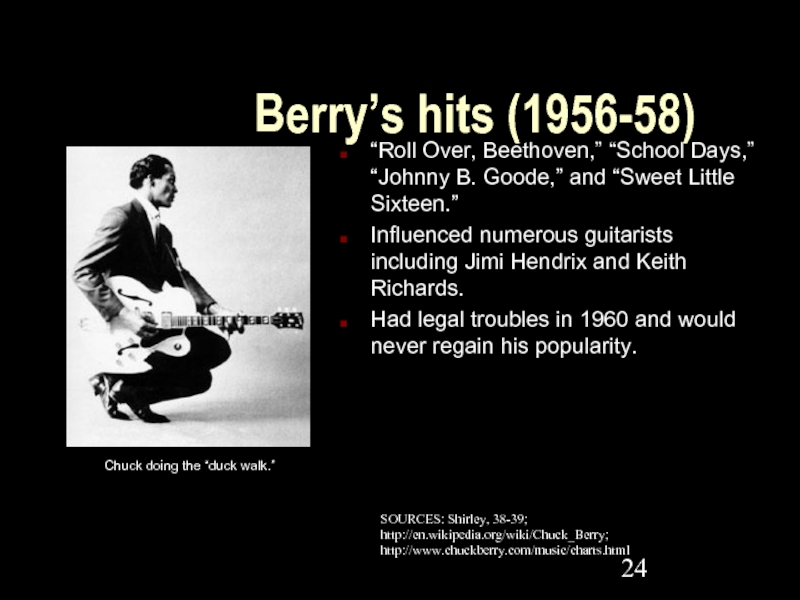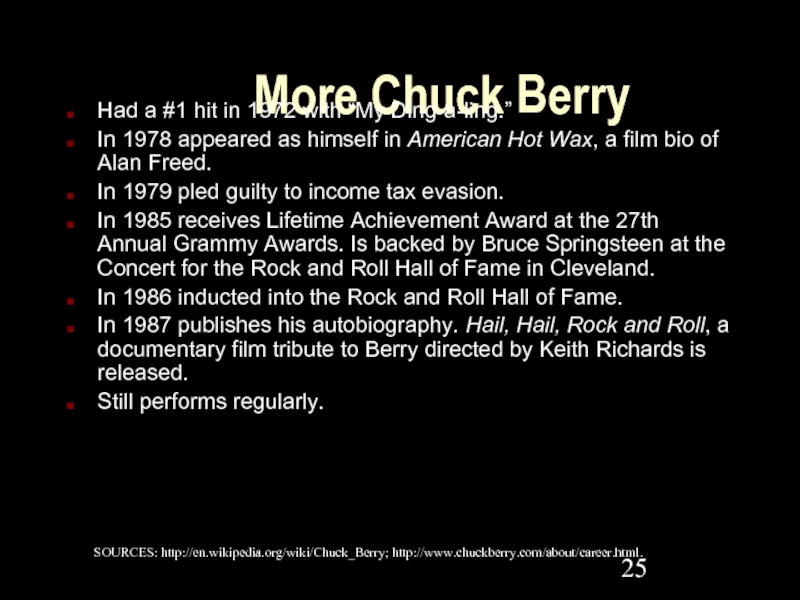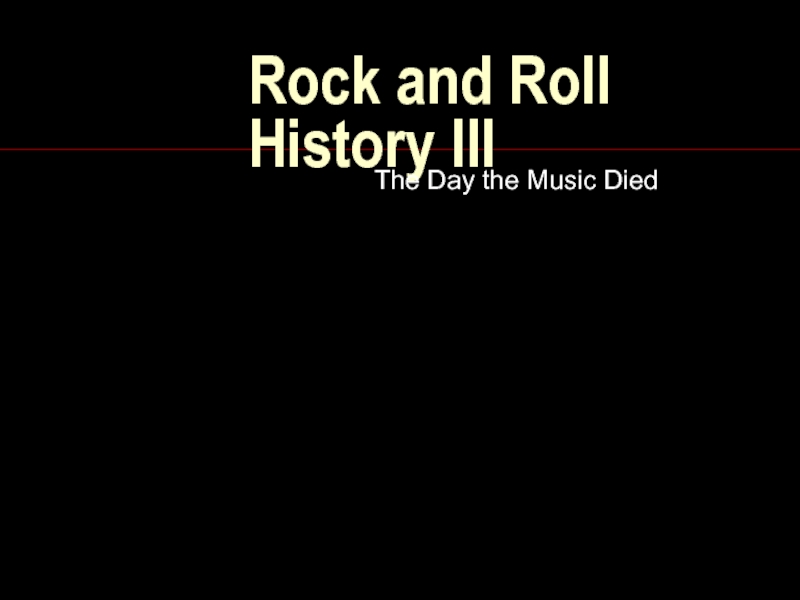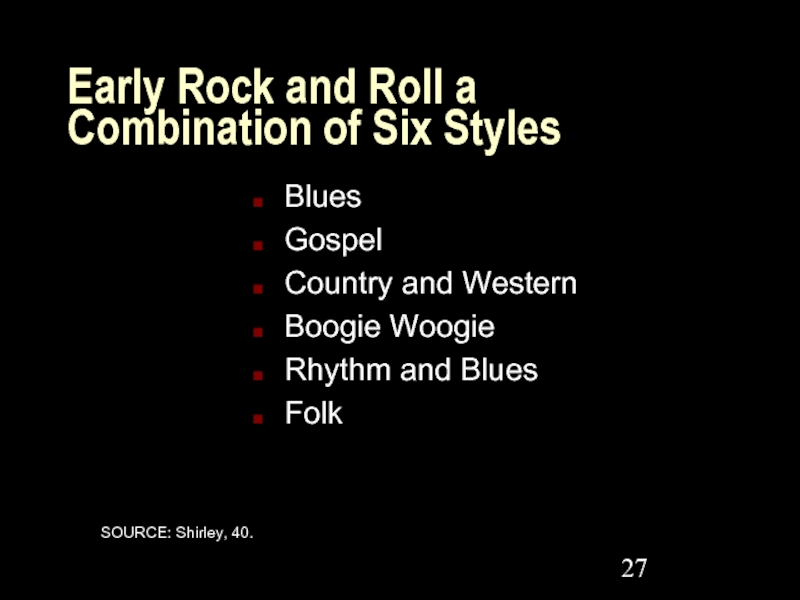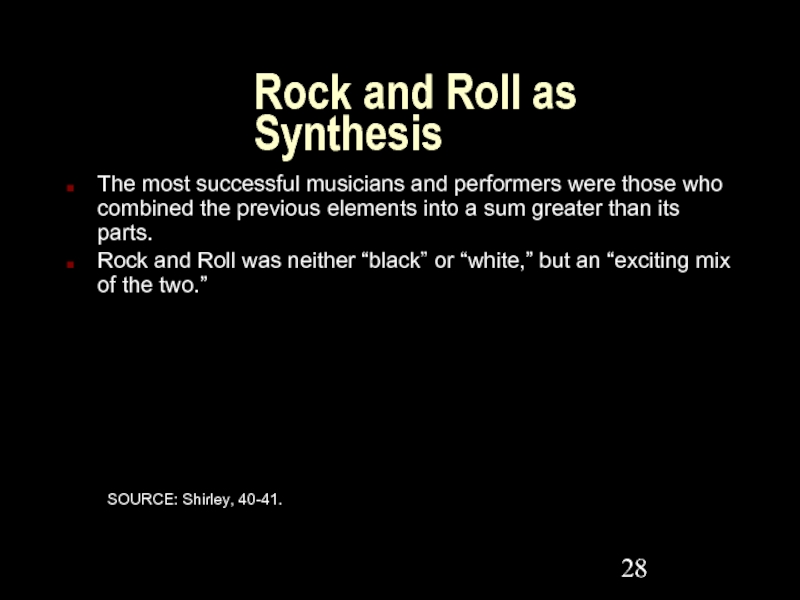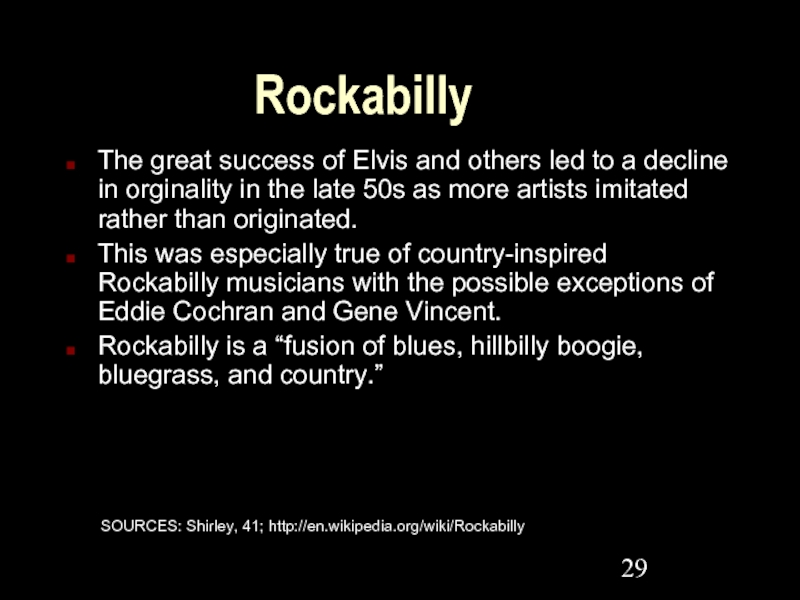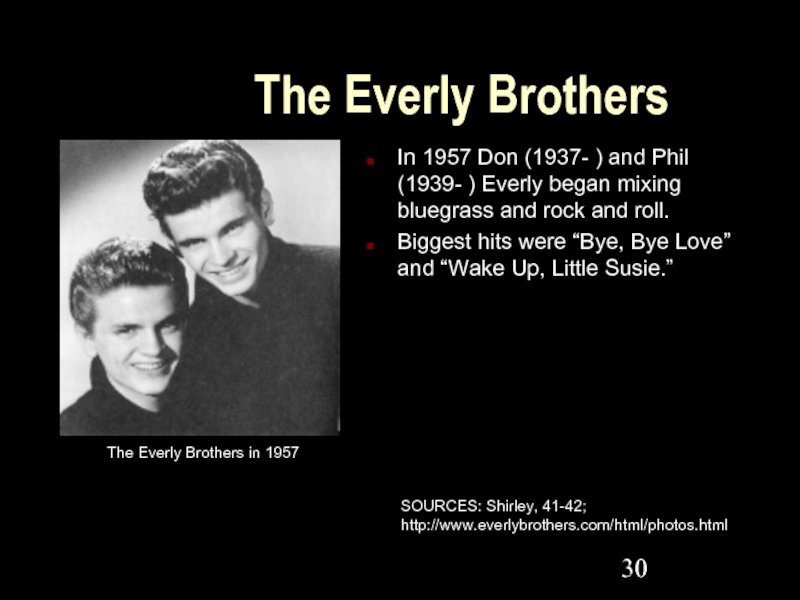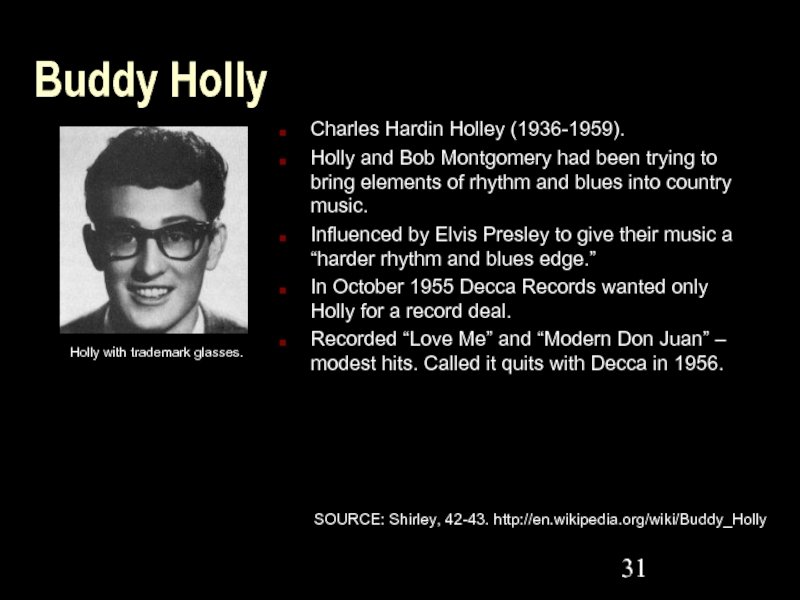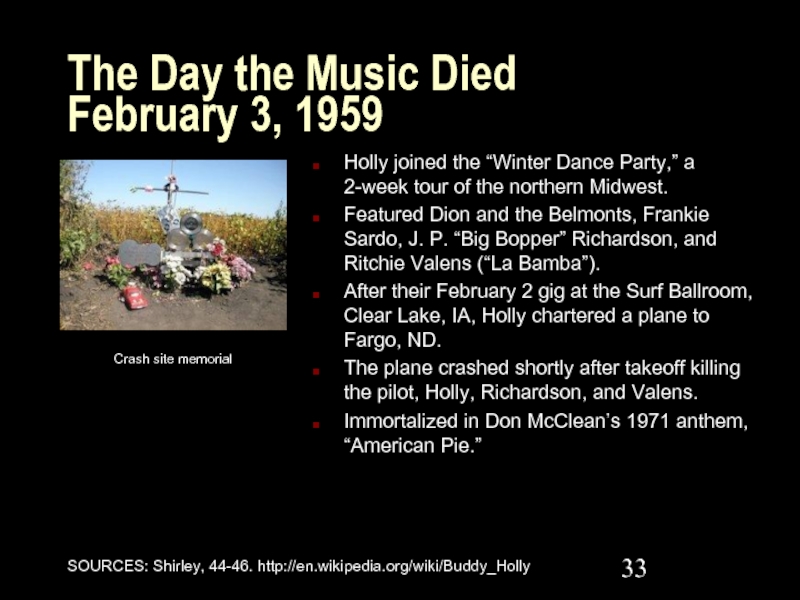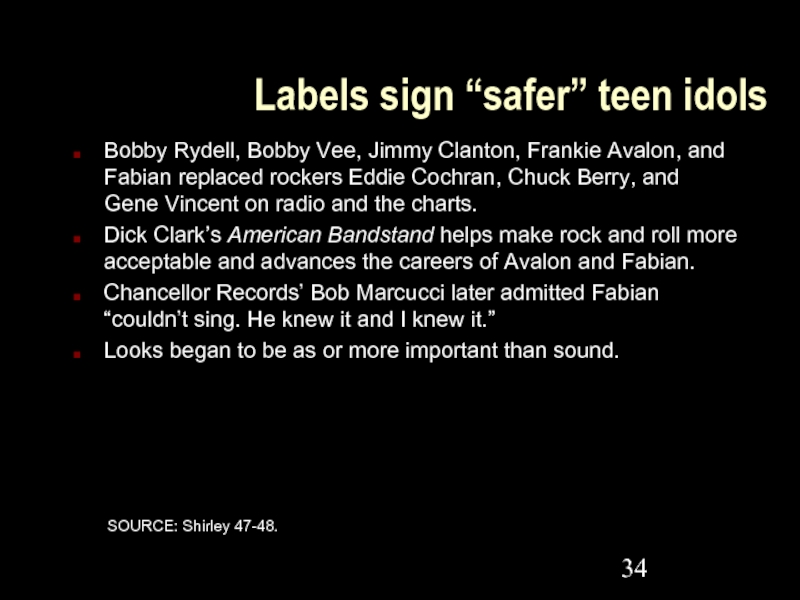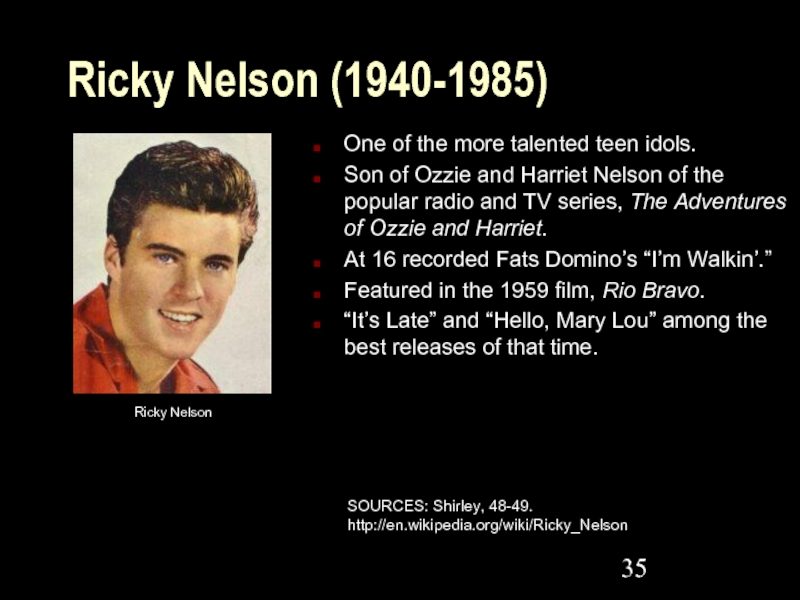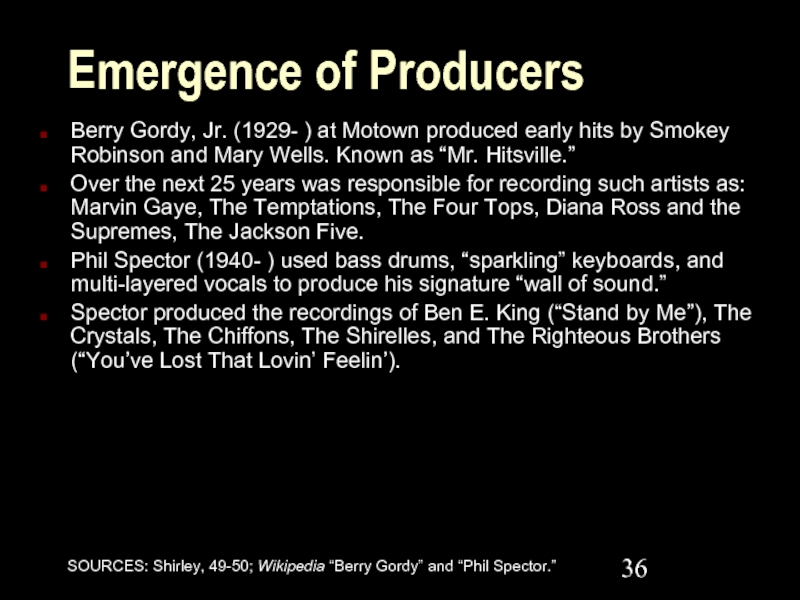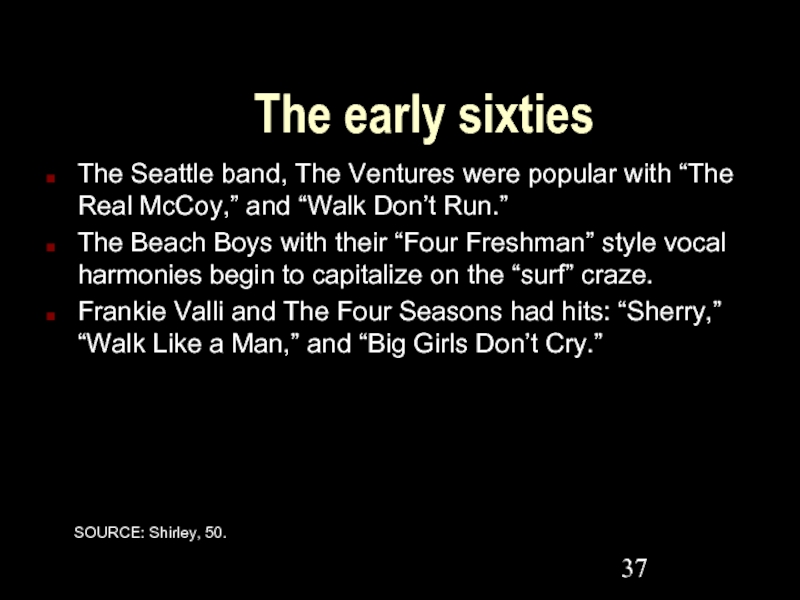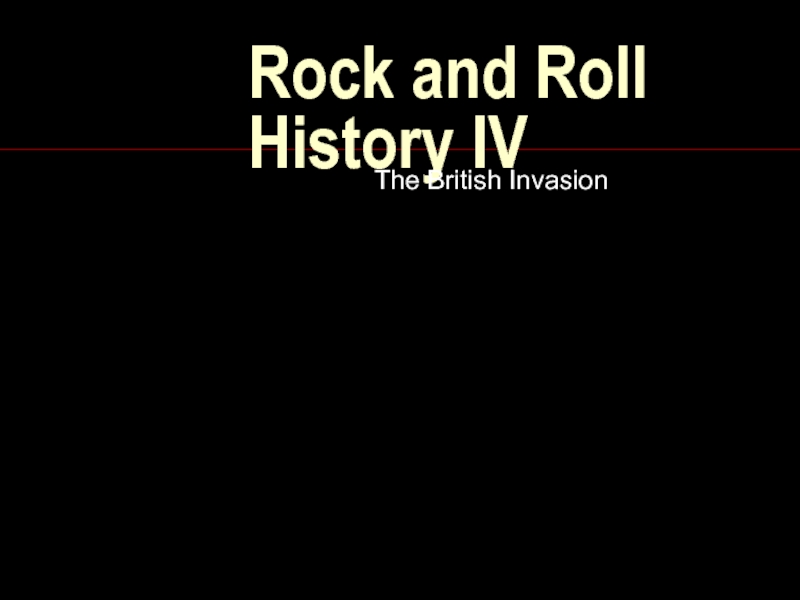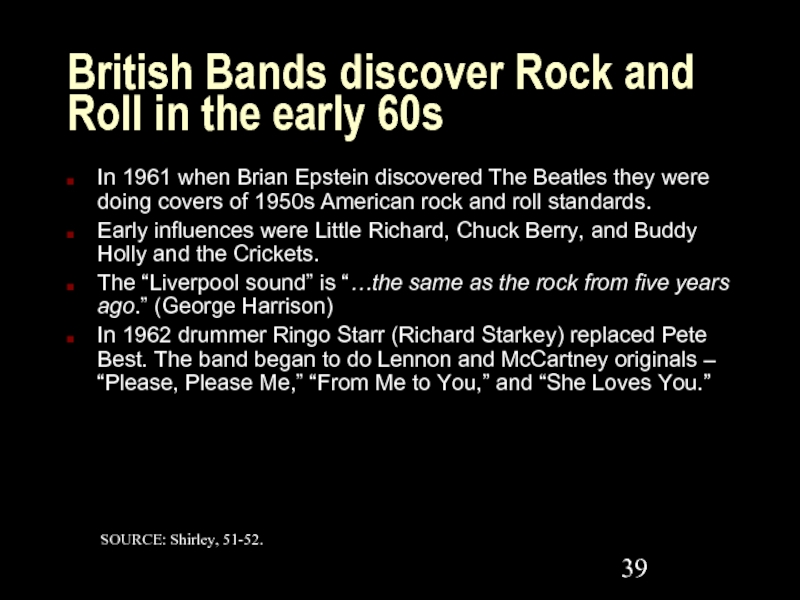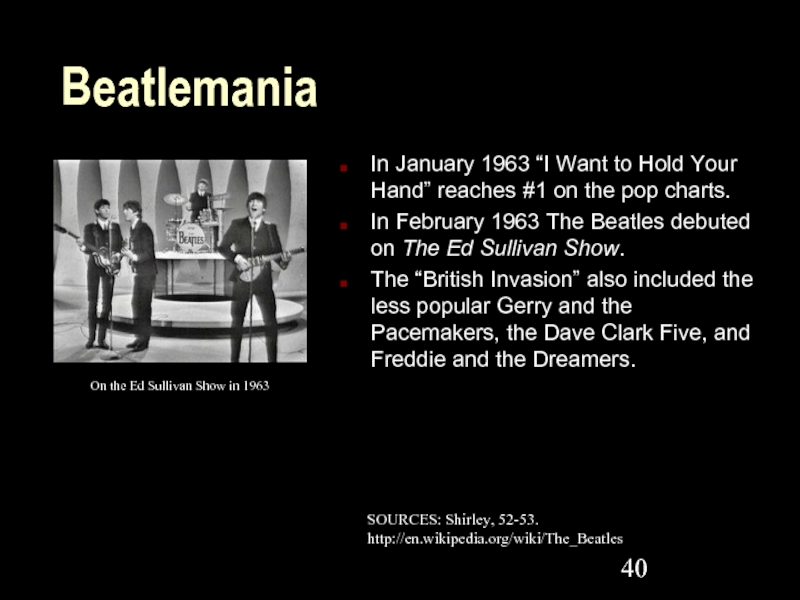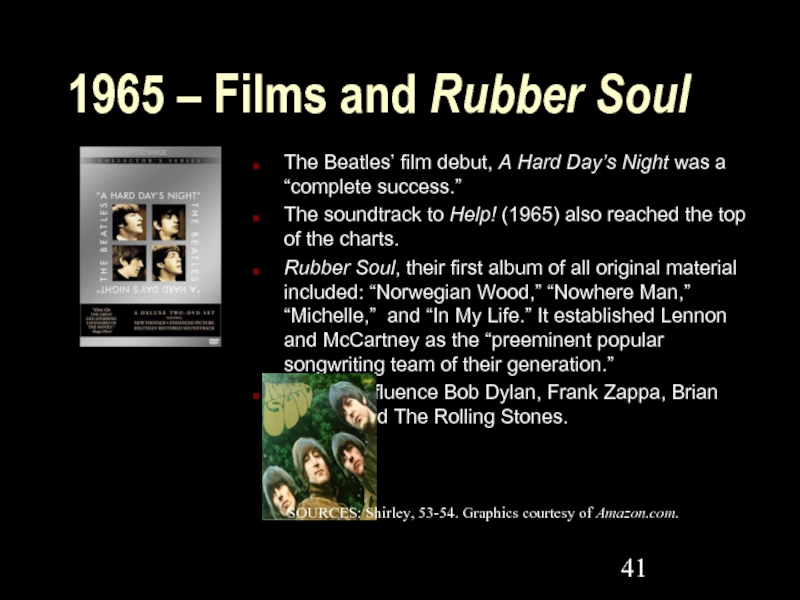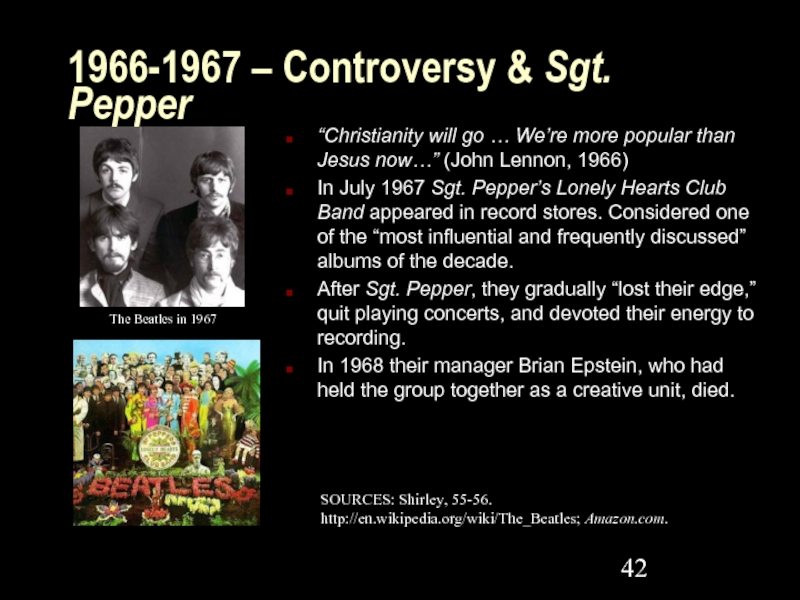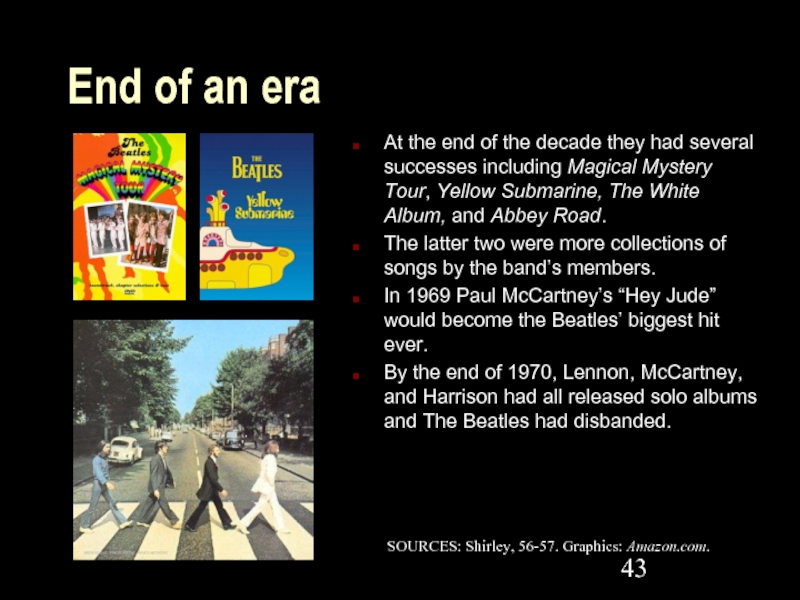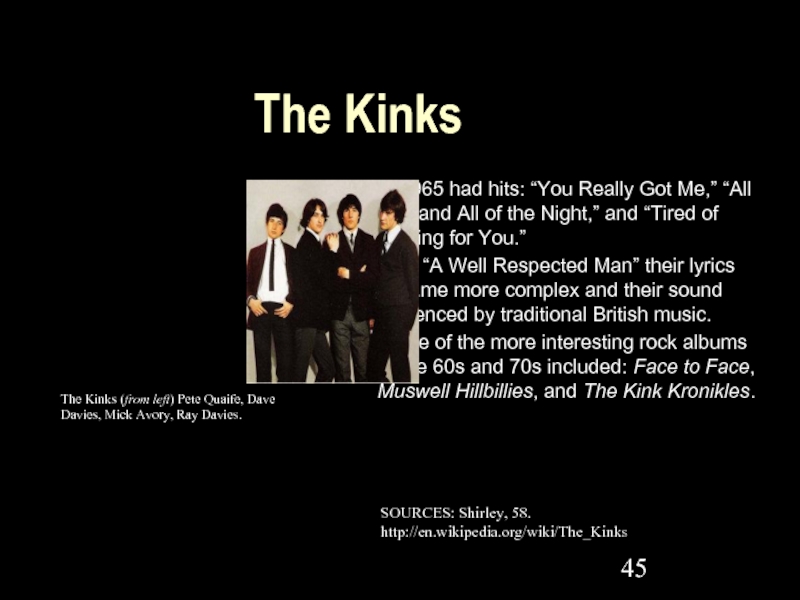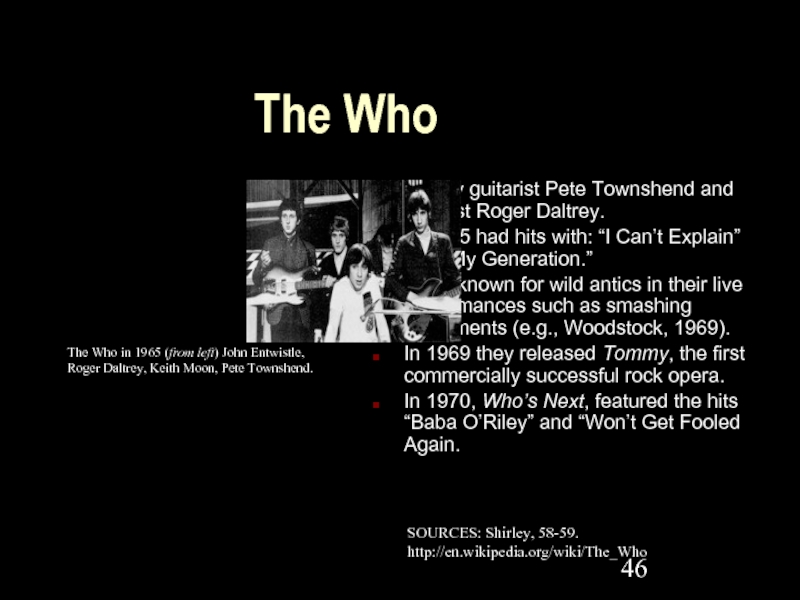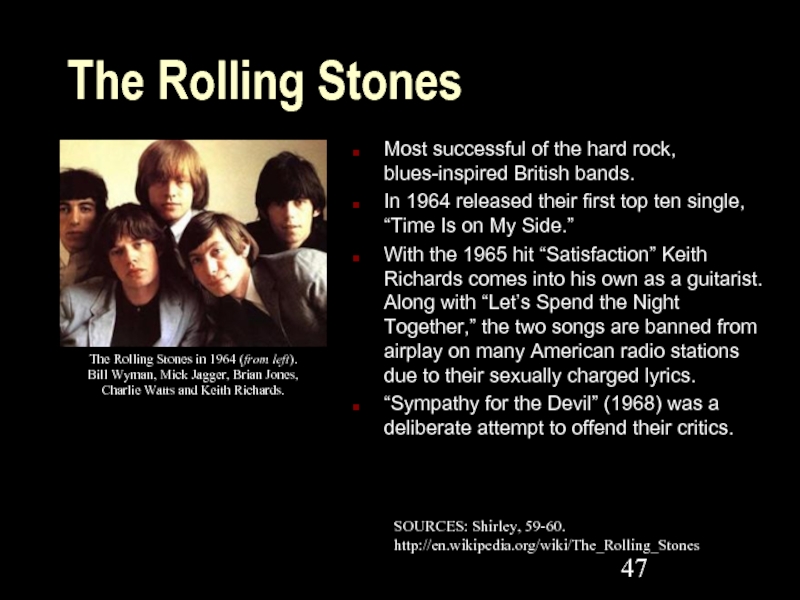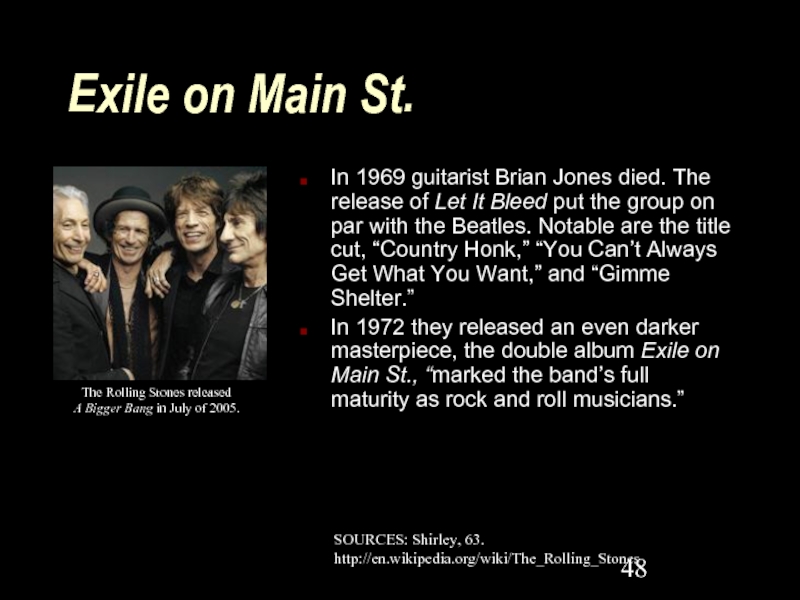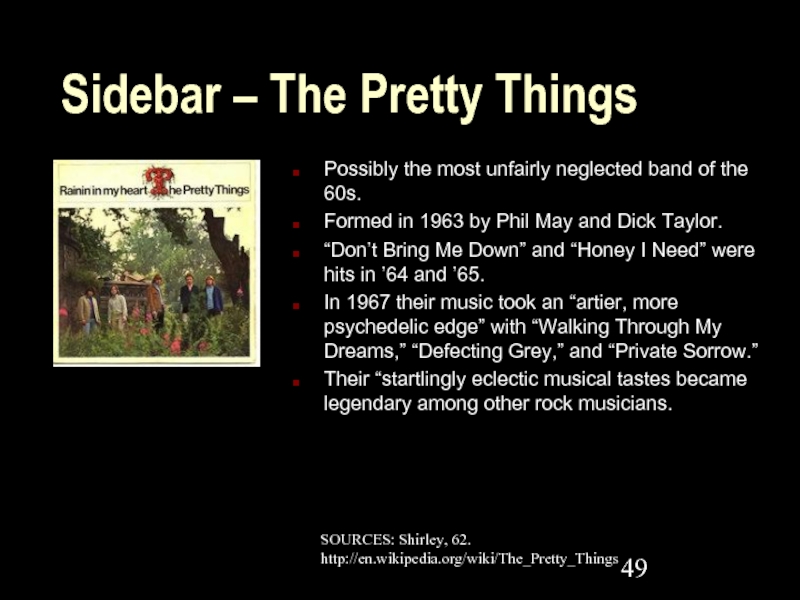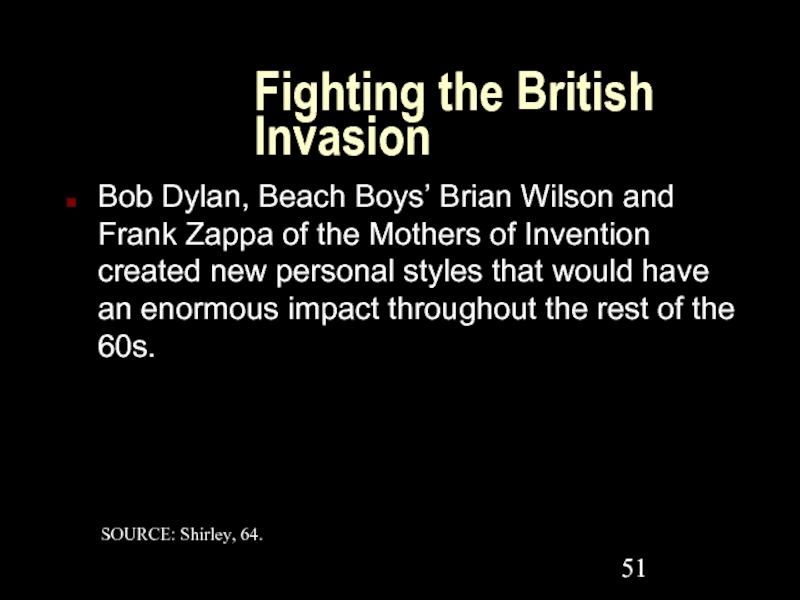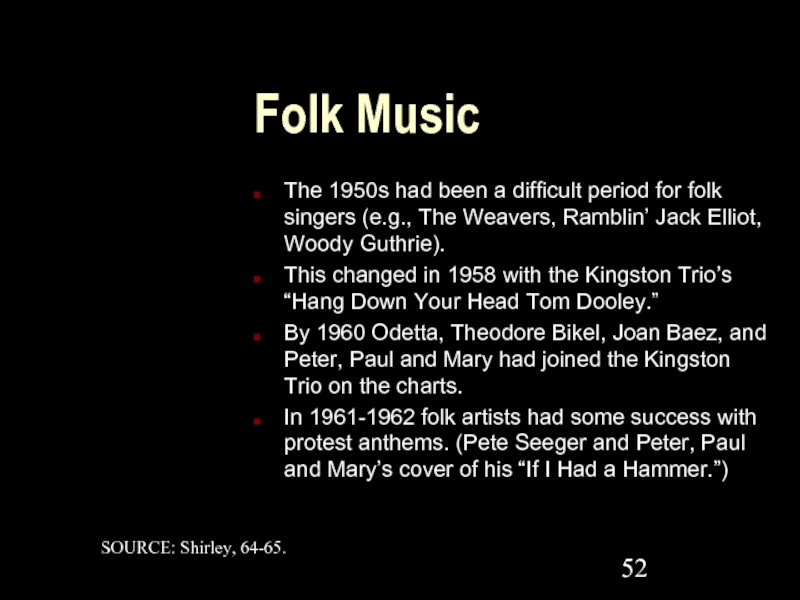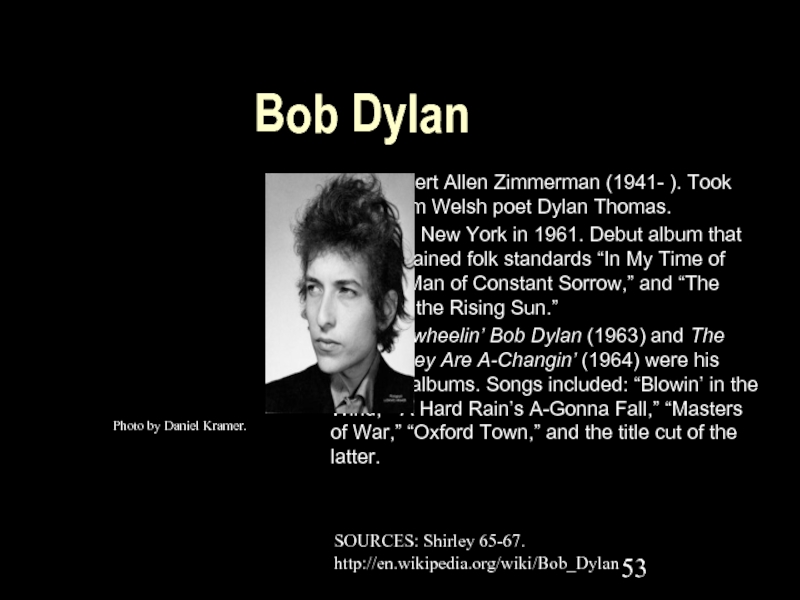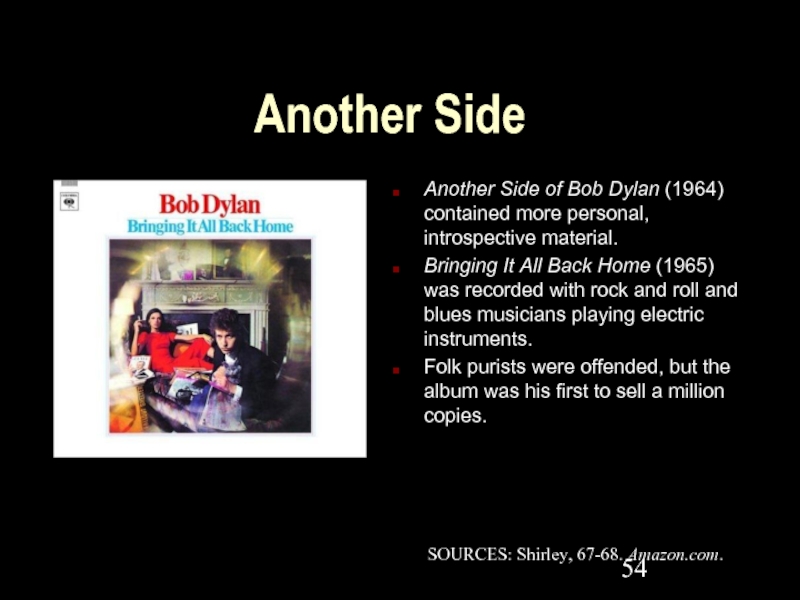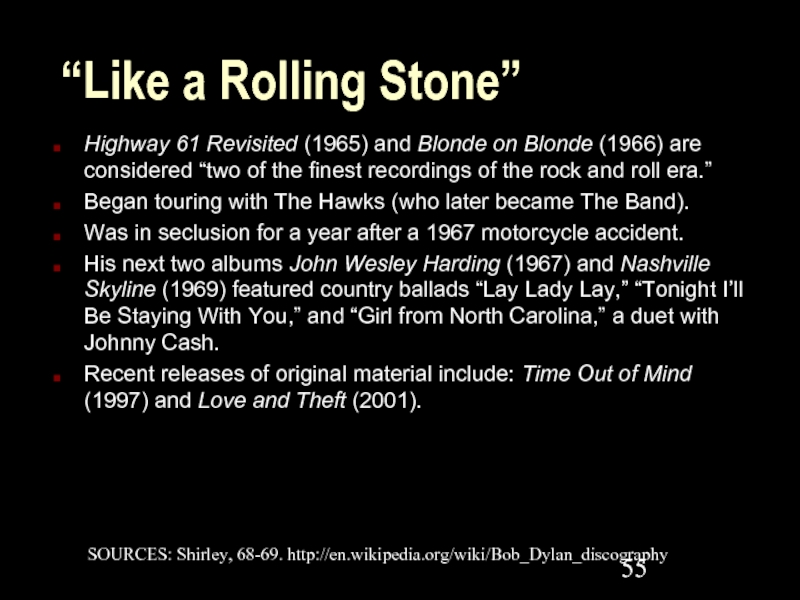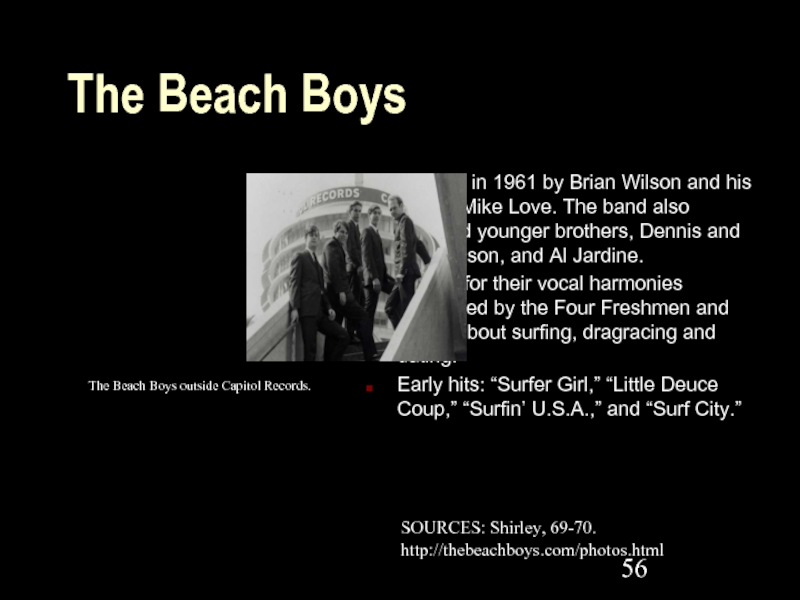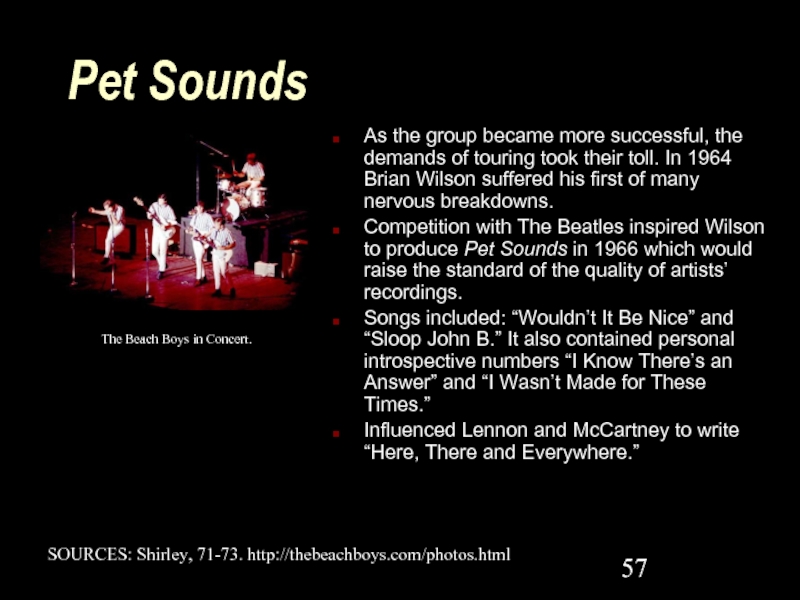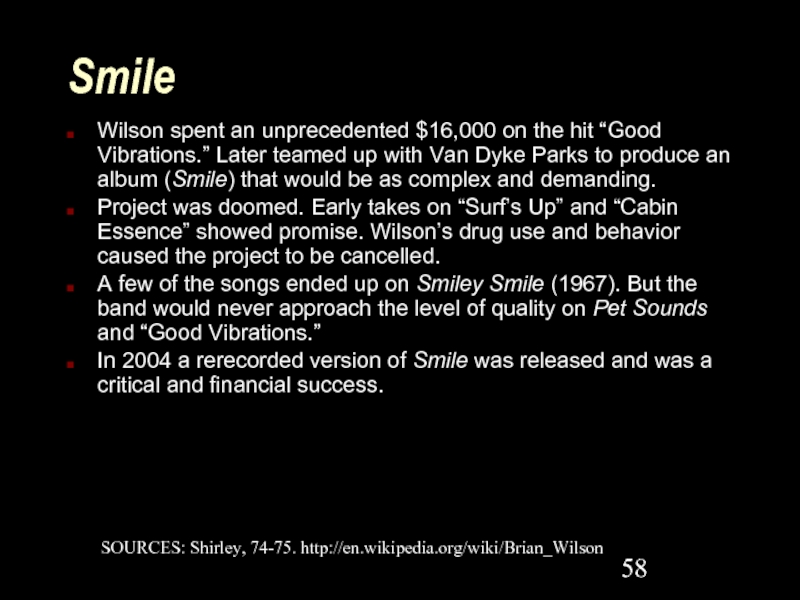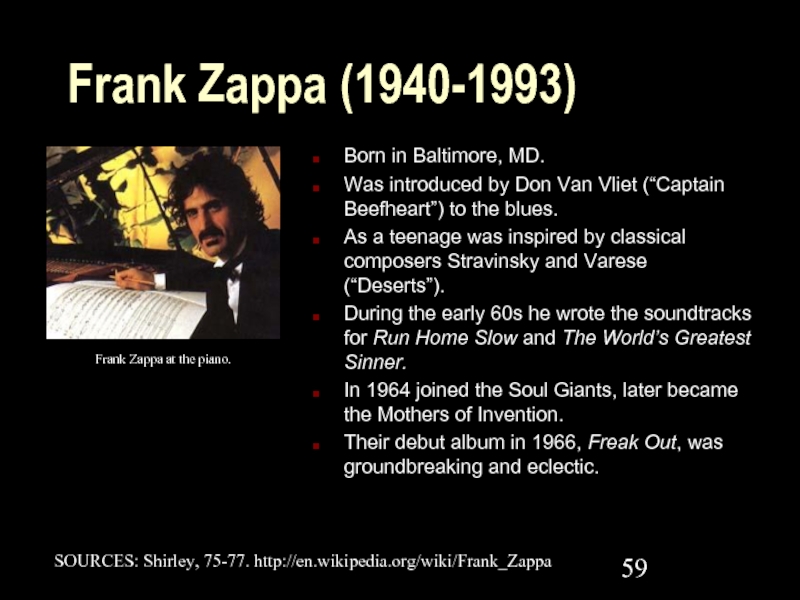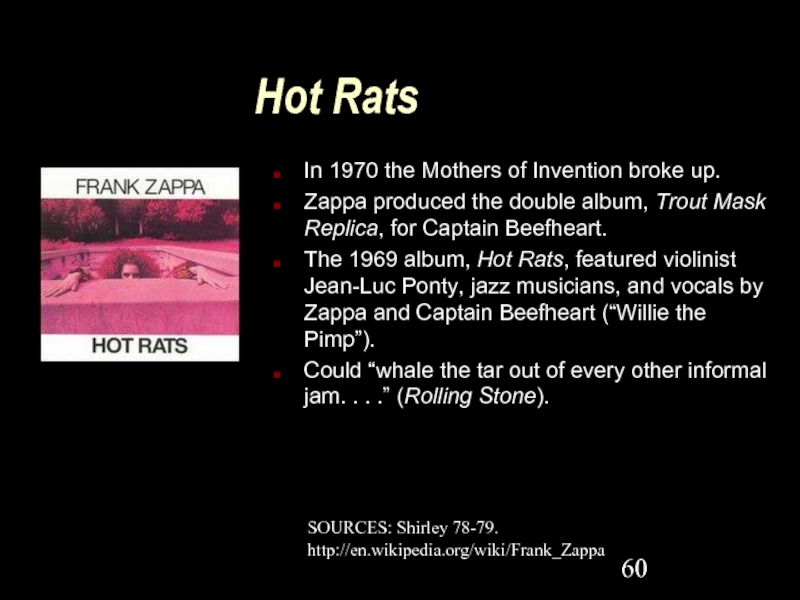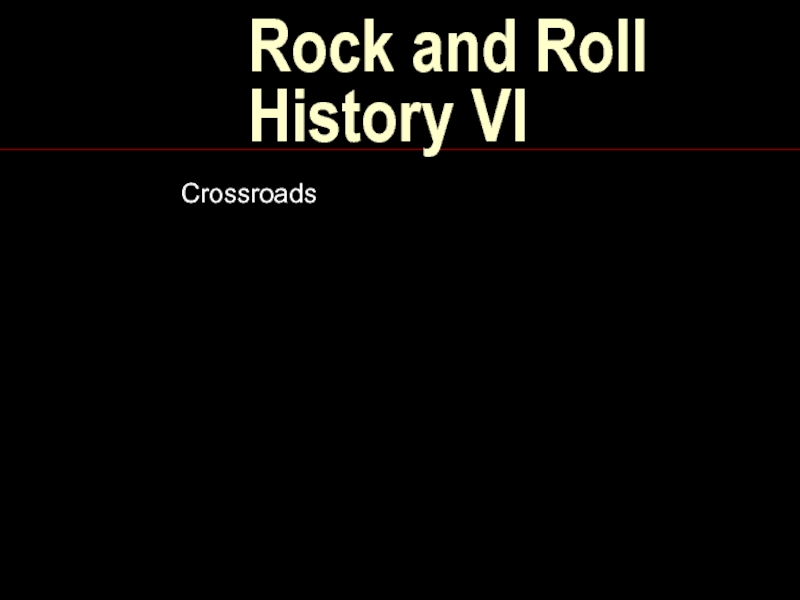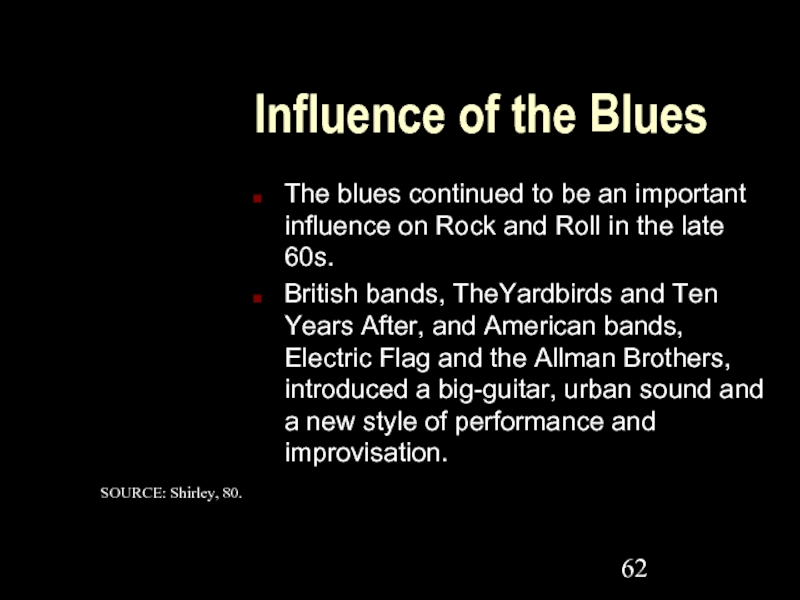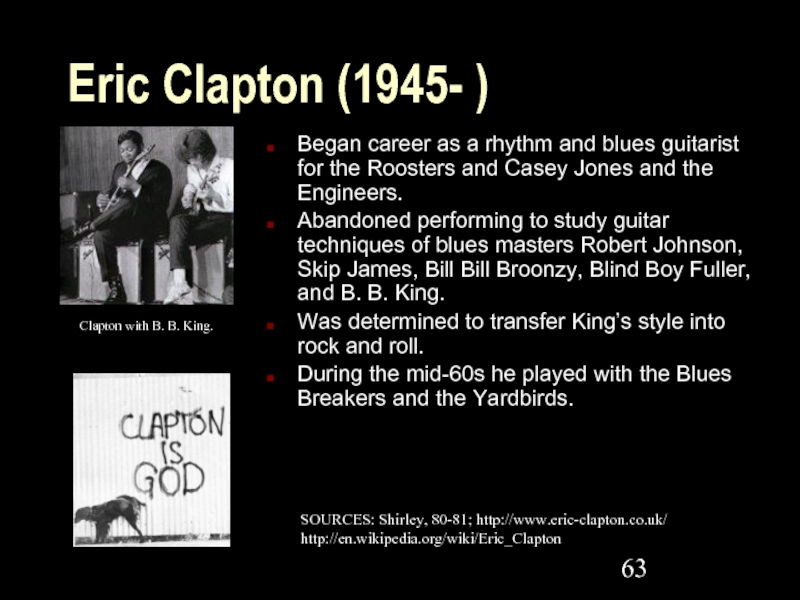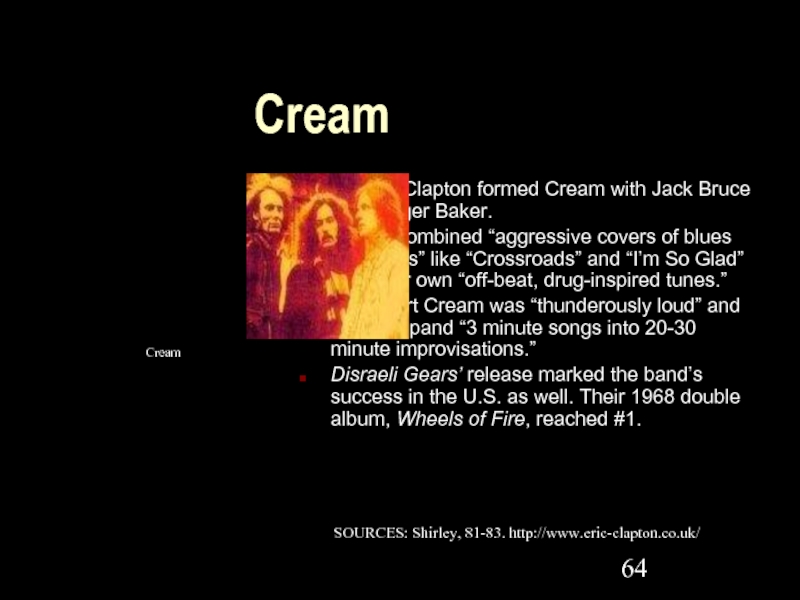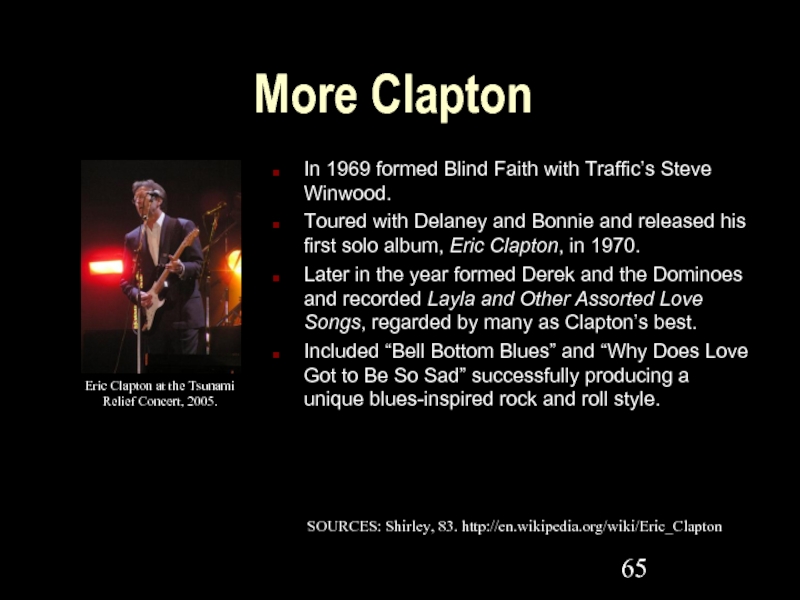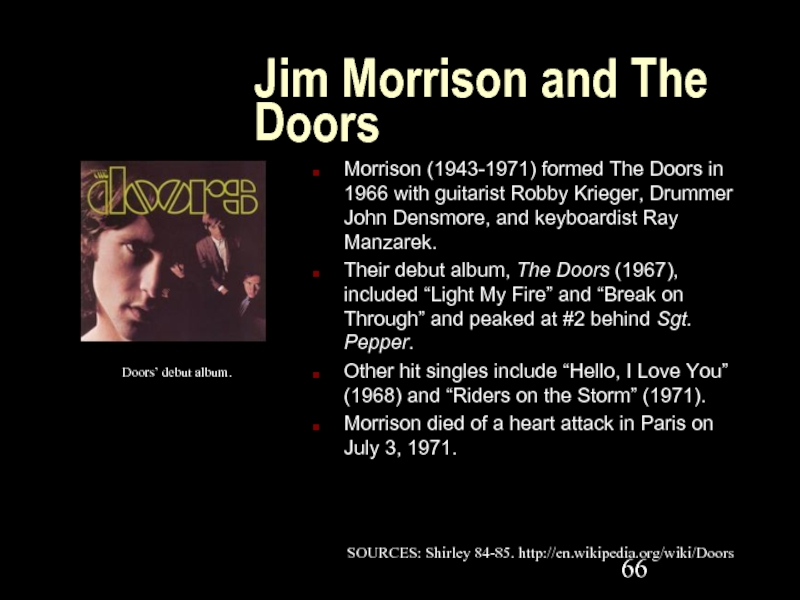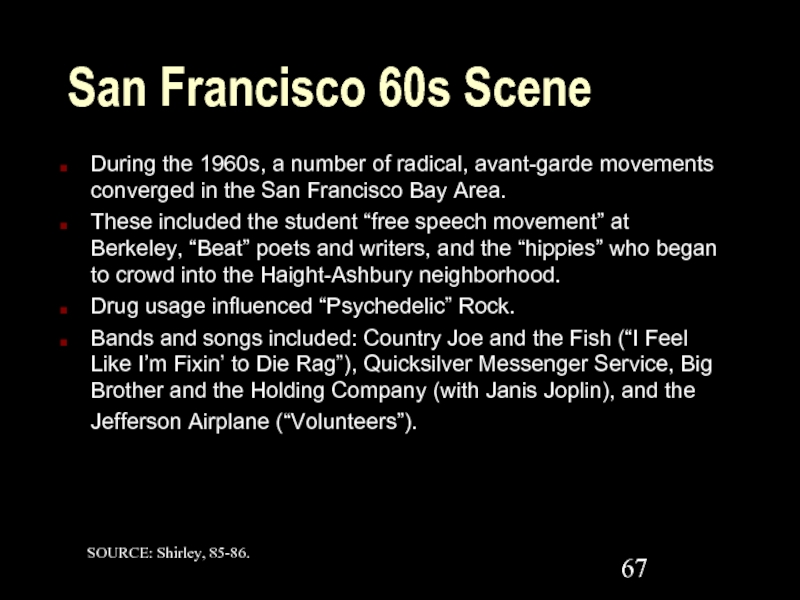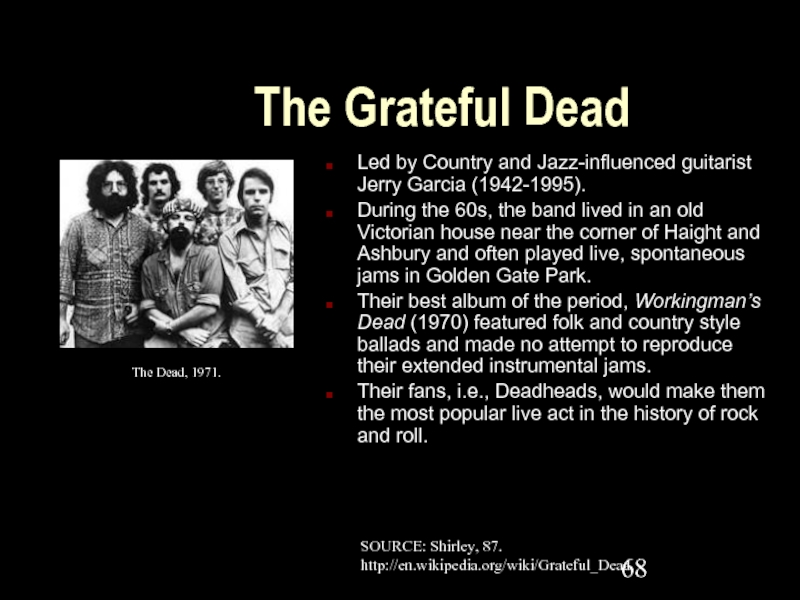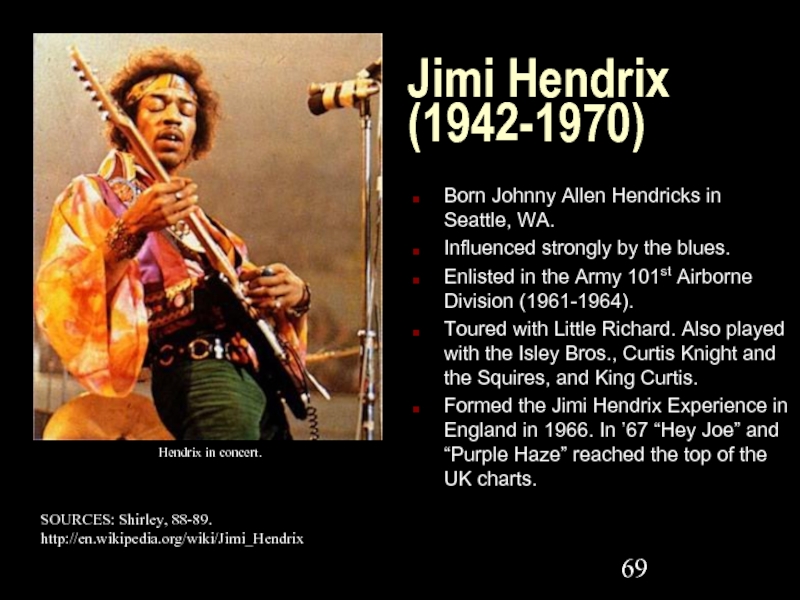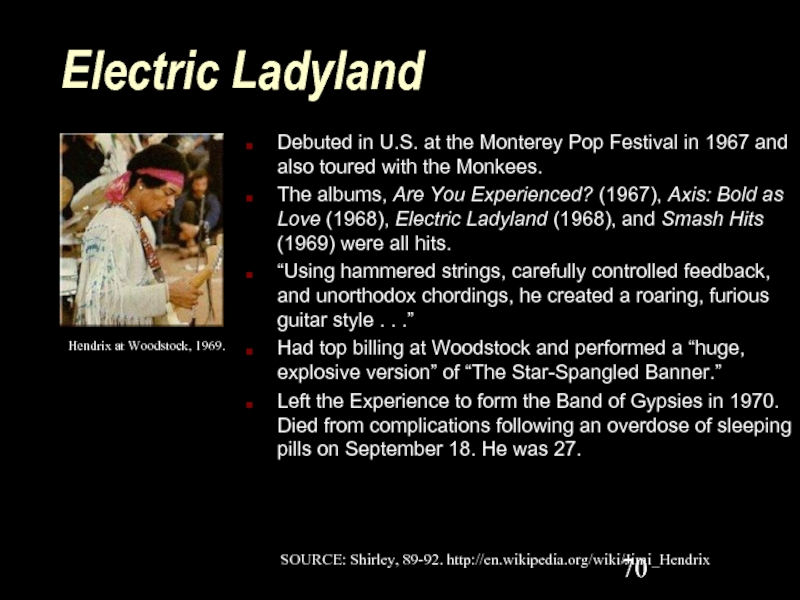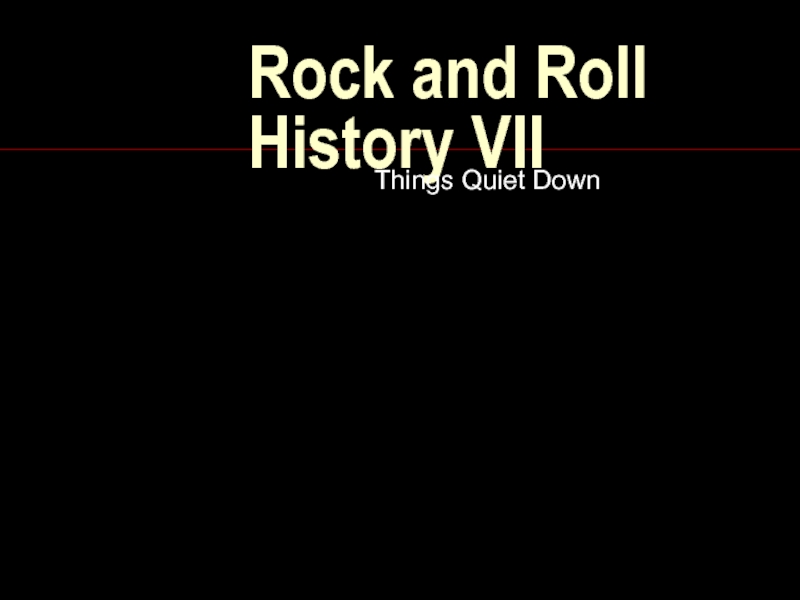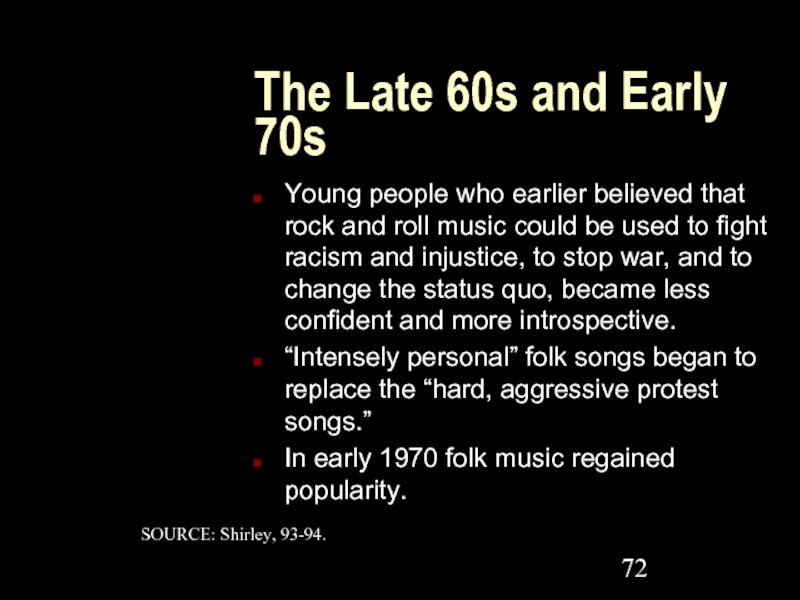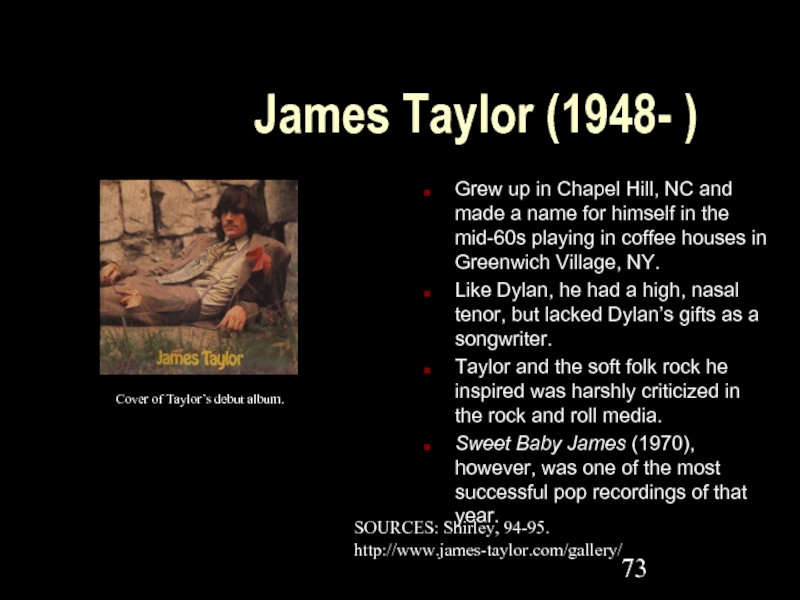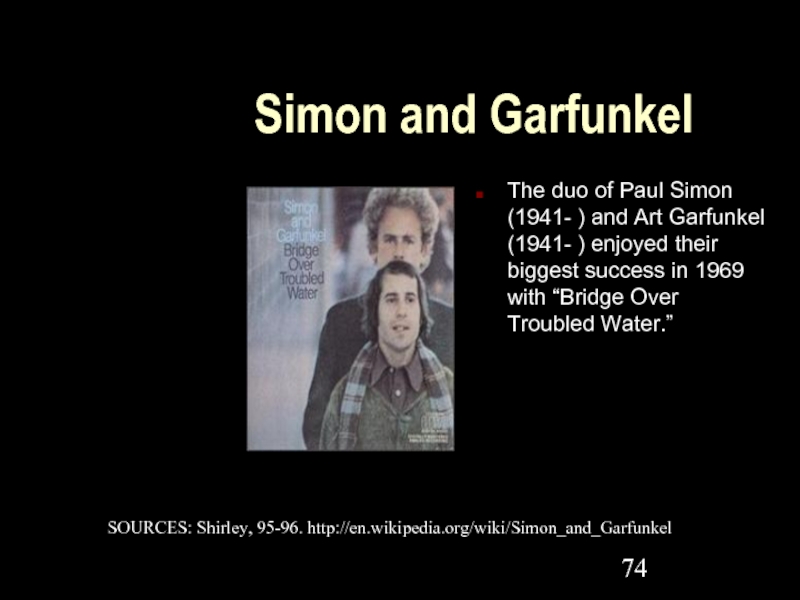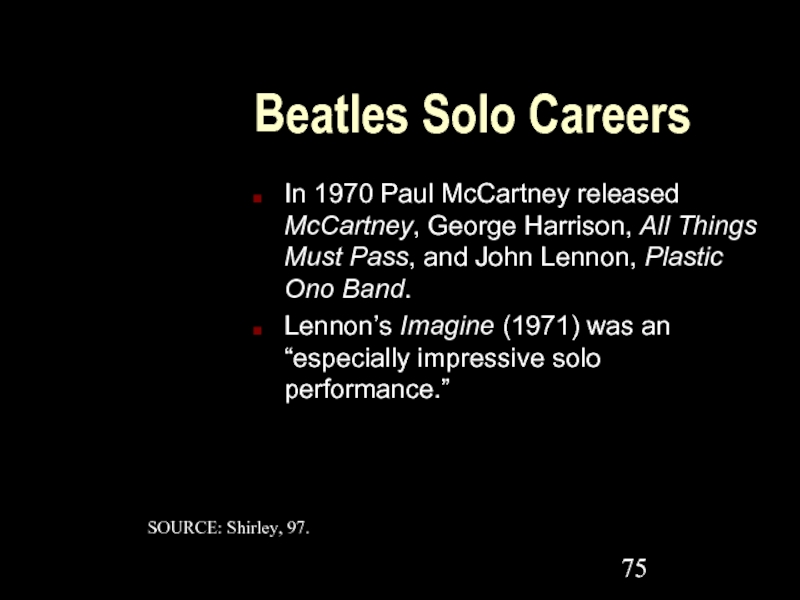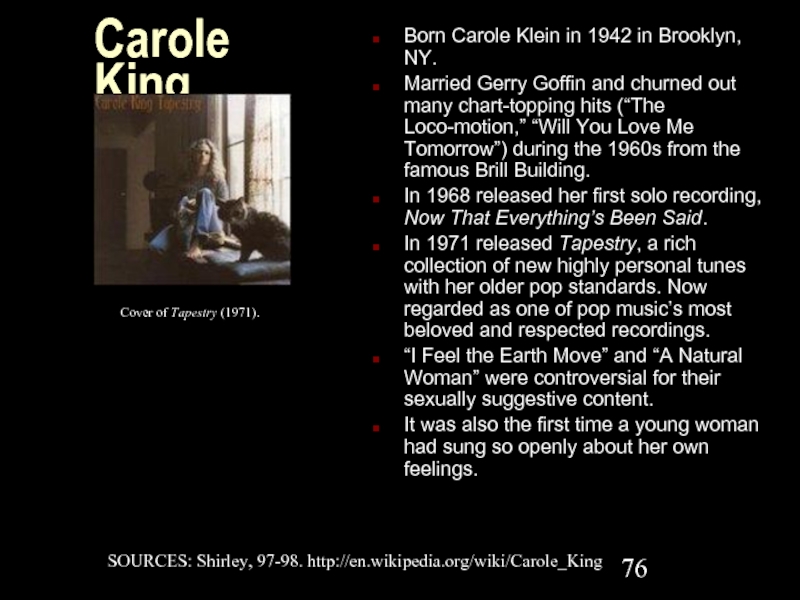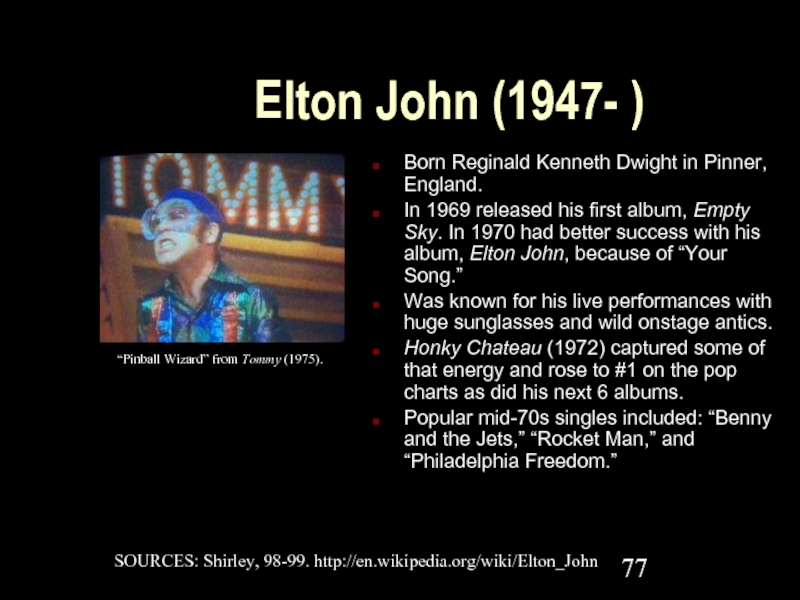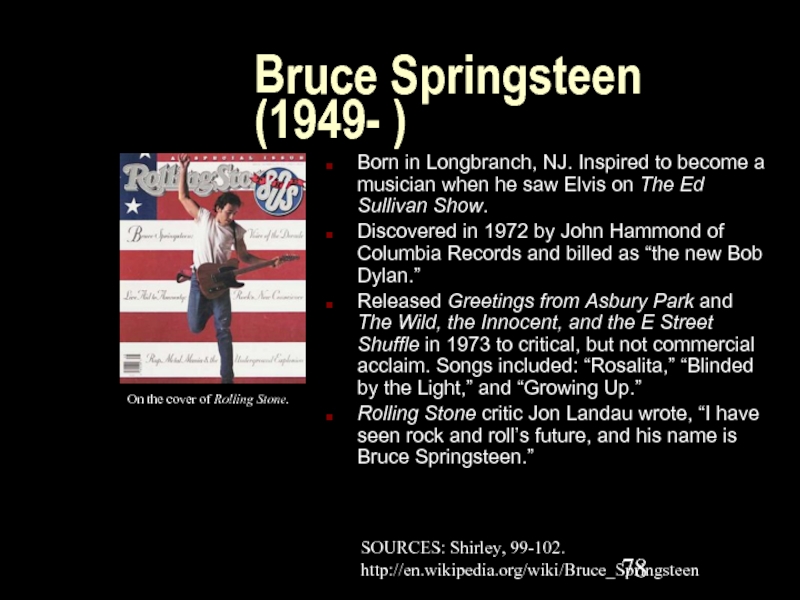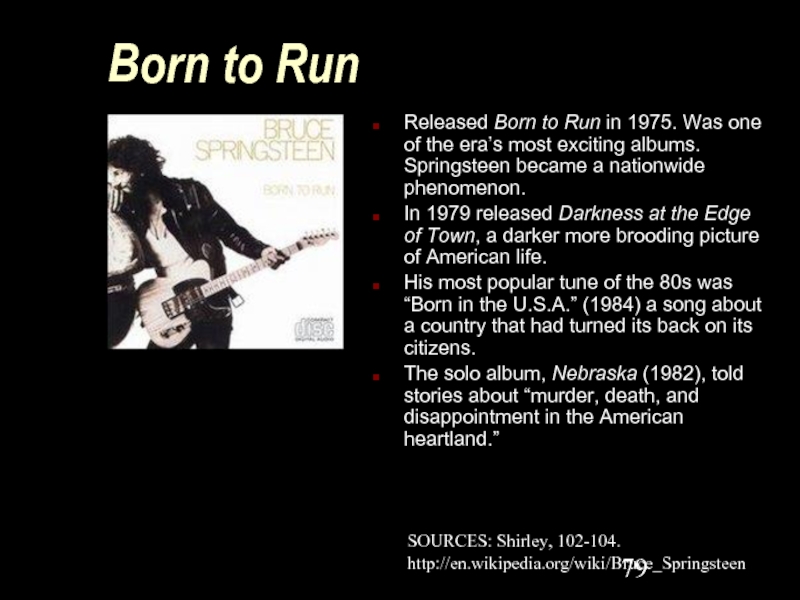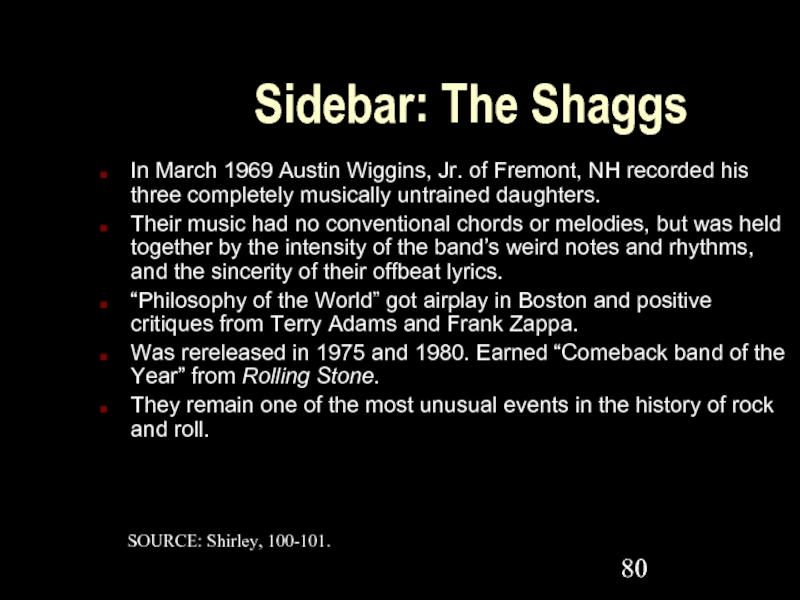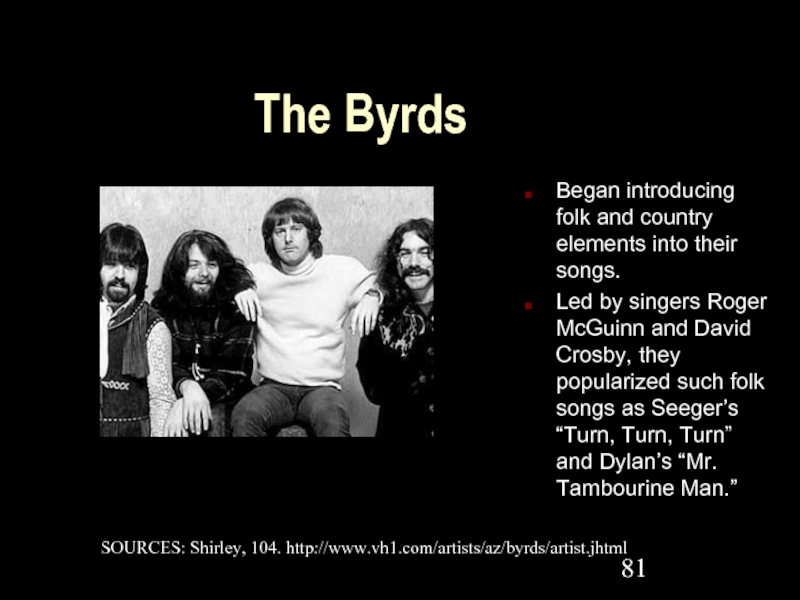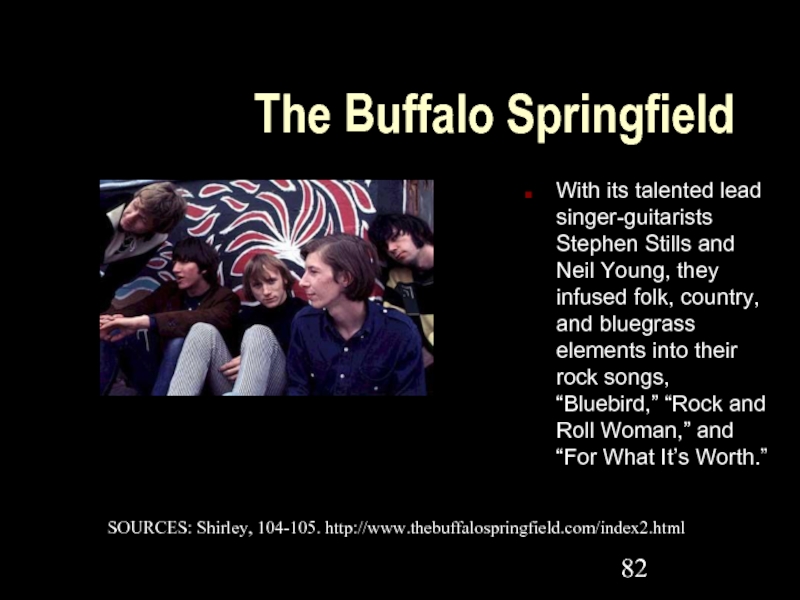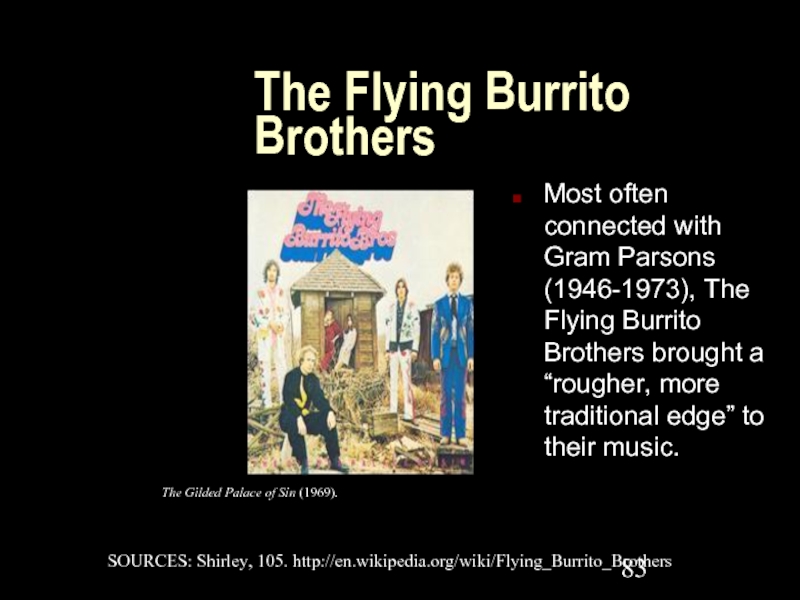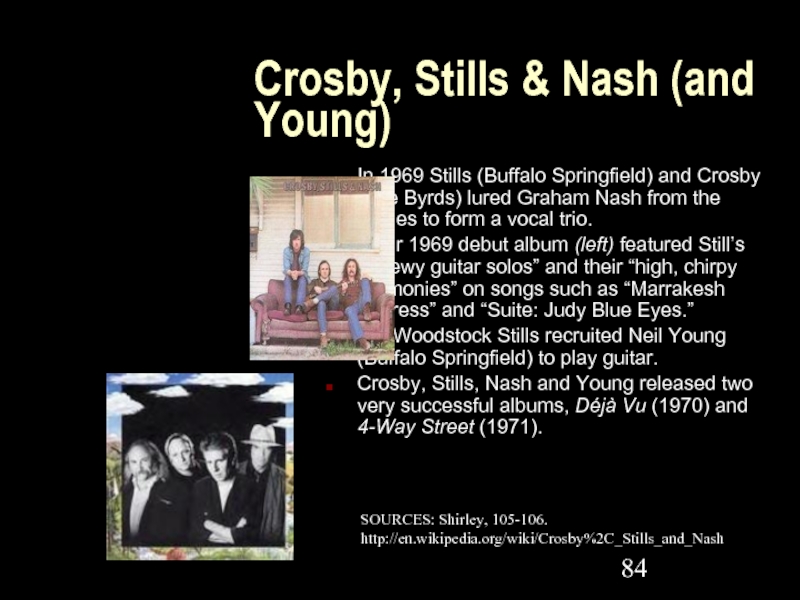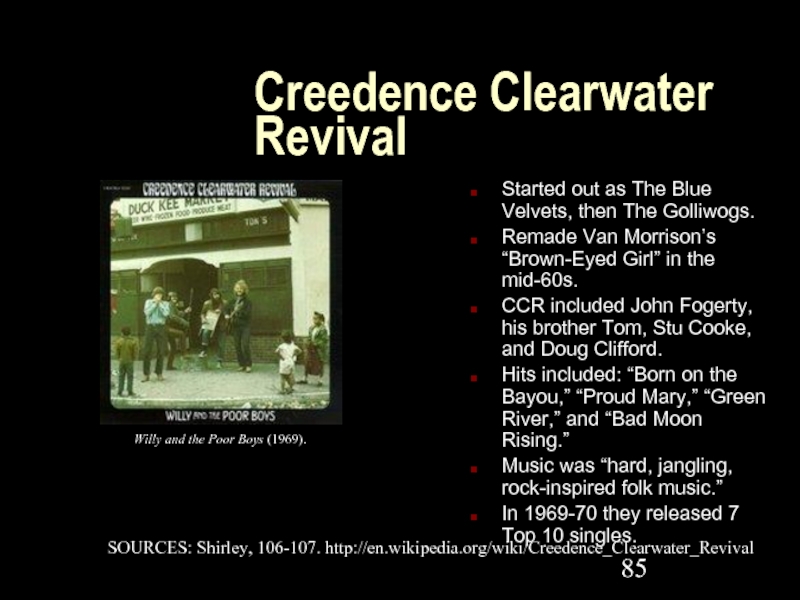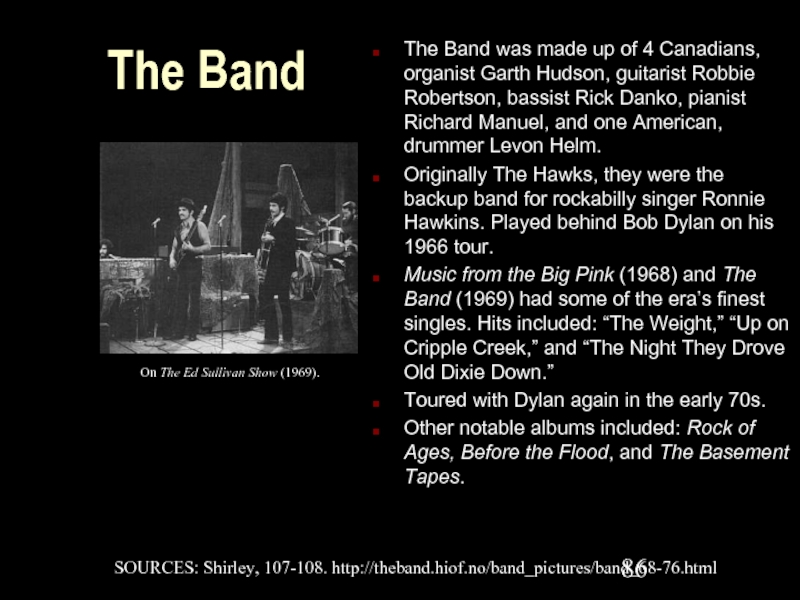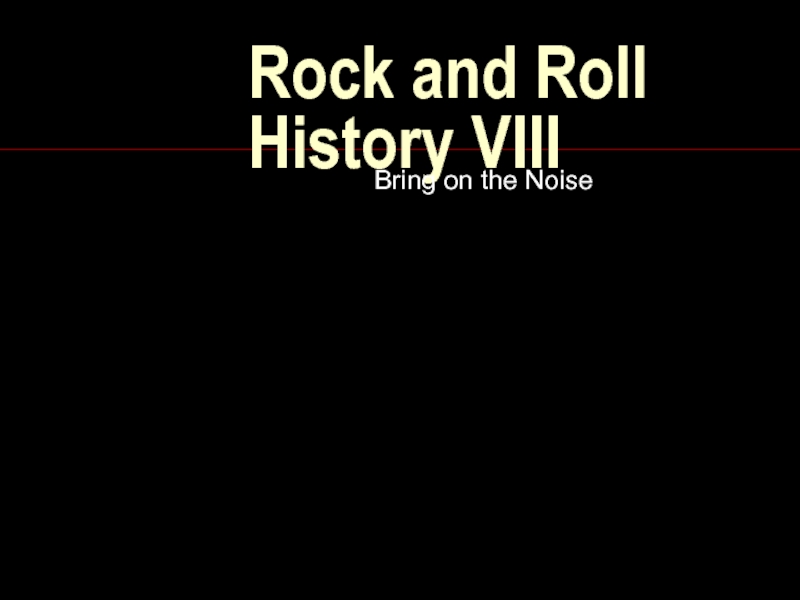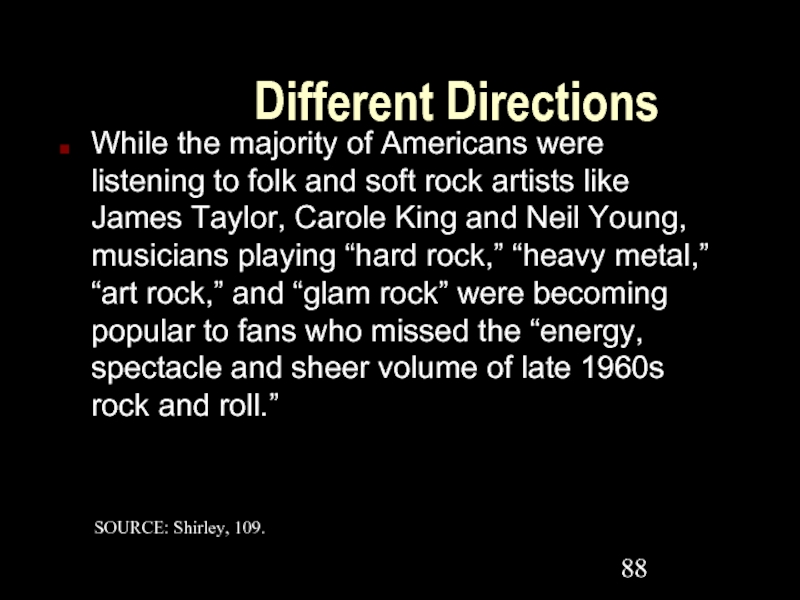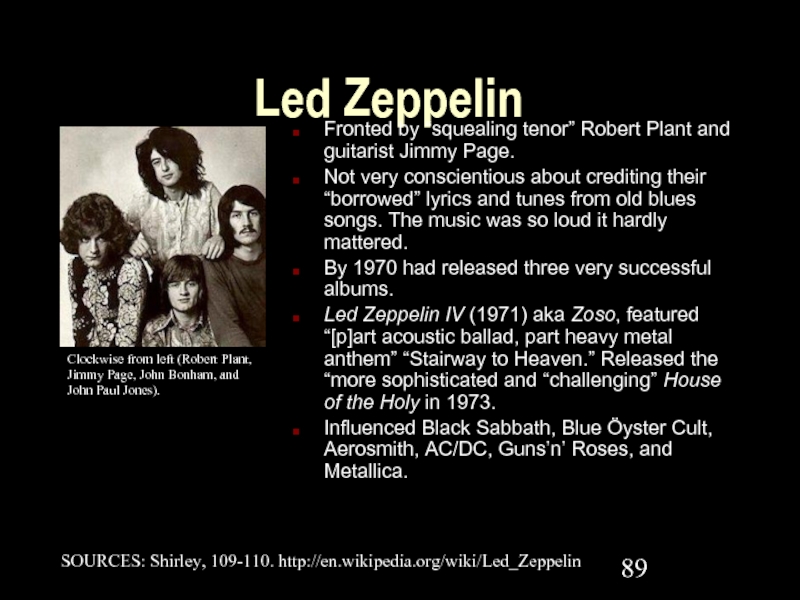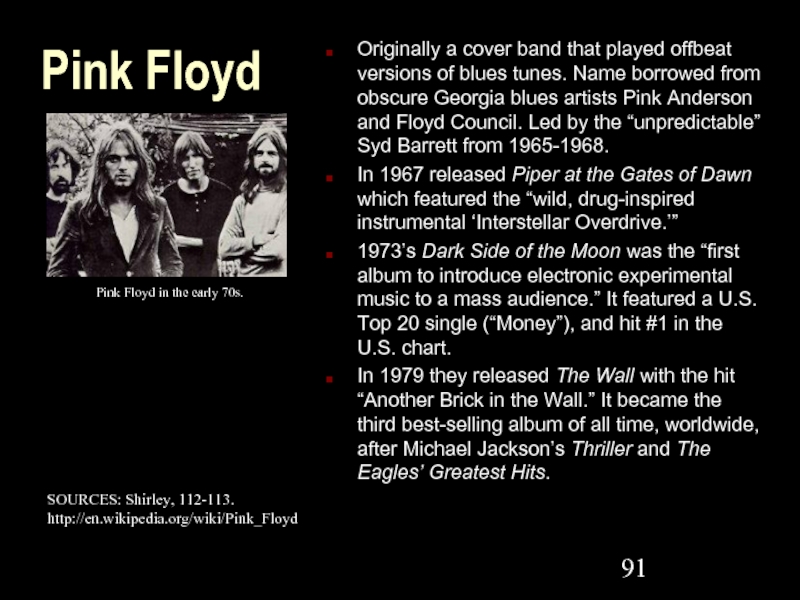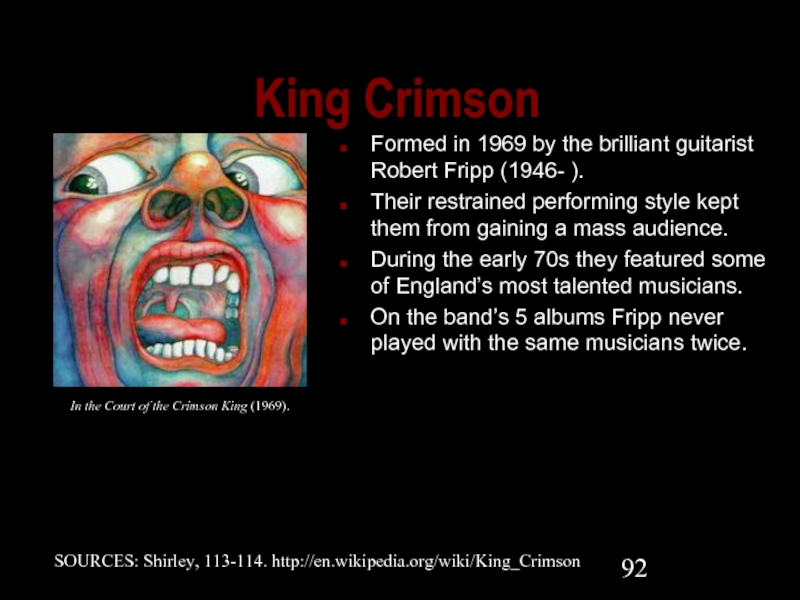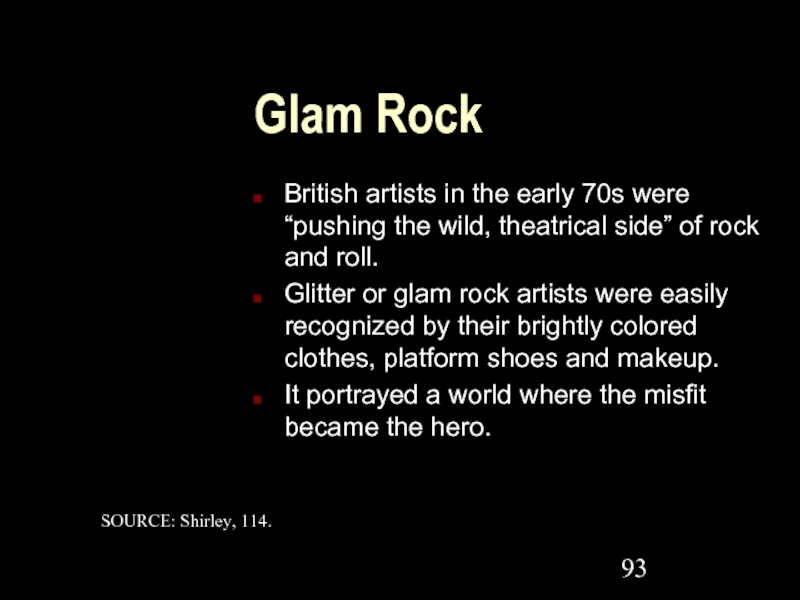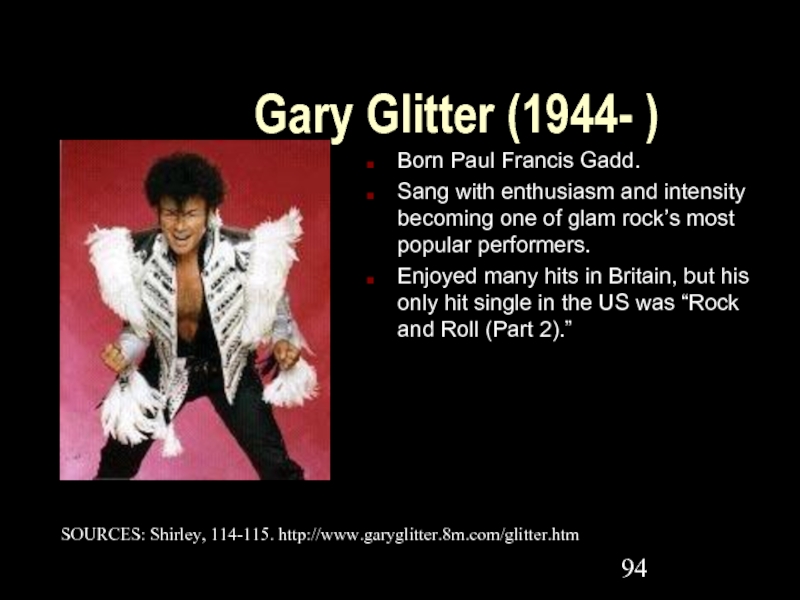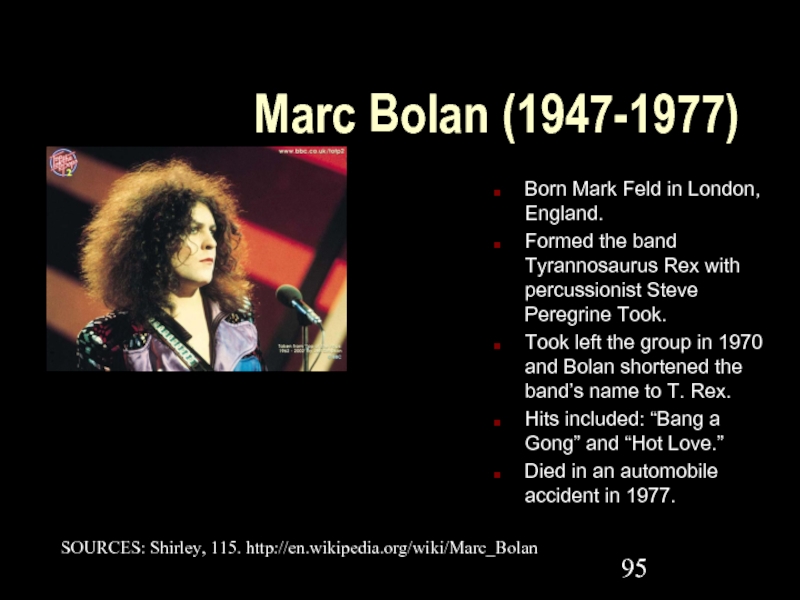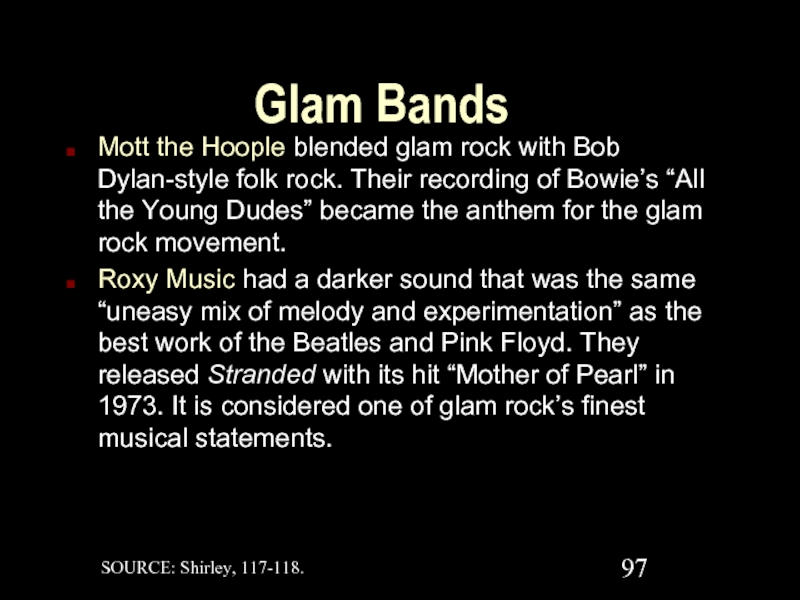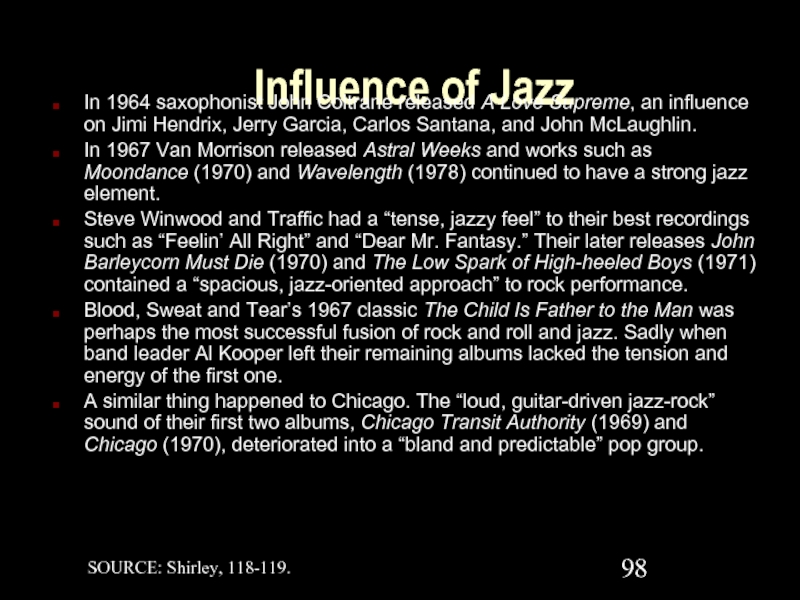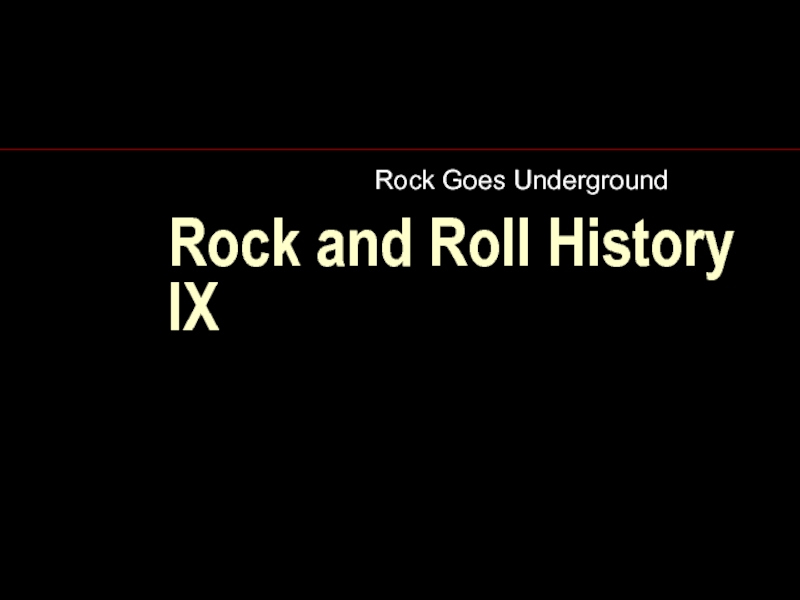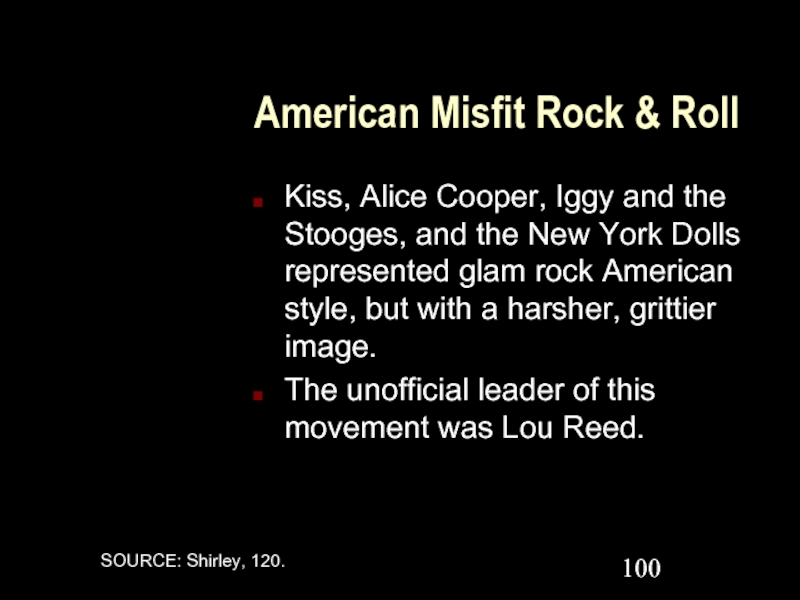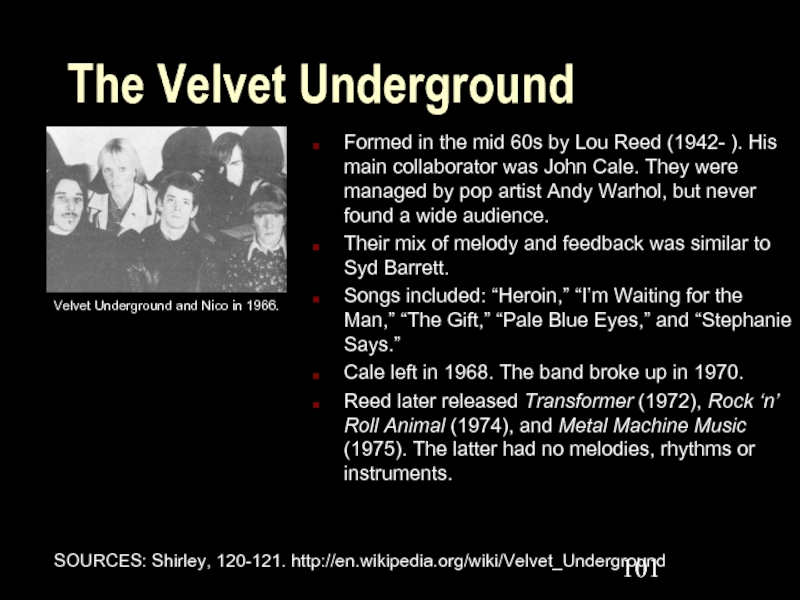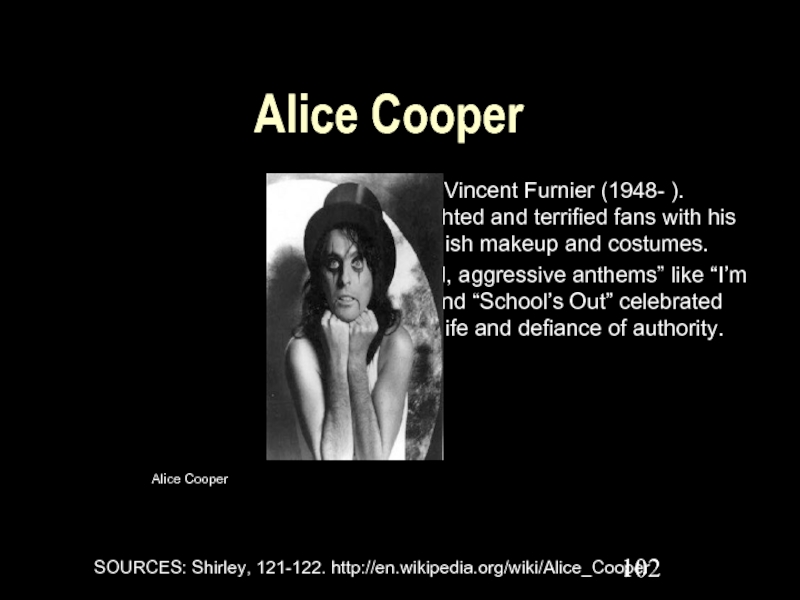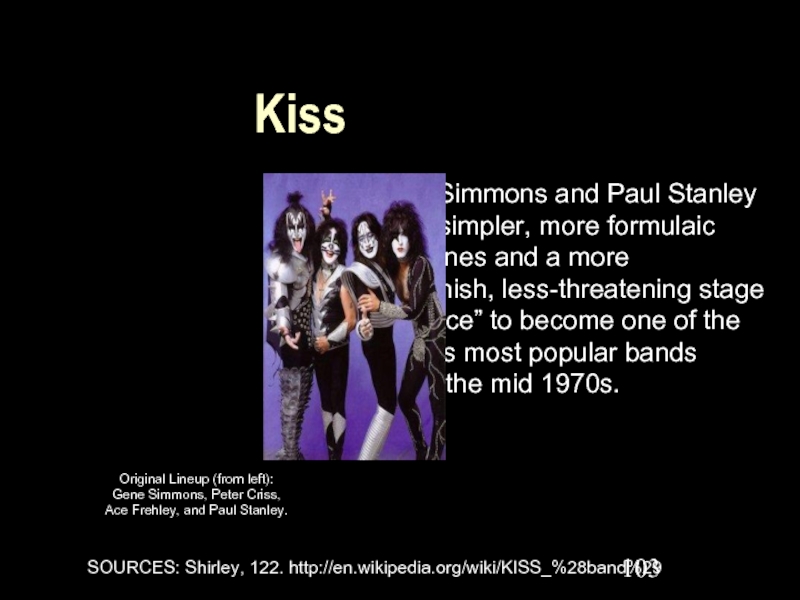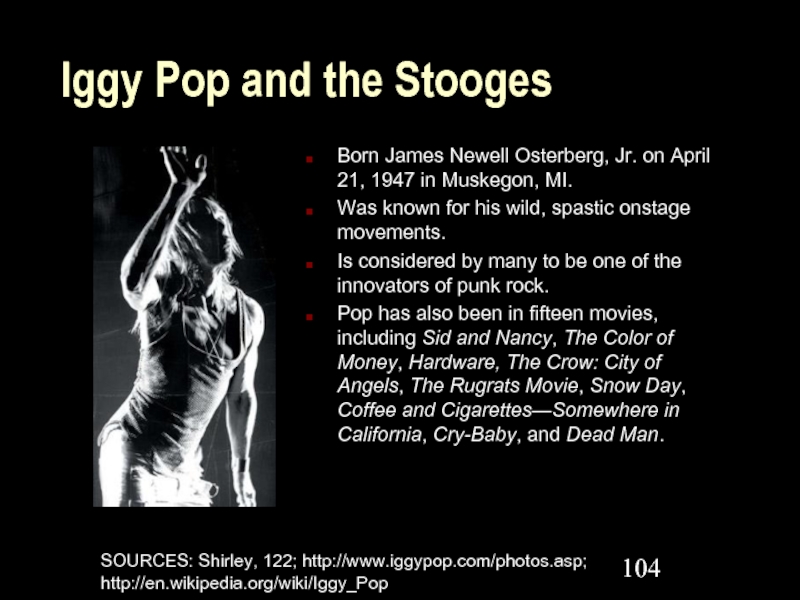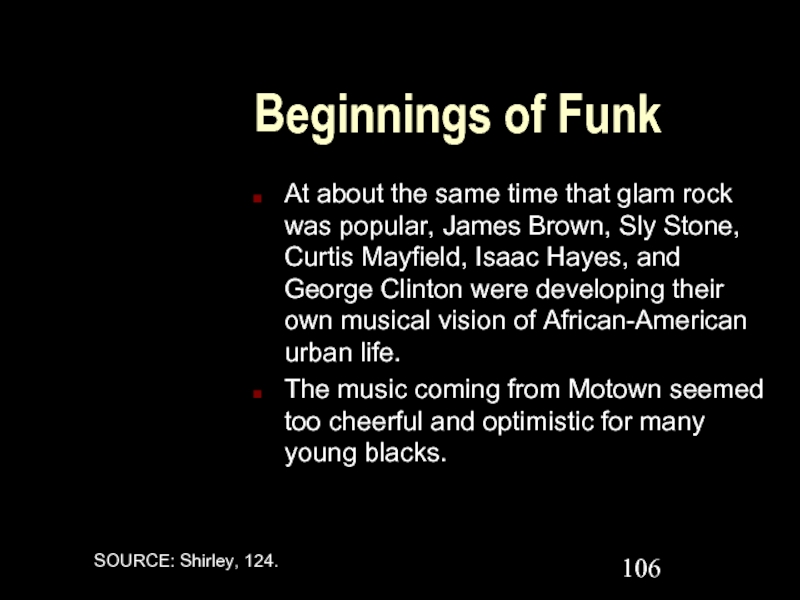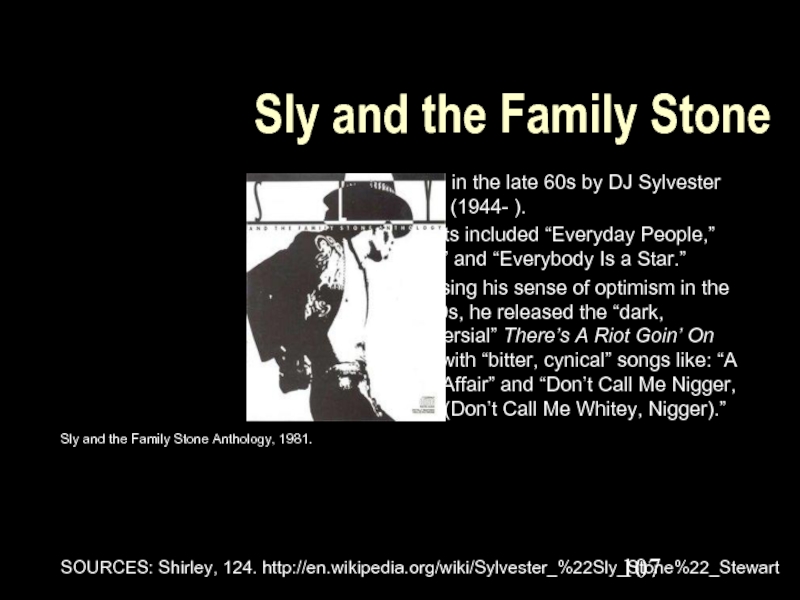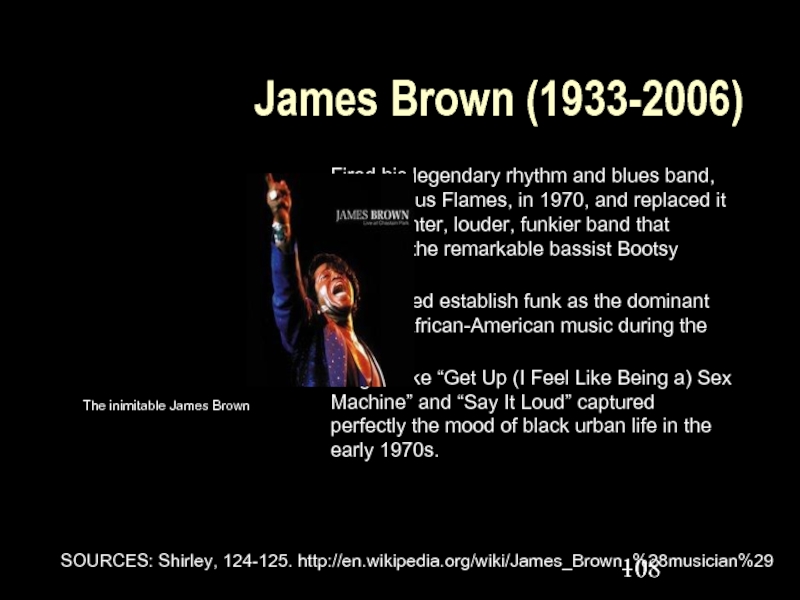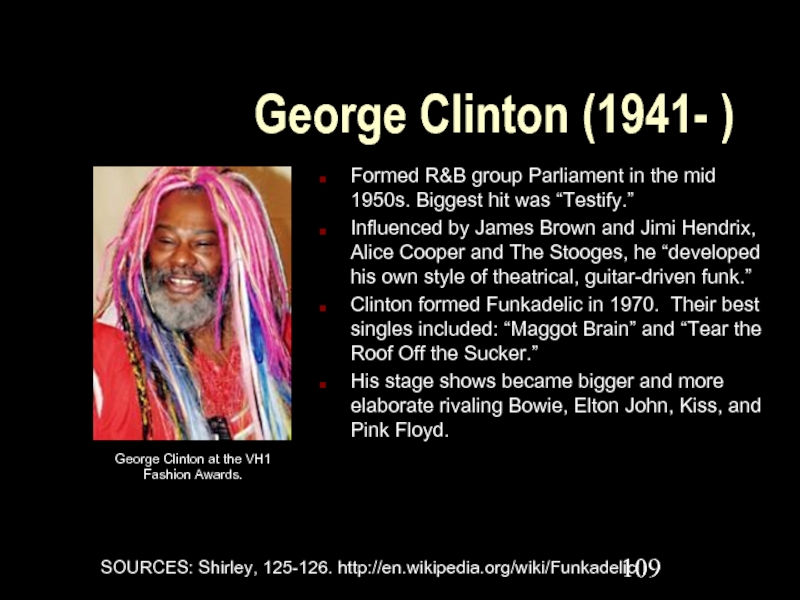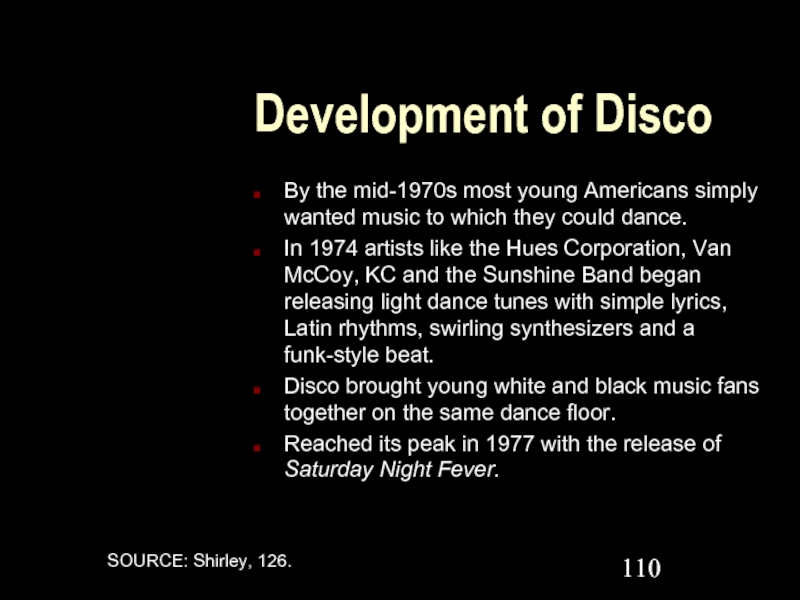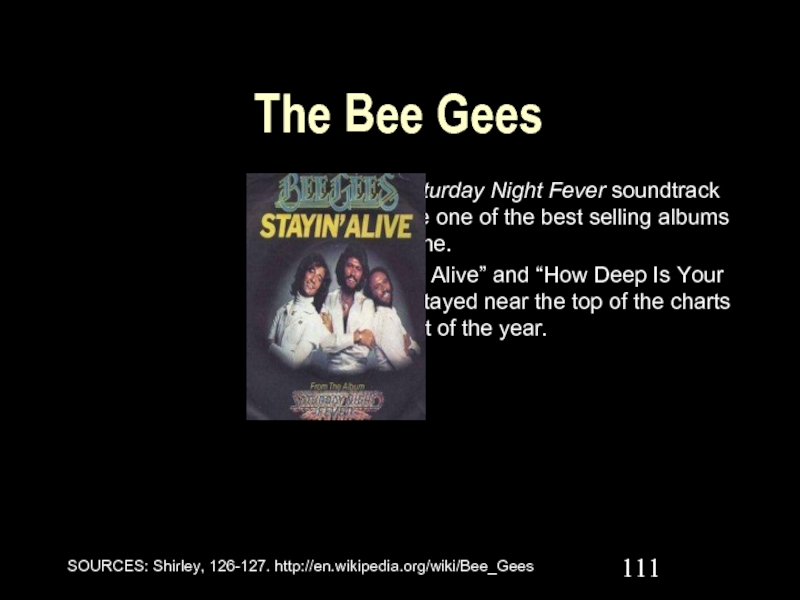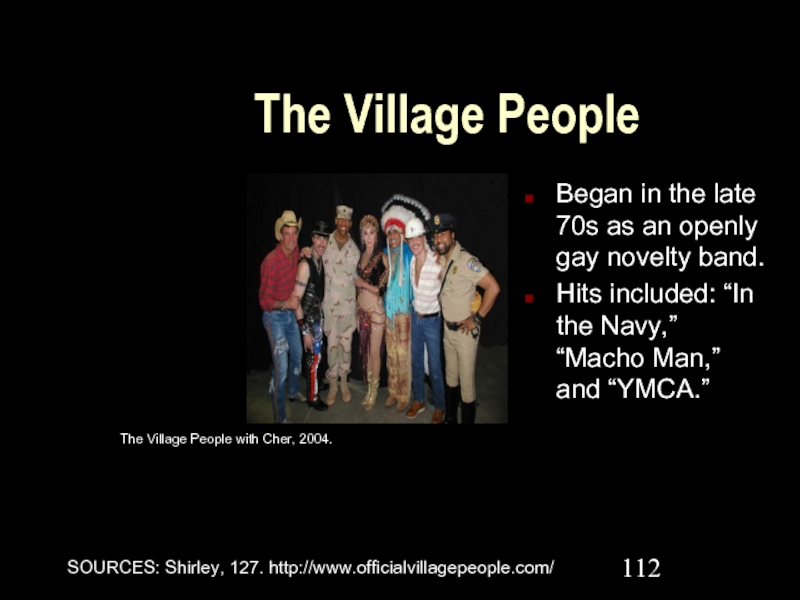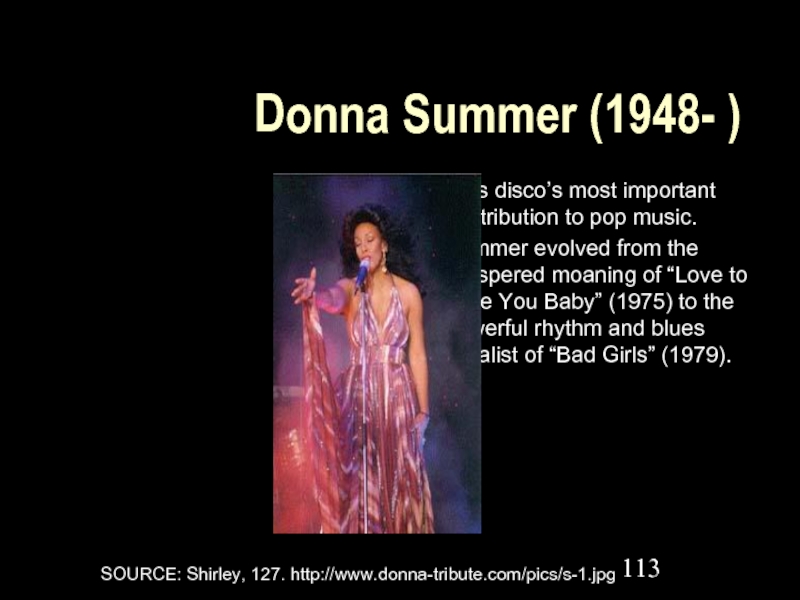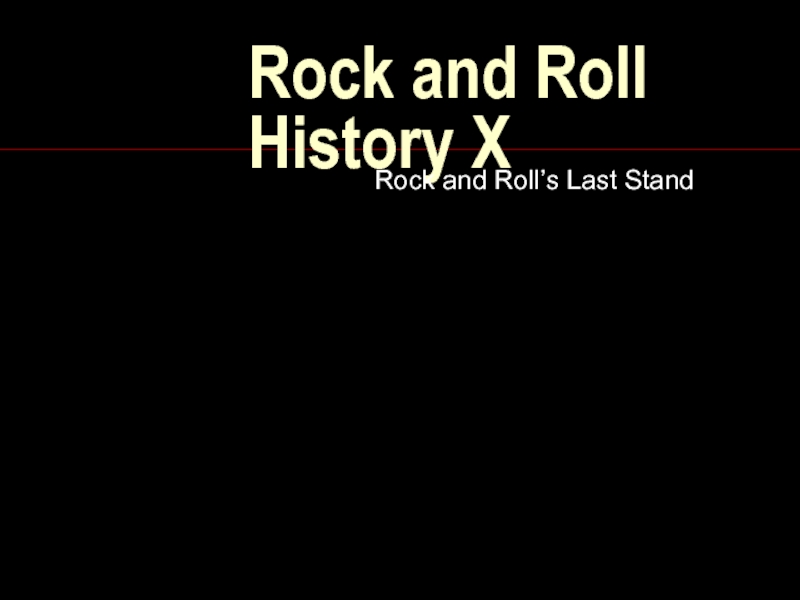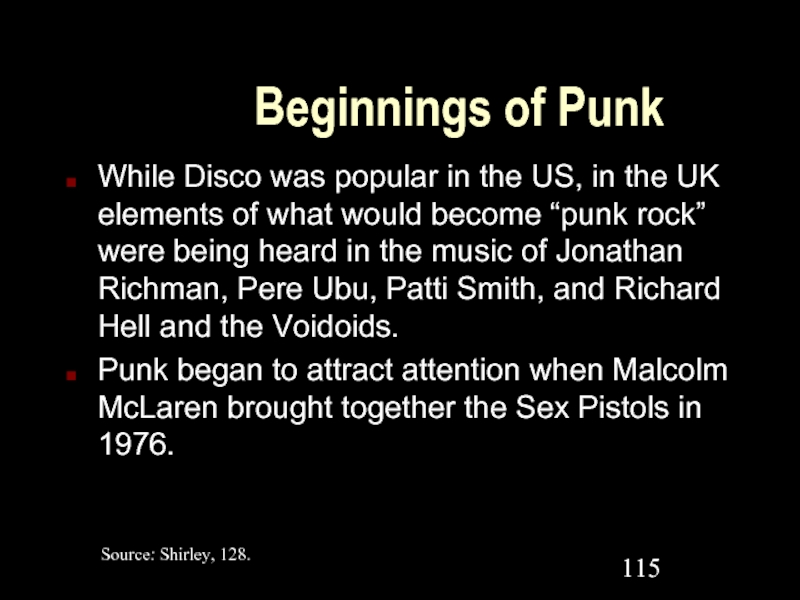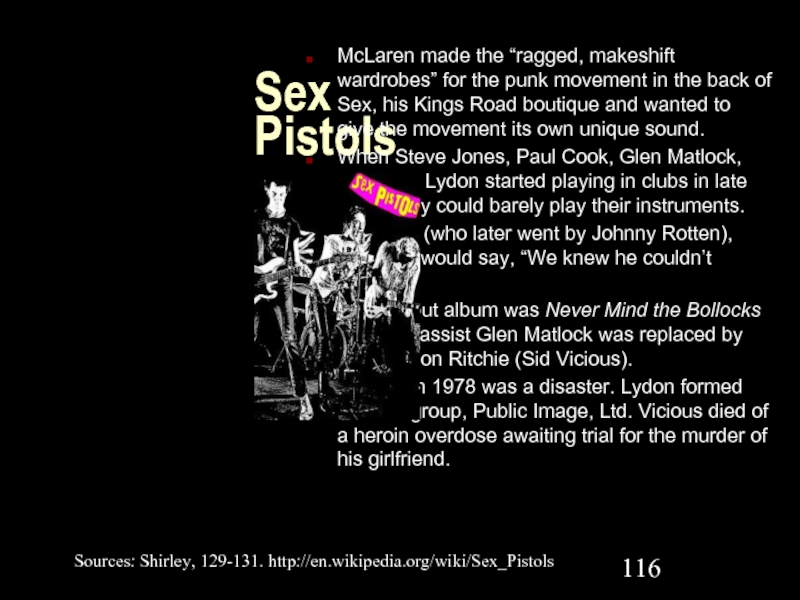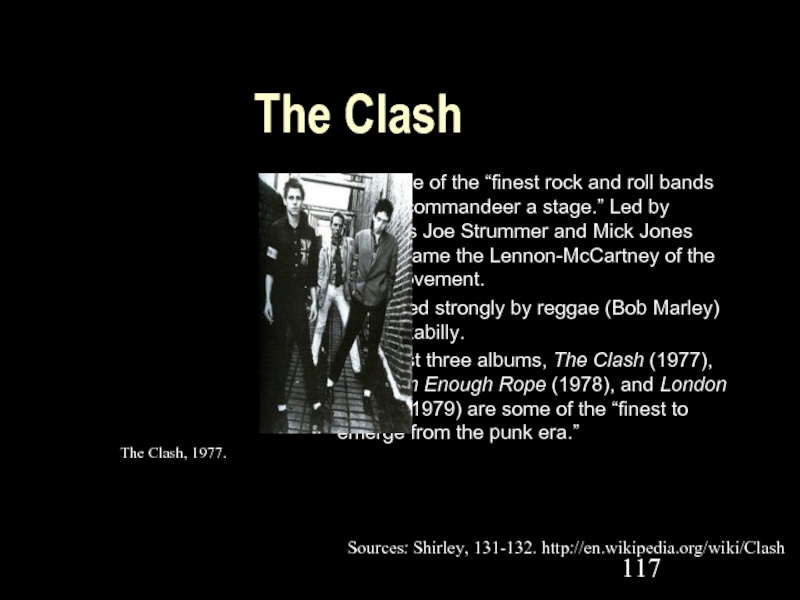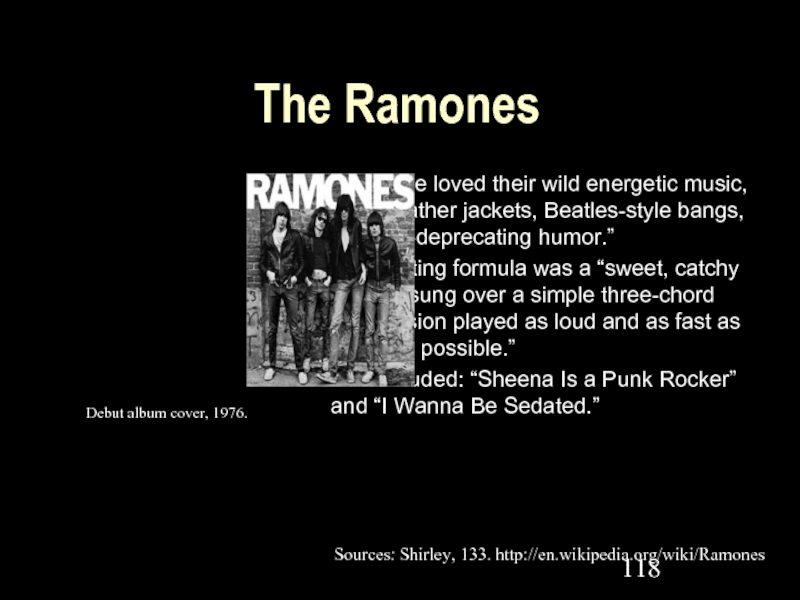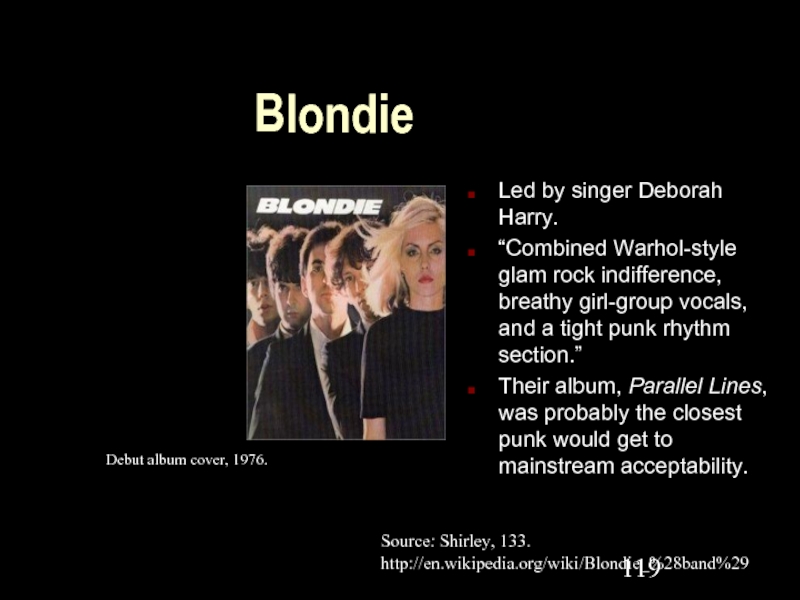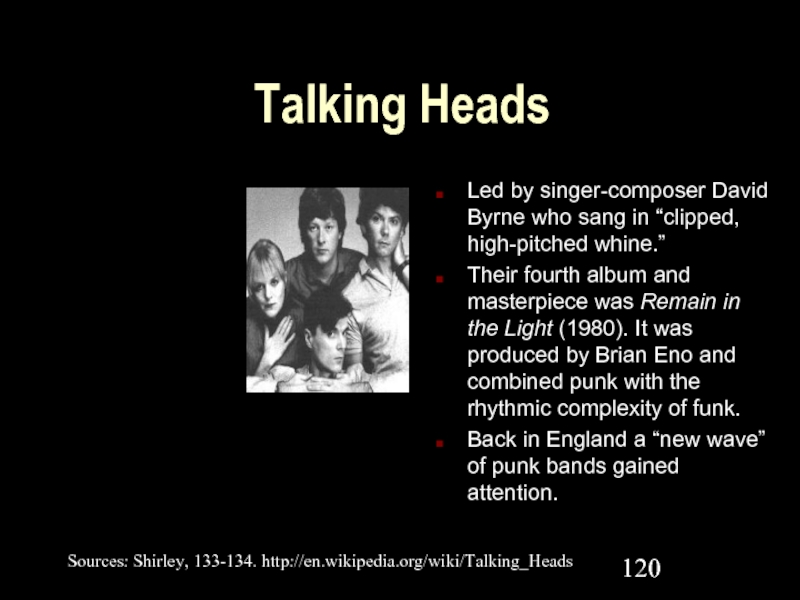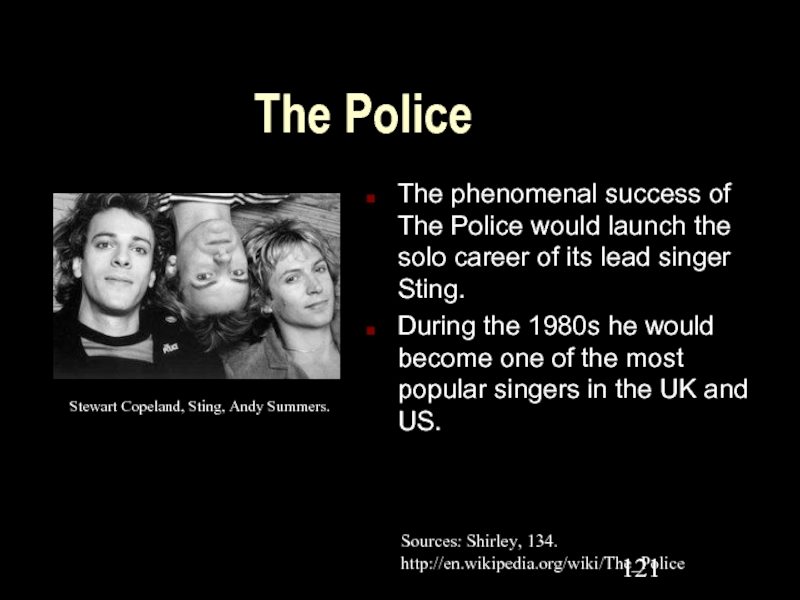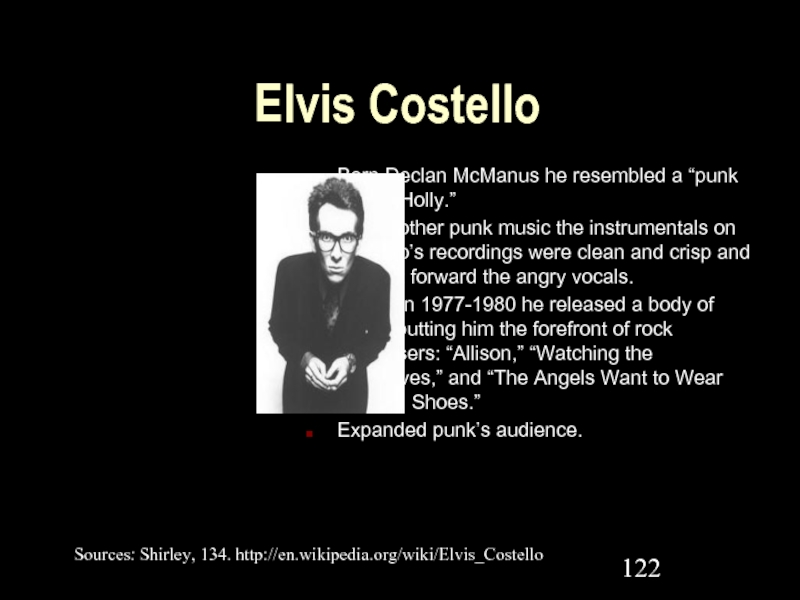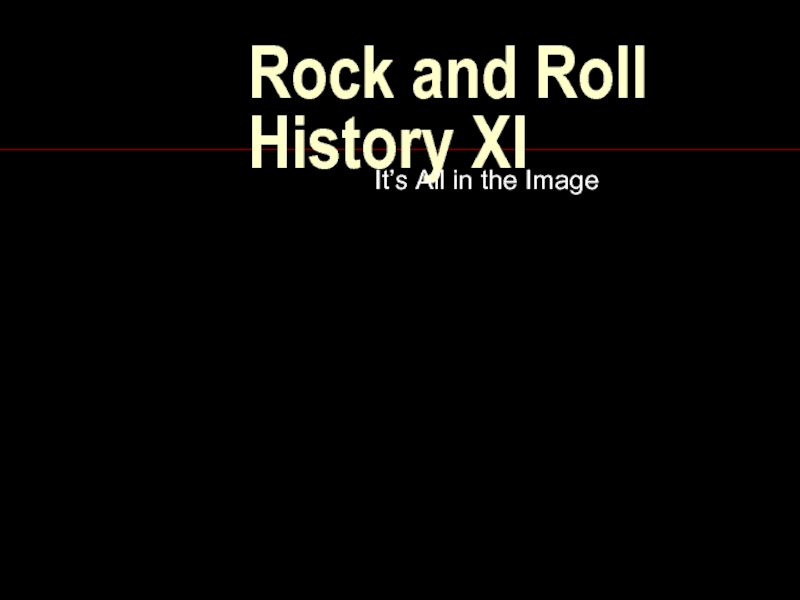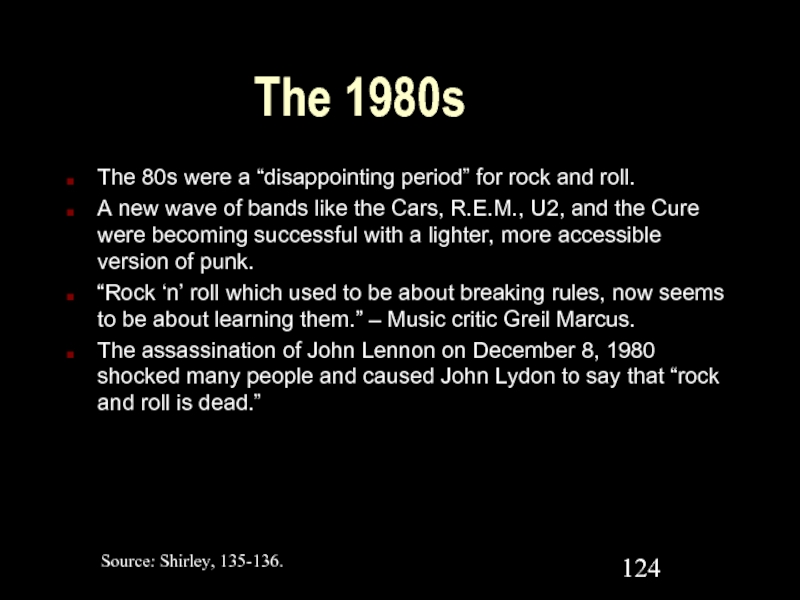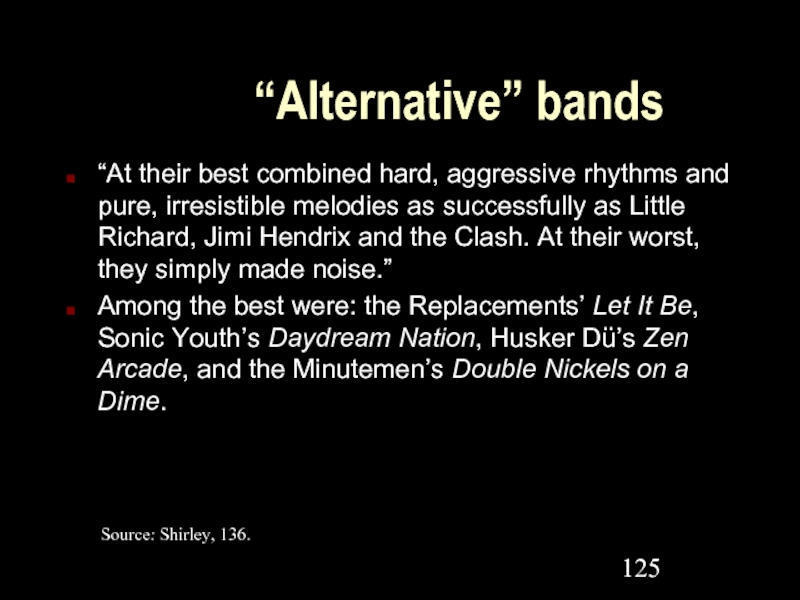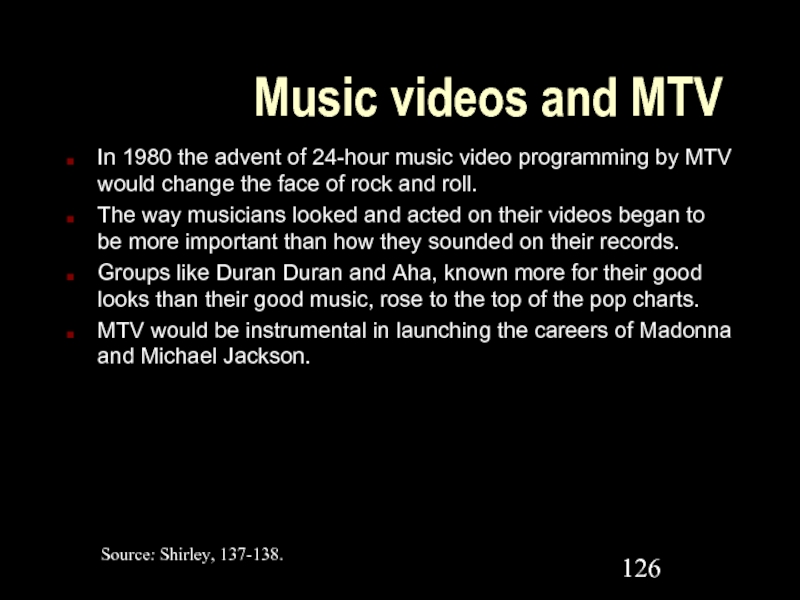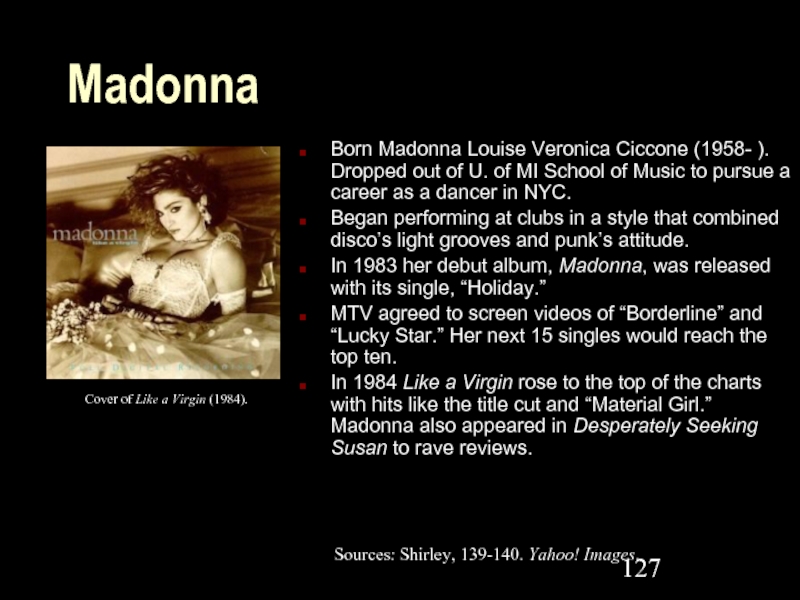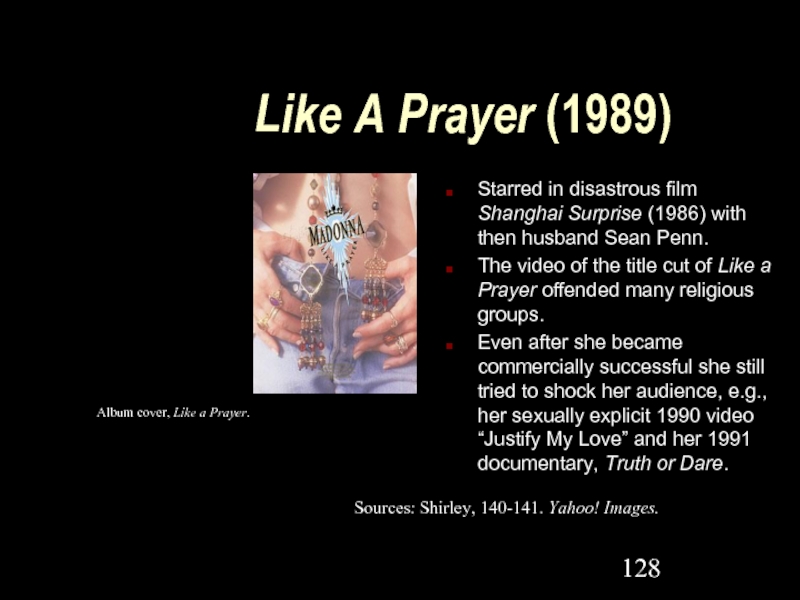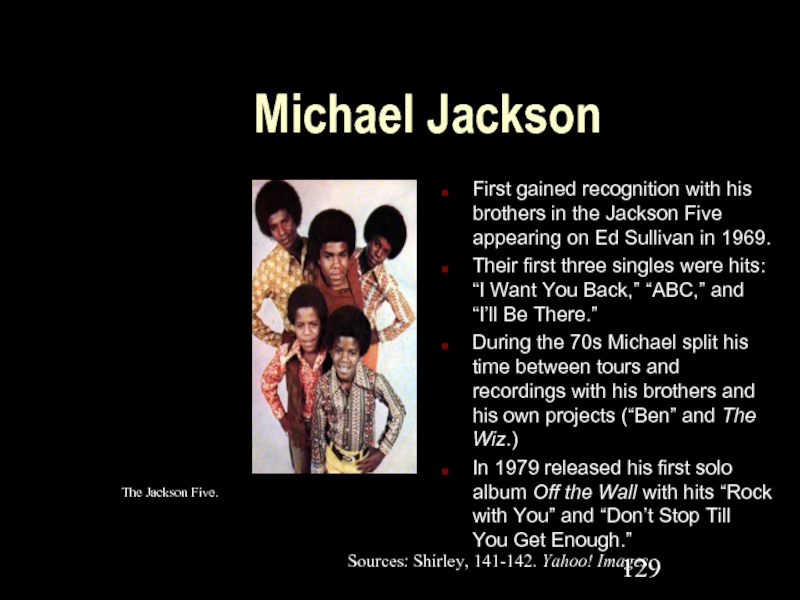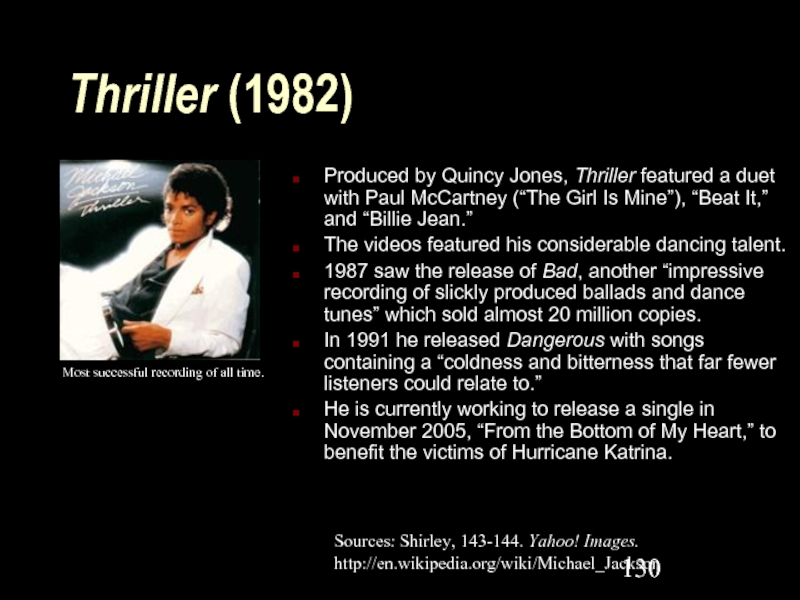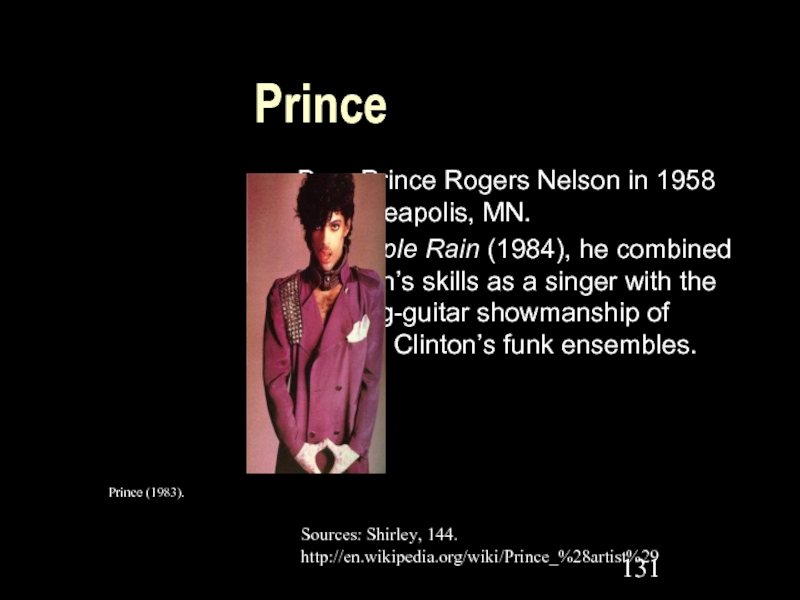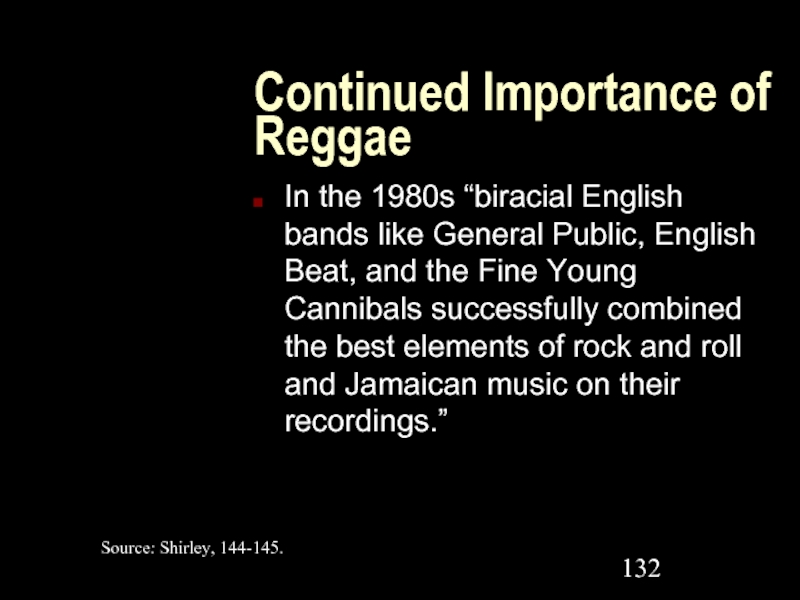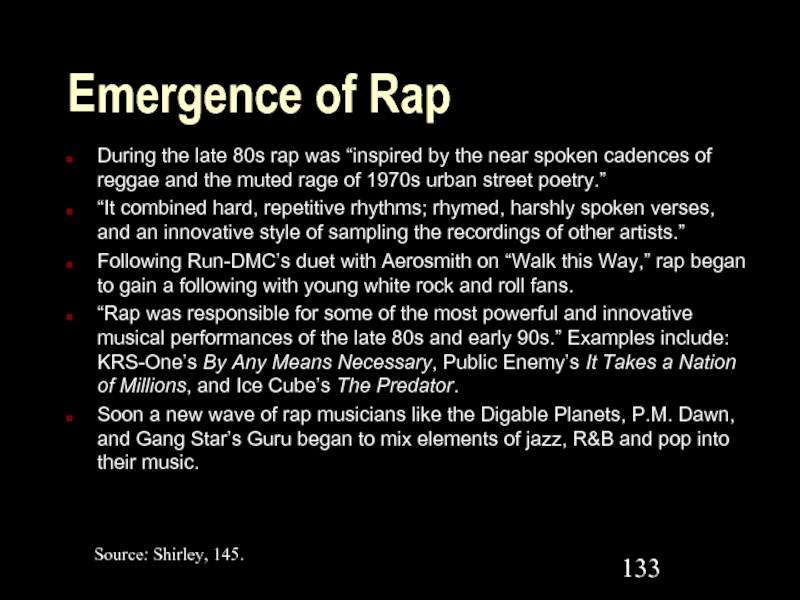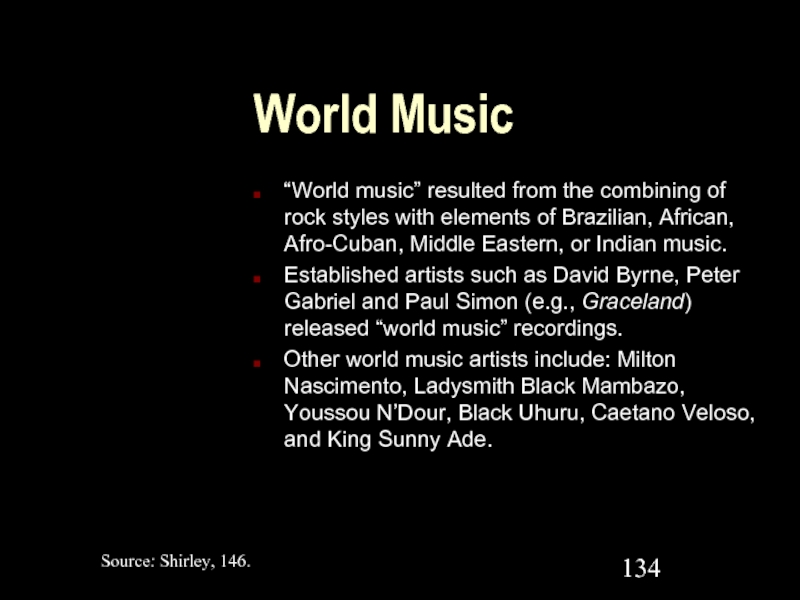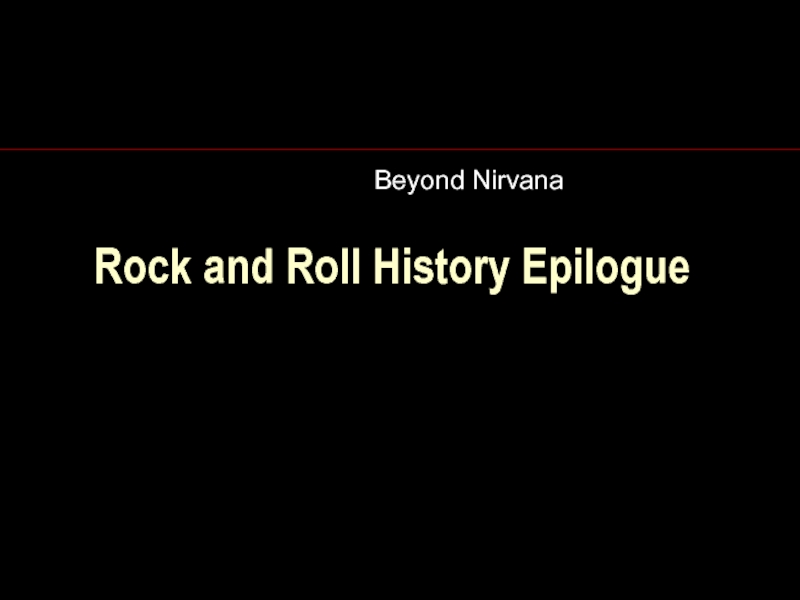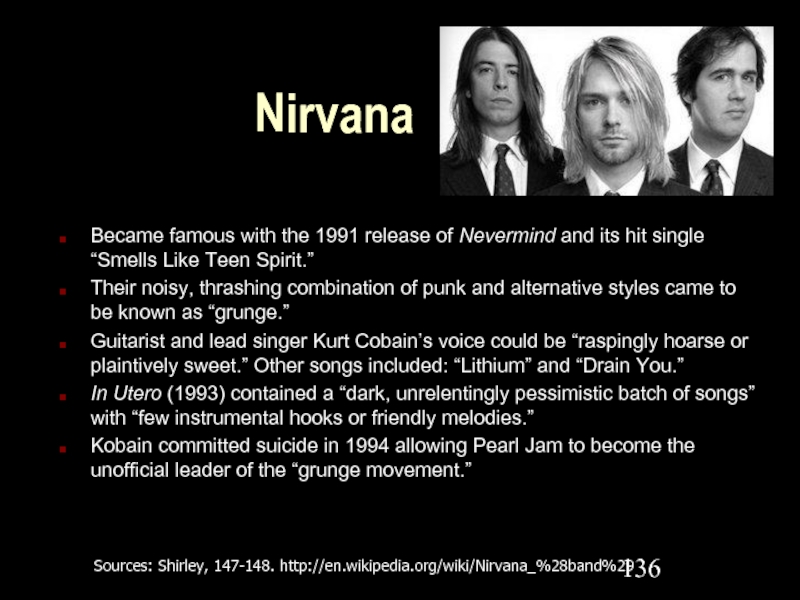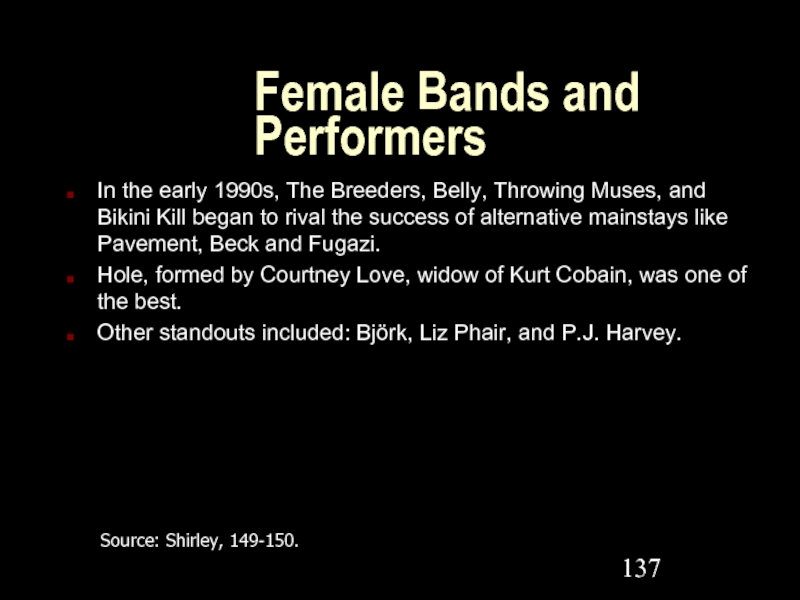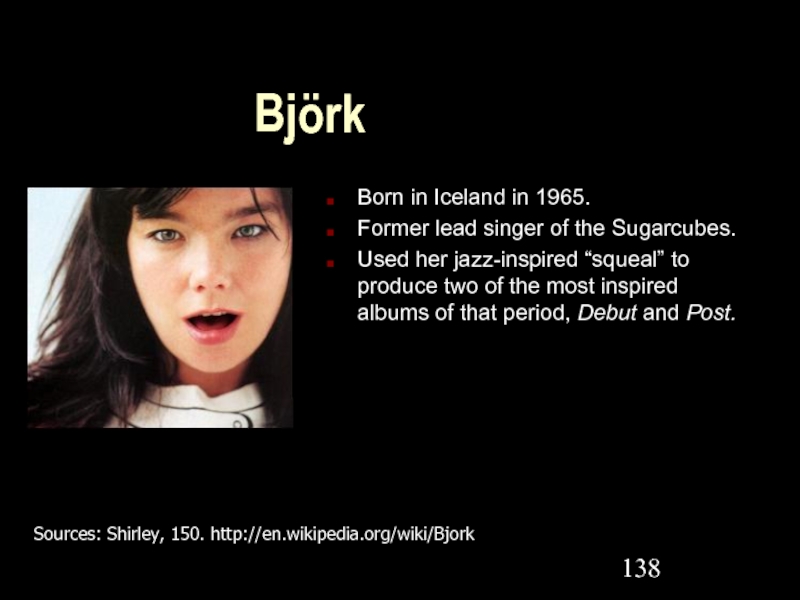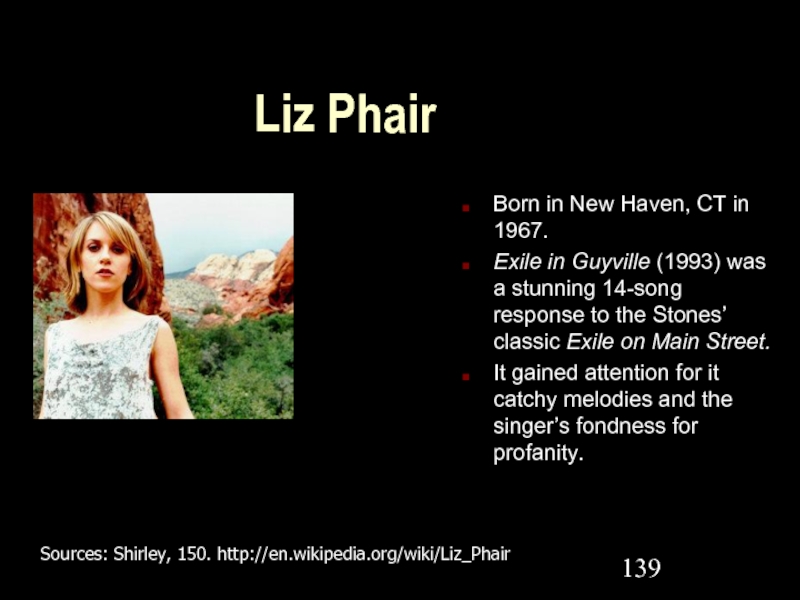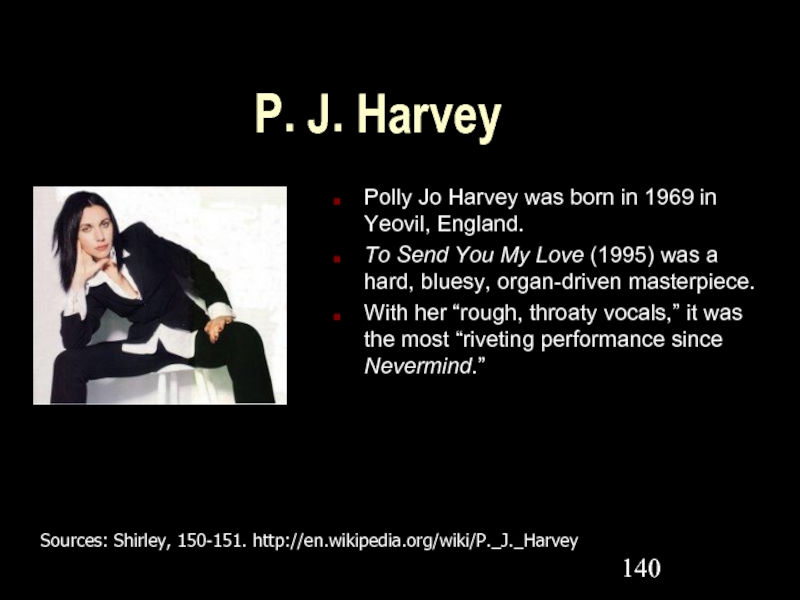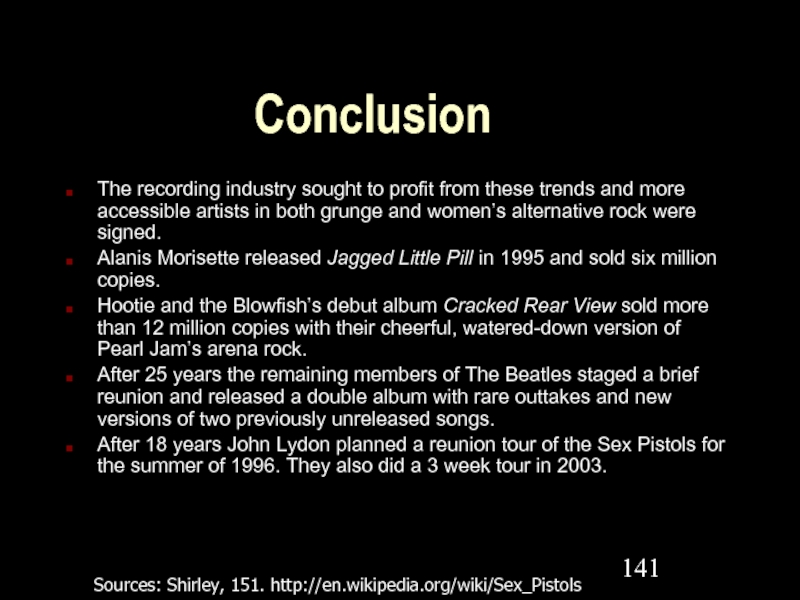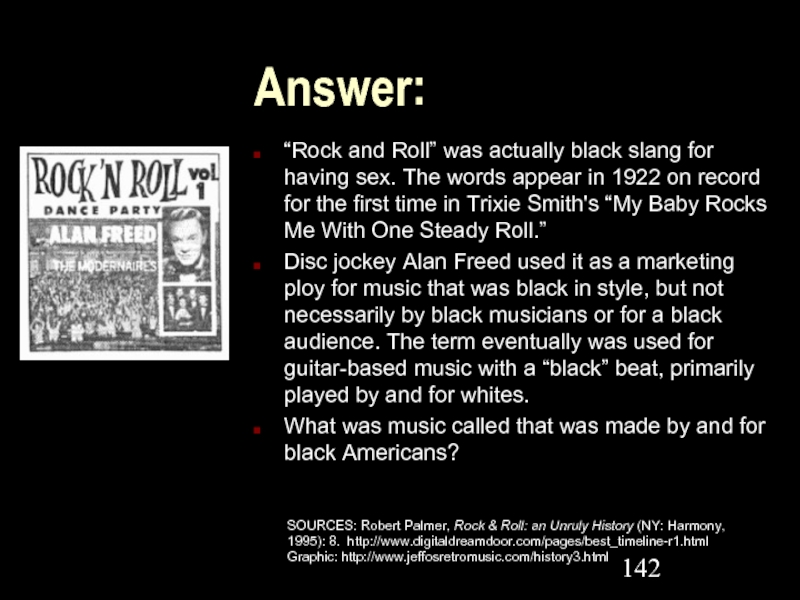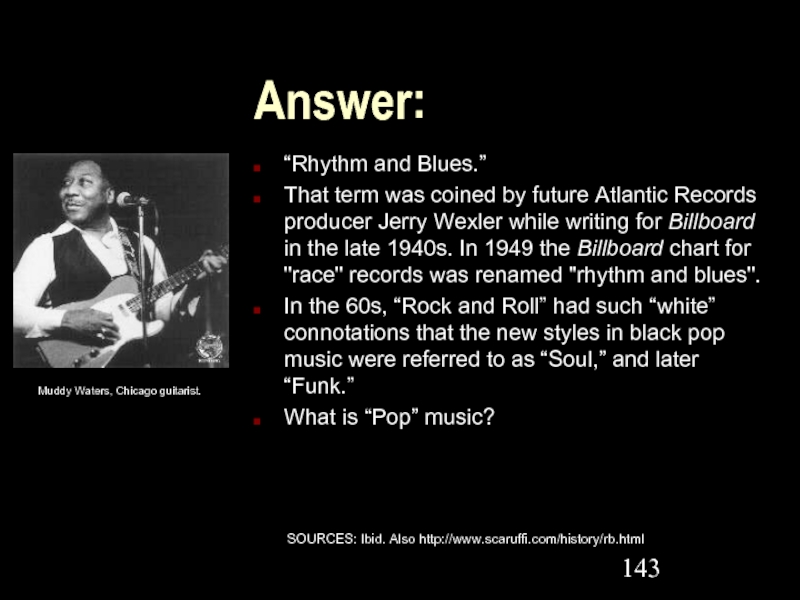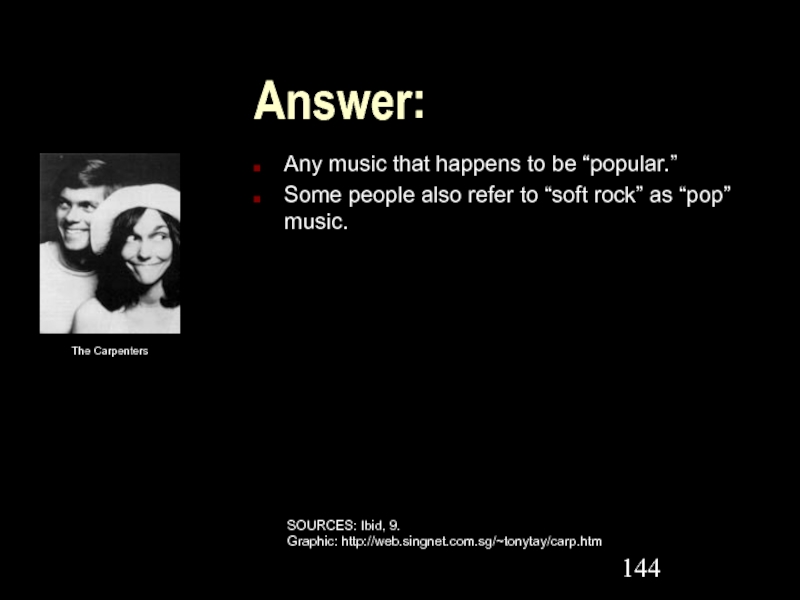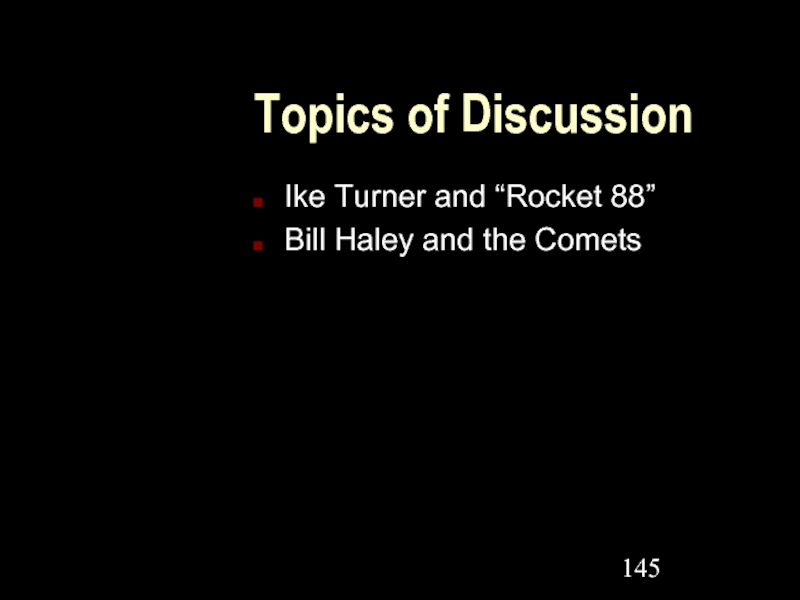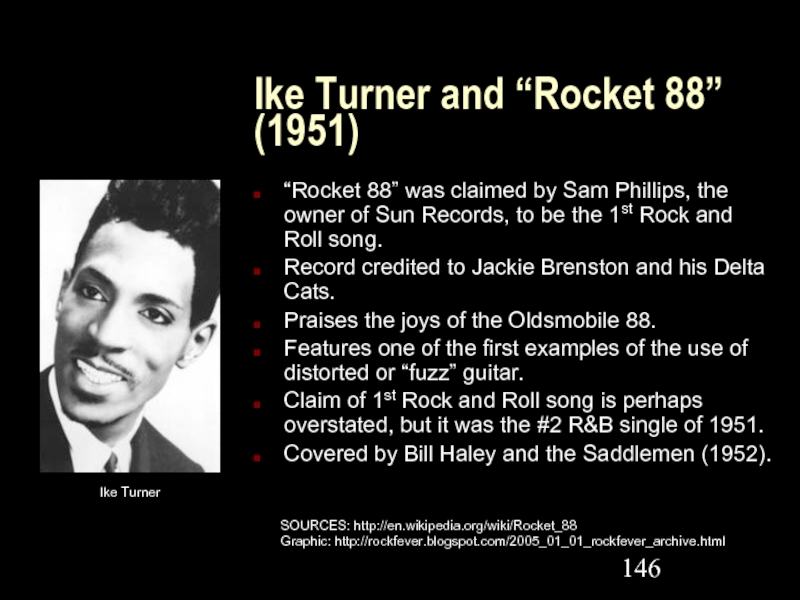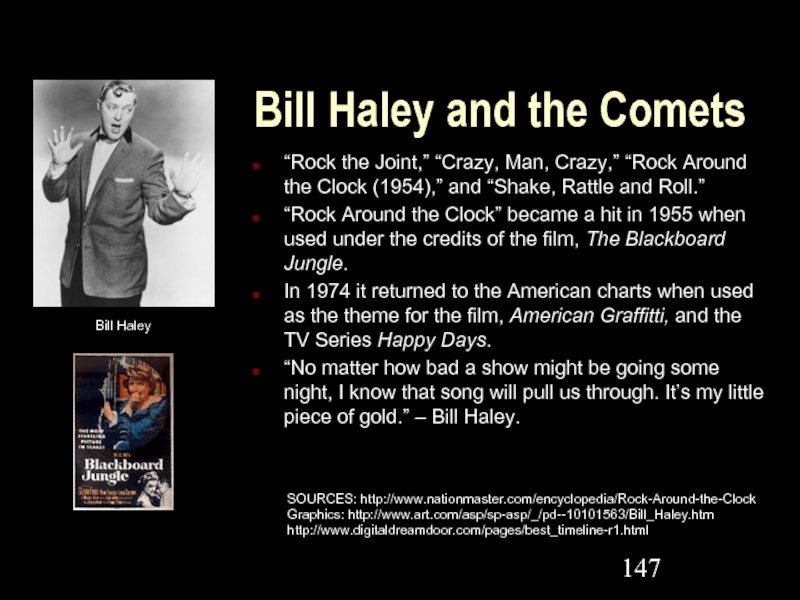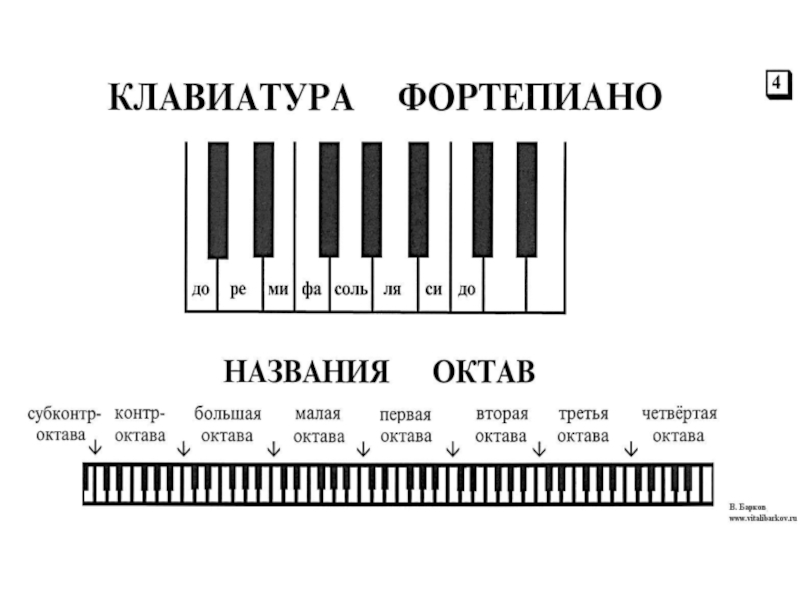- Главная
- Разное
- Дизайн
- Бизнес и предпринимательство
- Аналитика
- Образование
- Развлечения
- Красота и здоровье
- Финансы
- Государство
- Путешествия
- Спорт
- Недвижимость
- Армия
- Графика
- Культурология
- Еда и кулинария
- Лингвистика
- Английский язык
- Астрономия
- Алгебра
- Биология
- География
- Детские презентации
- Информатика
- История
- Литература
- Маркетинг
- Математика
- Медицина
- Менеджмент
- Музыка
- МХК
- Немецкий язык
- ОБЖ
- Обществознание
- Окружающий мир
- Педагогика
- Русский язык
- Технология
- Физика
- Философия
- Химия
- Шаблоны, картинки для презентаций
- Экология
- Экономика
- Юриспруденция
History of Rock and Roll Introduction презентация
Содержание
- 1. History of Rock and Roll Introduction
- 2. Rock and Roll History I Sam Phillips Finds His Star Who was Sam Phillips?
- 3. Sam Phillips (1923-2003) Sam Phillips was a
- 4. Elvis Presley (1935-1977) Received his first guitar
- 5. Elvis’ Break During a break in a
- 6. Elvis conquers the charts In 1956, Elvis
- 7. Elvis conquers Hollywood Love Me Tender (1956),
- 8. The “Comeback Special” (1968) Elvis did a
- 9. Elvis, the 70s and Vegas From 1969
- 10. Musical Milestones During his lifetime, Elvis Presley:
- 11. Quotes about Elvis Elvis was the only
- 12. Rock and Roll History II Hail, Hail, Rock and Roll
- 13. Major label recording practices in the
- 14. Goal of small record labels Find artists
- 15. Answer “Little Richard” Penniman Jerry Lee Lewis Chuck Berry
- 16. Little Richard (1932- ) Born Richard Wayne
- 17. Richard’s hits 1956-57 “Long Tall Sally” /
- 18. More Little Richard In 1959 he returned
- 19. Jerry Lee Lewis (1935- ) Cousin of
- 20. Lewis’ hits (1957-1958) “Breathless“ and “Great Balls
- 21. More Jerry 1n 1986 was inducted into
- 22. Sidebar: Screamin’ Jay Hawkins Jalacy Hawkins (1929-2000).
- 23. Chuck Berry (1926- ) Born in St.
- 24. Berry’s hits (1956-58) “Roll Over, Beethoven,” “School
- 25. More Chuck Berry Had a #1 hit
- 26. Rock and Roll History III The Day the Music Died
- 27. Early Rock and Roll a Combination of
- 28. Rock and Roll as Synthesis The most
- 29. Rockabilly The great success of Elvis and
- 30. The Everly Brothers In 1957 Don (1937-
- 31. Buddy Holly Charles Hardin Holley (1936-1959). Holly
- 32. Holly’s Hits (1957-1958) Rerecorded “That’ll Be the
- 33. The Day the Music Died February 3,
- 34. Labels sign “safer” teen idols Bobby Rydell,
- 35. Ricky Nelson (1940-1985) One of the more
- 36. Emergence of Producers Berry Gordy, Jr. (1929-
- 37. The early sixties The Seattle band, The
- 38. Rock and Roll History IV The British Invasion
- 39. British Bands discover Rock and Roll in
- 40. Beatlemania In January 1963 “I Want to
- 41. 1965 – Films and Rubber Soul The
- 42. 1966-1967 – Controversy & Sgt. Pepper “Christianity
- 43. End of an era At the end
- 44. The Animals Headed by organist Alan Price
- 45. The Kinks In 1965 had hits: “You
- 46. The Who Led by guitarist Pete Townshend
- 47. The Rolling Stones Most successful of the
- 48. Exile on Main St. In 1969 guitarist
- 49. Sidebar – The Pretty Things Possibly the
- 50. Rock and Roll History V Bringing It All Back Home
- 51. Fighting the British Invasion Bob Dylan, Beach
- 52. Folk Music The 1950s had been a
- 53. Bob Dylan Born Robert Allen Zimmerman (1941-
- 54. Another Side Another Side of Bob Dylan
- 55. “Like a Rolling Stone” Highway 61 Revisited
- 56. The Beach Boys Formed in 1961 by
- 57. Pet Sounds As the group became more
- 58. Smile Wilson spent an unprecedented $16,000 on
- 59. Frank Zappa (1940-1993) Born in Baltimore, MD.
- 60. Hot Rats In 1970 the Mothers of
- 61. Rock and Roll History VI Crossroads
- 62. Influence of the Blues The blues continued
- 63. Eric Clapton (1945- ) Began career as
- 64. Cream In 1966 Clapton formed Cream with
- 65. More Clapton In 1969 formed Blind Faith
- 66. Jim Morrison and The Doors Morrison (1943-1971)
- 67. San Francisco 60s Scene During the 1960s,
- 68. The Grateful Dead Led by Country and
- 69. Jimi Hendrix (1942-1970) Born Johnny Allen Hendricks
- 70. Electric Ladyland Debuted in U.S. at the
- 71. Rock and Roll History VII Things Quiet Down
- 72. The Late 60s and Early 70s Young
- 73. James Taylor (1948- ) Grew up in
- 74. Simon and Garfunkel The duo of Paul
- 75. Beatles Solo Careers In 1970 Paul McCartney
- 76. Carole King Born Carole Klein in 1942
- 77. Elton John (1947- ) Born Reginald Kenneth
- 78. Bruce Springsteen (1949- ) Born in Longbranch,
- 79. Born to Run Released Born to Run
- 80. Sidebar: The Shaggs In March 1969 Austin
- 81. The Byrds Began introducing folk and country
- 82. The Buffalo Springfield With its talented lead
- 83. The Flying Burrito Brothers Most often connected
- 84. Crosby, Stills & Nash (and Young) In
- 85. Creedence Clearwater Revival Started out as The
- 86. The Band The Band was made up
- 87. Rock and Roll History VIII Bring on the Noise
- 88. Different Directions While the majority of Americans
- 89. Led Zeppelin Fronted by “squealing tenor” Robert
- 90. “Art Rock” Rock and Roll began to
- 91. Pink Floyd Originally a cover band that
- 92. King Crimson Formed in 1969 by the
- 93. Glam Rock British artists in the early
- 94. Gary Glitter (1944- ) Born Paul Francis
- 95. Marc Bolan (1947-1977) Born Mark Feld in
- 96. David Bowie (1947- ) Born David Robert
- 97. Glam Bands Mott the Hoople blended glam
- 98. Influence of Jazz In 1964 saxophonist John
- 99. Rock and Roll History IX Rock Goes Underground
- 100. American Misfit Rock & Roll Kiss, Alice
- 101. The Velvet Underground Formed in the mid
- 102. Alice Cooper Born Vincent Furnier (1948- ).
- 103. Kiss Gene Simmons and Paul Stanley “used
- 104. Iggy Pop and the Stooges Born James
- 105. The New York Dolls “…how horrible they
- 106. Beginnings of Funk At about the same
- 107. Sly and the Family Stone Formed in
- 108. James Brown (1933-2006) Fired his legendary rhythm
- 109. George Clinton (1941- ) Formed R&B group
- 110. Development of Disco By the mid-1970s most
- 111. The Bee Gees The Saturday Night Fever
- 112. The Village People Began in the late
- 113. Donna Summer (1948- ) Was disco’s most
- 114. Rock and Roll History X Rock and Roll’s Last Stand
- 115. Beginnings of Punk While Disco was popular
- 116. Sex Pistols McLaren made the “ragged, makeshift
- 117. The Clash Were one of the “finest
- 118. The Ramones “…people loved their wild energetic
- 119. Blondie Led by singer Deborah Harry. “Combined
- 120. Talking Heads Led by singer-composer David Byrne
- 121. The Police The phenomenal success of The
- 122. Elvis Costello Born Declan McManus he resembled
- 123. Rock and Roll History XI It’s All in the Image
- 124. The 1980s The 80s were a “disappointing
- 125. “Alternative” bands “At their best combined hard,
- 126. Music videos and MTV In 1980 the
- 127. Madonna Born Madonna Louise Veronica Ciccone (1958-
- 128. Like A Prayer (1989) Starred in disastrous
- 129. Michael Jackson First gained recognition with his
- 130. Thriller (1982) Produced by Quincy Jones, Thriller
- 131. Prince Born Prince Rogers Nelson in 1958
- 132. Continued Importance of Reggae In the 1980s
- 133. Emergence of Rap During the late 80s
- 134. World Music “World music” resulted from the
- 135. Rock and Roll History Epilogue Beyond Nirvana
- 136. Nirvana Became famous with the 1991 release
- 137. Female Bands and Performers In the early
- 138. Björk Born in Iceland in 1965. Former
- 139. Liz Phair Born in New Haven, CT
- 140. P. J. Harvey Polly Jo Harvey was
- 141. Conclusion The recording industry sought to profit
- 142. Answer: “Rock and Roll” was actually black
- 143. Answer: “Rhythm and Blues.” That term
- 144. Answer: Any music that happens to be
- 145. Topics of Discussion Ike Turner and “Rocket 88” Bill Haley and the Comets
- 146. Ike Turner and “Rocket 88” (1951) “Rocket
- 147. Bill Haley and the Comets “Rock the
Слайд 3Sam Phillips (1923-2003)
Sam Phillips was a disc jockey who started the
It later became the Sun Records label.
From 1950-1954 he recorded black R&B artists that included: Bobby “Blue” Bland, Chester “Howlin’ Wolf” Burnett, James Cotton, Roscoe Gordon, Riley “B.B.” King, Little Milton, Herman “Little Junior” Parker, Rufus “Hound Dog” Thomas.
Was concerned his black artists would not be able to break through into the “white mainstream” market.
Began searching for a white artist “who could play and sing in this same exciting, alive way.”
Who would be that artist?
SOURCES: http://en.wikipedia.org/wiki/Sam_Phillips; Shirley, 14.
Слайд 4Elvis Presley (1935-1977)
Received his first guitar at 11.
Early influences included: hymns,
In 1947 his family moved to Memphis and he began listening to blues and R&B.
In 1950 he began hearing Sam Phillips’ Sun Studios recordings.
In 1953 he paid $4 to record “My Happiness” and “That’s When Your Heartaches Begin” at Sun Studios.
Elvis Presley
SOURCES: http://en.wikipedia.org/wiki/Elvis_Presley; Shirley, 14-15.
Слайд 5Elvis’ Break
During a break in a 1954 recording session with guitarist
It was released 2 weeks later with “Blue Moon of Kentucky” and caused a sensation.
Two months later Presley, Moore, and Black released “Good Rockin’ Tonight” and in less than a year he became the most popular entertainer in the mid-south.
In 1955 Colonel Tom Parker arranged for RCA to buy out Elvis’ contract for $35,000.
Elvis at the Mississippi-Alabama State Fair in 1956.
SOURCES: http://en.wikipedia.org/wiki/Elvis_Presley; Shirley, 16-18.
Слайд 6Elvis conquers the charts
In 1956, Elvis had the #1 country single
In 1957, he released the following hit singles: “Hound Dog,” “Don’t Be Cruel,” “Love Me Tender,” Jailhouse Rock,” “All Shook Up,” and “Teddy Bear.” He appeared on January 6 on The Ed Sullivan Show from the waist up.
Drafted by the U.S. Army in 1958.
SOURCES: http://en.wikipedia.org/wiki/Elvis_Presley; Shirley, 18-19.
Слайд 7Elvis conquers Hollywood
Love Me Tender (1956), Loving You, Jailhouse Rock (1957),
SOURCES: http://en.wikipedia.org/wiki/Elvis_Presley; Shirley, 19-20.
Graphic: http://en.wikipedia.org/wiki/Jailhouse_Rock_%28movie%29.
Слайд 8The “Comeback Special” (1968)
Elvis did a one hour prime time TV
In 1969 a song introduced during the Special, “Suspicious Minds,” hit #1 on the pop charts.
Elvis during the Comeback Special.
SOURCES: http://en.wikipedia.org/wiki/Elvis_Presley; Shirley, 20-21.
Слайд 9Elvis, the 70s and Vegas
From 1969 to 1977 Elvis performed over
Many believe the January 1973 “Aloha from Hawaii” concert, the first to be broadcast worldwide by satellite, is the best of his career.
Elvis Presley died on August 16, 1977. He had been addicted to prescription drugs and also had a history of a weak heart and kidneys. He was 42.
The 70s Elvis
SOURCES: http://en.wikipedia.org/wiki/Elvis_Presley; Shirley, 21.
Слайд 10Musical Milestones
During his lifetime, Elvis Presley:
recorded 104 singles that hit the
had 18 #1 Billboard hits, including four singles in 1956 that occupied the top of the charts for a cumulative total of 25 weeks. The total (18) is surpassed only by The Beatles, who had 20 #1 hits. His closest competitor is Mariah Carey with a total of 16 #1 hits.
has spent a total of 79 Weeks at the #1 position. His closest competitor is Mariah Carey with 73 weeks.
had 38 Top 10 Billboard hits. This total is currently unchallenged; the closest competitor, Madonna, has 35. The Beatles had 34 Top 10 hits during their career.
Other records set by Elvis Presley:
From 3/1956 to 11/1959, there was at least one Elvis song on the singles chart.
From 1956 to 1962, he had 24 top 5 hit singles in a row, each of which sold in excess of one million copies. The closest anyone has come to this was Madonna in the late 1980s and early 1990s, with 19 consecutive top 5 hits.
On the official UK Top 40 chart, "It's Now Or Never" reached #1 in the week of January 30, 2005, 27 years after Presley's death.
Elvis Presley has 116.5 million albums and approximately 50 million singles certified by RIAA in the United States, making his total US record sales aproximately 167 million.
SOURCES: http://en.wikipedia.org/wiki/Elvis_Presley.
Слайд 11Quotes about Elvis
Elvis was the only man from Northeast Mississippi who
When I first heard Elvis' voice, I just knew that I wasn't going to work for anybody, and nobody was going to be my boss. He is the deity supreme of rock and roll religion as it exists in today's form. Hearing him for the first time was like busting out of jail. I thank God for Elvis Presley... Elvis recorded a song of mine, that's the one recording I treasure the most. -- Bob Dylan.
Don't blame it on Elvis, for shakin' his pelvis, Shakin' the pelvis been in style way back since the River Nile. -- The Fabulous McClevertys, calypso singers, 1957.
Before Elvis, there was nothing. -- John Lennon.
Before Elvis, everything was in black and white. Then came Elvis. Zoom, glorious Technicolor. -- Keith Richards.
No one will ever touch Elvis. -- Garth Brooks.
Without Elvis, none of us could have made it. -- Buddy Holly.
That Elvis, man, he is all there is. There ain't no more. Everything starts and ends with him. He wrote the book. -- Bruce Springsteen
SOURCES: http://en.wikipedia.org/wiki/Elvis_Presley.
Слайд 13Major label recording practices
in the early 1950s
Rerecord minor hits released
Turn them into smash hits by making them less daring and gearing them towards white middle America.
Example: Fats Domino’s “Ain’t that a Shame” was covered by Pat Boone.
Слайд 14Goal of small record labels
Find artists “so talented and unique—or so
Who are 3 artists that fall into this category?
Слайд 16Little Richard (1932- )
Born Richard Wayne Penniman.
Producer Bumps Blackwell was looking
On September 13, 1955 Richard recorded “Tutti Frutti.”
The lyrics were changed from “Tutti-frutti loose booty” to “Tutti frutti all rooty” because Blackwell felt they were over the line. (Tutti-frutti was a slang term meaning a “gay male.”)
SOURCES: http://en.wikipedia.org/wiki/Little_Richard;
Shirley, 24-25.
Little Richard
Слайд 17Richard’s hits 1956-57
“Long Tall Sally” / “Slippin’ and Slidin”
“She’s Got It,”
“His frantic performing style can be seen in such period films as Don't Knock the Rock (1956) and The Girl Can't Help It (1956), for which he sang the title song, written by Bobby Troup.”
In October 1957 he left show business to enroll at a Pentecostal Bible college.
His vocal style would influence Paul McCartney, Mick Jagger, and John Fogerty (Creedence Clearwater Revival).
SOURCES: http://en.wikipedia.org/wiki/Little_Richard;
Shirley, 27-29.
Little Richard in a 1957 performance
Слайд 18More Little Richard
In 1959 he returned to the music business, but
In 1962, he toured the UK supported by The Beatles and The Rolling Stones who were big fans.
In 1986 was one of the first inductees into the new Rock and Roll Hall of Fame. He also appeared in the movie, Down and Out in Beverly Hills, scoring a hit with “Great Gosh-a-Mighty.”
In 2000 a made-for-TV film, Little Richard, starred Leon Robinson in the title role.
SOURCES: http://en.wikipedia.org/wiki/Little_Richard.
Слайд 19Jerry Lee Lewis (1935- )
Cousin of Mickey Gilley and Jimmy Swaggart.
Joined
Recorded “Crazy Arms” in 1956.
Recorded “Whole Lotta Shakin’ Goin’ On” in 1957. Went wild kicking out the piano stool on the Steve Allen Show.
Nicknamed “The Killer” for his outrageous on-and-off-stage antics.
Jerry Lee Lewis
SOURCES: Shirley, 30-32. http://en.wikipedia.org/wiki/Jerry_Lee_Lewis
Слайд 20Lewis’ hits (1957-1958)
“Breathless“ and “Great Balls of Fire.”
“Crazy” is an error
In December 1957 wed his 13 year old second cousin, Myra Gale Brown, starting a scandal that hurt his career.
In 1958 appeared in the film, High School Confidential, performing the title cut standing on the open deck of a truck.
Jerry Lee at the piano.
SOURCES: Shirley, 32-33; http://en.wikipedia.org/wiki/Jerry_Lee_Lewis
Слайд 21More Jerry
1n 1986 was inducted into the Rock and Roll Hall
In 1989 was the subject of the film, Great Balls of Fire, starring Dennis Quaid based on the book by his ex-wife Myra.
In February of 2005 he was given a Lifetime Achievement Award by the Recording Academy.
He released in September of 2006 a new CD, “Last Man Standing,” with an “amazing list of guest artists.”
Lewis with fan Lisa Marie Presley
SOURCE: http://en.wikipedia.org/wiki/Jerry_Lee_Lewis; http://theband.hiof.no/albums/the_pilgrim.html
Слайд 22Sidebar: Screamin’ Jay Hawkins
Jalacy Hawkins (1929-2000).
Known primarily for the song, “I
At the beginning of his shows, he would emerge from a coffin dressed in a Dracula-like cape. Also used leopard fur and red leather.
Cited Paul Robeson and Enrico Caruso as influences.
The film, Stranger than Paradise, repopularized “I put a spell on you” in 1983.
Hawkins also appeared in the film, Mystery Train, as a hotel night clerk.
Screamin’ Jay Hawkins
SOURCES: Shirley, 34; http://en.wikipedia.org/wiki/Screamin%27_Jay_Hawkins
Слайд 23Chuck Berry (1926- )
Born in St. Louis. Influences included Nat King
In 1955 Waters discovered him at a small blues club in Chicago and introduced him to Leonard and Cliff Chess of Chess Records who had recently signed Bo Diddley.
In September ’55 he recorded “Maybellene,” a remake of the country hit, “Ida Red (May)” which reached #5 on the pop charts and #1 on the R&B charts.
The dapper Chuck Berry
SOURCES: Shirley, 35-36; http://en.wikipedia.org/wiki/Chuck_Berry; http://www.chuckberry.com/about/biography3.html
Слайд 24Berry’s hits (1956-58)
“Roll Over, Beethoven,” “School Days,” “Johnny B. Goode,” and
Influenced numerous guitarists including Jimi Hendrix and Keith Richards.
Had legal troubles in 1960 and would never regain his popularity.
Chuck doing the “duck walk.”
SOURCES: Shirley, 38-39; http://en.wikipedia.org/wiki/Chuck_Berry; http://www.chuckberry.com/music/charts.html
Слайд 25More Chuck Berry
Had a #1 hit in 1972 with “My Ding-a-ling.”
In
In 1979 pled guilty to income tax evasion.
In 1985 receives Lifetime Achievement Award at the 27th Annual Grammy Awards. Is backed by Bruce Springsteen at the Concert for the Rock and Roll Hall of Fame in Cleveland.
In 1986 inducted into the Rock and Roll Hall of Fame.
In 1987 publishes his autobiography. Hail, Hail, Rock and Roll, a documentary film tribute to Berry directed by Keith Richards is released.
Still performs regularly.
SOURCES: http://en.wikipedia.org/wiki/Chuck_Berry; http://www.chuckberry.com/about/career.html.
Слайд 27Early Rock and Roll a Combination of Six Styles
Blues
Gospel
Country and Western
Boogie
Rhythm and Blues
Folk
SOURCE: Shirley, 40.
Слайд 28Rock and Roll as Synthesis
The most successful musicians and performers were
Rock and Roll was neither “black” or “white,” but an “exciting mix of the two.”
SOURCE: Shirley, 40-41.
Слайд 29Rockabilly
The great success of Elvis and others led to a decline
This was especially true of country-inspired Rockabilly musicians with the possible exceptions of Eddie Cochran and Gene Vincent.
Rockabilly is a “fusion of blues, hillbilly boogie, bluegrass, and country.”
SOURCES: Shirley, 41; http://en.wikipedia.org/wiki/Rockabilly
Слайд 30The Everly Brothers
In 1957 Don (1937- ) and Phil (1939- )
Biggest hits were “Bye, Bye Love” and “Wake Up, Little Susie.”
The Everly Brothers in 1957
SOURCES: Shirley, 41-42; http://www.everlybrothers.com/html/photos.html
Слайд 31Buddy Holly
Charles Hardin Holley (1936-1959).
Holly and Bob Montgomery had been trying
Influenced by Elvis Presley to give their music a “harder rhythm and blues edge.”
In October 1955 Decca Records wanted only Holly for a record deal.
Recorded “Love Me” and “Modern Don Juan” – modest hits. Called it quits with Decca in 1956.
Holly with trademark glasses.
SOURCE: Shirley, 42-43. http://en.wikipedia.org/wiki/Buddy_Holly
Слайд 32Holly’s Hits (1957-1958)
Rerecorded “That’ll Be the Day” which reached #2 on
“Oh Boy!,” “Not Fade Away,” “Every Day,” “It’s So Easy to Fall in Love,” and “Peggy Sue.”
First white performer to use the “hiccup” vocal technique on a popular recording.
In 1958 toured England (influenced The Beatles) and also released “It Doesn’t Matter Anymore.”
Buddy Holly and the Crickets
SOURCES: Shirley, 43-44. http://www.buddyholly.com/
Слайд 33The Day the Music Died
February 3, 1959
Holly joined the “Winter Dance
Featured Dion and the Belmonts, Frankie Sardo, J. P. “Big Bopper” Richardson, and Ritchie Valens (“La Bamba”).
After their February 2 gig at the Surf Ballroom, Clear Lake, IA, Holly chartered a plane to Fargo, ND.
The plane crashed shortly after takeoff killing the pilot, Holly, Richardson, and Valens.
Immortalized in Don McClean’s 1971 anthem, “American Pie.”
Crash site memorial
SOURCES: Shirley, 44-46. http://en.wikipedia.org/wiki/Buddy_Holly
Слайд 34Labels sign “safer” teen idols
Bobby Rydell, Bobby Vee, Jimmy Clanton, Frankie
Dick Clark’s American Bandstand helps make rock and roll more acceptable and advances the careers of Avalon and Fabian.
Chancellor Records’ Bob Marcucci later admitted Fabian “couldn’t sing. He knew it and I knew it.”
Looks began to be as or more important than sound.
SOURCE: Shirley 47-48.
Слайд 35Ricky Nelson (1940-1985)
One of the more talented teen idols.
Son of Ozzie
At 16 recorded Fats Domino’s “I’m Walkin’.”
Featured in the 1959 film, Rio Bravo.
“It’s Late” and “Hello, Mary Lou” among the best releases of that time.
Ricky Nelson
SOURCES: Shirley, 48-49. http://en.wikipedia.org/wiki/Ricky_Nelson
Слайд 36Emergence of Producers
Berry Gordy, Jr. (1929- ) at Motown produced early
Over the next 25 years was responsible for recording such artists as: Marvin Gaye, The Temptations, The Four Tops, Diana Ross and the Supremes, The Jackson Five.
Phil Spector (1940- ) used bass drums, “sparkling” keyboards, and multi-layered vocals to produce his signature “wall of sound.”
Spector produced the recordings of Ben E. King (“Stand by Me”), The Crystals, The Chiffons, The Shirelles, and The Righteous Brothers (“You’ve Lost That Lovin’ Feelin’).
SOURCES: Shirley, 49-50; Wikipedia “Berry Gordy” and “Phil Spector.”
Слайд 37The early sixties
The Seattle band, The Ventures were popular with “The
The Beach Boys with their “Four Freshman” style vocal harmonies begin to capitalize on the “surf” craze.
Frankie Valli and The Four Seasons had hits: “Sherry,” “Walk Like a Man,” and “Big Girls Don’t Cry.”
SOURCE: Shirley, 50.
Слайд 39British Bands discover Rock and Roll in the early 60s
In 1961
Early influences were Little Richard, Chuck Berry, and Buddy Holly and the Crickets.
The “Liverpool sound” is “…the same as the rock from five years ago.” (George Harrison)
In 1962 drummer Ringo Starr (Richard Starkey) replaced Pete Best. The band began to do Lennon and McCartney originals – “Please, Please Me,” “From Me to You,” and “She Loves You.”
SOURCE: Shirley, 51-52.
Слайд 40Beatlemania
In January 1963 “I Want to Hold Your Hand” reaches #1
In February 1963 The Beatles debuted on The Ed Sullivan Show.
The “British Invasion” also included the less popular Gerry and the Pacemakers, the Dave Clark Five, and Freddie and the Dreamers.
On the Ed Sullivan Show in 1963
SOURCES: Shirley, 52-53. http://en.wikipedia.org/wiki/The_Beatles
Слайд 411965 – Films and Rubber Soul
The Beatles’ film debut, A Hard
The soundtrack to Help! (1965) also reached the top of the charts.
Rubber Soul, their first album of all original material included: “Norwegian Wood,” “Nowhere Man,” “Michelle,” and “In My Life.” It established Lennon and McCartney as the “preeminent popular songwriting team of their generation.”
It would influence Bob Dylan, Frank Zappa, Brian Wilson, and The Rolling Stones.
SOURCES: Shirley, 53-54. Graphics courtesy of Amazon.com.
Слайд 421966-1967 – Controversy & Sgt. Pepper
“Christianity will go … We’re more
In July 1967 Sgt. Pepper’s Lonely Hearts Club Band appeared in record stores. Considered one of the “most influential and frequently discussed” albums of the decade.
After Sgt. Pepper, they gradually “lost their edge,” quit playing concerts, and devoted their energy to recording.
In 1968 their manager Brian Epstein, who had held the group together as a creative unit, died.
The Beatles in 1967
SOURCES: Shirley, 55-56. http://en.wikipedia.org/wiki/The_Beatles; Amazon.com.
Слайд 43End of an era
At the end of the decade they had
The latter two were more collections of songs by the band’s members.
In 1969 Paul McCartney’s “Hey Jude” would become the Beatles’ biggest hit ever.
By the end of 1970, Lennon, McCartney, and Harrison had all released solo albums and The Beatles had disbanded.
SOURCES: Shirley, 56-57. Graphics: Amazon.com.
Слайд 44The Animals
Headed by organist Alan Price and lead singer Eric Burdon.
In
SOURCES: Shirley, 58. http://en.wikipedia.org/wiki/The_Animals
Debut album of The Animals
Слайд 45The Kinks
In 1965 had hits: “You Really Got Me,” “All Day
With “A Well Respected Man” their lyrics became more complex and their sound influenced by traditional British music.
Some of the more interesting rock albums of the 60s and 70s included: Face to Face, Muswell Hillbillies, and The Kink Kronikles.
The Kinks (from left) Pete Quaife, Dave Davies, Mick Avory, Ray Davies.
SOURCES: Shirley, 58. http://en.wikipedia.org/wiki/The_Kinks
Слайд 46The Who
Led by guitarist Pete Townshend and vocalist Roger Daltrey.
In 1965
Were known for wild antics in their live performances such as smashing instruments (e.g., Woodstock, 1969).
In 1969 they released Tommy, the first commercially successful rock opera.
In 1970, Who’s Next, featured the hits “Baba O’Riley” and “Won’t Get Fooled Again.
The Who in 1965 (from left) John Entwistle, Roger Daltrey, Keith Moon, Pete Townshend.
SOURCES: Shirley, 58-59. http://en.wikipedia.org/wiki/The_Who
Слайд 47The Rolling Stones
Most successful of the hard rock, blues-inspired British bands.
In
With the 1965 hit “Satisfaction” Keith Richards comes into his own as a guitarist. Along with “Let’s Spend the Night Together,” the two songs are banned from airplay on many American radio stations due to their sexually charged lyrics.
“Sympathy for the Devil” (1968) was a deliberate attempt to offend their critics.
The Rolling Stones in 1964 (from left).
Bill Wyman, Mick Jagger, Brian Jones,
Charlie Watts and Keith Richards.
SOURCES: Shirley, 59-60. http://en.wikipedia.org/wiki/The_Rolling_Stones
Слайд 48Exile on Main St.
In 1969 guitarist Brian Jones died. The release
In 1972 they released an even darker masterpiece, the double album Exile on Main St., “marked the band’s full maturity as rock and roll musicians.”
The Rolling Stones released
A Bigger Bang in July of 2005.
SOURCES: Shirley, 63. http://en.wikipedia.org/wiki/The_Rolling_Stones
Слайд 49Sidebar – The Pretty Things
Possibly the most unfairly neglected band of
Formed in 1963 by Phil May and Dick Taylor.
“Don’t Bring Me Down” and “Honey I Need” were hits in ’64 and ’65.
In 1967 their music took an “artier, more psychedelic edge” with “Walking Through My Dreams,” “Defecting Grey,” and “Private Sorrow.”
Their “startlingly eclectic musical tastes became legendary among other rock musicians.
SOURCES: Shirley, 62. http://en.wikipedia.org/wiki/The_Pretty_Things
Слайд 51Fighting the British Invasion
Bob Dylan, Beach Boys’ Brian Wilson and Frank
SOURCE: Shirley, 64.
Слайд 52Folk Music
The 1950s had been a difficult period for folk singers
This changed in 1958 with the Kingston Trio’s “Hang Down Your Head Tom Dooley.”
By 1960 Odetta, Theodore Bikel, Joan Baez, and Peter, Paul and Mary had joined the Kingston Trio on the charts.
In 1961-1962 folk artists had some success with protest anthems. (Pete Seeger and Peter, Paul and Mary’s cover of his “If I Had a Hammer.”)
SOURCE: Shirley, 64-65.
Слайд 53Bob Dylan
Born Robert Allen Zimmerman (1941- ). Took name from Welsh
Arrived in New York in 1961. Debut album that year contained folk standards “In My Time of Dying,” “Man of Constant Sorrow,” and “The House of the Rising Sun.”
The Freewheelin’ Bob Dylan (1963) and The Times They Are A-Changin’ (1964) were his next two albums. Songs included: “Blowin’ in the Wind,” “A Hard Rain’s A-Gonna Fall,” “Masters of War,” “Oxford Town,” and the title cut of the latter.
Photo by Daniel Kramer.
SOURCES: Shirley 65-67. http://en.wikipedia.org/wiki/Bob_Dylan
Слайд 54Another Side
Another Side of Bob Dylan (1964) contained more personal, introspective
Bringing It All Back Home (1965) was recorded with rock and roll and blues musicians playing electric instruments.
Folk purists were offended, but the album was his first to sell a million copies.
SOURCES: Shirley, 67-68. Amazon.com.
Слайд 55“Like a Rolling Stone”
Highway 61 Revisited (1965) and Blonde on Blonde
Began touring with The Hawks (who later became The Band).
Was in seclusion for a year after a 1967 motorcycle accident.
His next two albums John Wesley Harding (1967) and Nashville Skyline (1969) featured country ballads “Lay Lady Lay,” “Tonight I’ll Be Staying With You,” and “Girl from North Carolina,” a duet with Johnny Cash.
Recent releases of original material include: Time Out of Mind (1997) and Love and Theft (2001).
SOURCES: Shirley, 68-69. http://en.wikipedia.org/wiki/Bob_Dylan_discography
Слайд 56The Beach Boys
Formed in 1961 by Brian Wilson and his cousin
Known for their vocal harmonies influenced by the Four Freshmen and songs about surfing, dragracing and dating.
Early hits: “Surfer Girl,” “Little Deuce Coup,” “Surfin’ U.S.A.,” and “Surf City.”
The Beach Boys outside Capitol Records.
SOURCES: Shirley, 69-70. http://thebeachboys.com/photos.html
Слайд 57Pet Sounds
As the group became more successful, the demands of touring
Competition with The Beatles inspired Wilson to produce Pet Sounds in 1966 which would raise the standard of the quality of artists’ recordings.
Songs included: “Wouldn’t It Be Nice” and “Sloop John B.” It also contained personal introspective numbers “I Know There’s an Answer” and “I Wasn’t Made for These Times.”
Influenced Lennon and McCartney to write “Here, There and Everywhere.”
The Beach Boys in Concert.
SOURCES: Shirley, 71-73. http://thebeachboys.com/photos.html
Слайд 58Smile
Wilson spent an unprecedented $16,000 on the hit “Good Vibrations.” Later
Project was doomed. Early takes on “Surf’s Up” and “Cabin Essence” showed promise. Wilson’s drug use and behavior caused the project to be cancelled.
A few of the songs ended up on Smiley Smile (1967). But the band would never approach the level of quality on Pet Sounds and “Good Vibrations.”
In 2004 a rerecorded version of Smile was released and was a critical and financial success.
SOURCES: Shirley, 74-75. http://en.wikipedia.org/wiki/Brian_Wilson
Слайд 59Frank Zappa (1940-1993)
Born in Baltimore, MD.
Was introduced by Don Van Vliet
As a teenage was inspired by classical composers Stravinsky and Varese (“Deserts”).
During the early 60s he wrote the soundtracks for Run Home Slow and The World’s Greatest Sinner.
In 1964 joined the Soul Giants, later became the Mothers of Invention.
Their debut album in 1966, Freak Out, was groundbreaking and eclectic.
Frank Zappa at the piano.
SOURCES: Shirley, 75-77. http://en.wikipedia.org/wiki/Frank_Zappa
Слайд 60Hot Rats
In 1970 the Mothers of Invention broke up.
Zappa produced the
The 1969 album, Hot Rats, featured violinist Jean-Luc Ponty, jazz musicians, and vocals by Zappa and Captain Beefheart (“Willie the Pimp”).
Could “whale the tar out of every other informal jam. . . .” (Rolling Stone).
SOURCES: Shirley 78-79. http://en.wikipedia.org/wiki/Frank_Zappa
Слайд 62Influence of the Blues
The blues continued to be an important influence
British bands, TheYardbirds and Ten Years After, and American bands, Electric Flag and the Allman Brothers, introduced a big-guitar, urban sound and a new style of performance and improvisation.
SOURCE: Shirley, 80.
Слайд 63Eric Clapton (1945- )
Began career as a rhythm and blues guitarist
Abandoned performing to study guitar techniques of blues masters Robert Johnson, Skip James, Bill Bill Broonzy, Blind Boy Fuller, and B. B. King.
Was determined to transfer King’s style into rock and roll.
During the mid-60s he played with the Blues Breakers and the Yardbirds.
Clapton with B. B. King.
SOURCES: Shirley, 80-81; http://www.eric-clapton.co.uk/
http://en.wikipedia.org/wiki/Eric_Clapton
Слайд 64Cream
In 1966 Clapton formed Cream with Jack Bruce and Ginger Baker.
Cream
In concert Cream was “thunderously loud” and would expand “3 minute songs into 20-30 minute improvisations.”
Disraeli Gears’ release marked the band’s success in the U.S. as well. Their 1968 double album, Wheels of Fire, reached #1.
Cream
SOURCES: Shirley, 81-83. http://www.eric-clapton.co.uk/
Слайд 65More Clapton
In 1969 formed Blind Faith with Traffic’s Steve Winwood.
Toured with
Later in the year formed Derek and the Dominoes and recorded Layla and Other Assorted Love Songs, regarded by many as Clapton’s best.
Included “Bell Bottom Blues” and “Why Does Love Got to Be So Sad” successfully producing a unique blues-inspired rock and roll style.
Eric Clapton at the Tsunami Relief Concert, 2005.
SOURCES: Shirley, 83. http://en.wikipedia.org/wiki/Eric_Clapton
Слайд 66Jim Morrison and The Doors
Morrison (1943-1971) formed The Doors in 1966
Their debut album, The Doors (1967), included “Light My Fire” and “Break on Through” and peaked at #2 behind Sgt. Pepper.
Other hit singles include “Hello, I Love You” (1968) and “Riders on the Storm” (1971).
Morrison died of a heart attack in Paris on July 3, 1971.
Doors’ debut album.
SOURCES: Shirley 84-85. http://en.wikipedia.org/wiki/Doors
Слайд 67San Francisco 60s Scene
During the 1960s, a number of radical, avant-garde
These included the student “free speech movement” at Berkeley, “Beat” poets and writers, and the “hippies” who began to crowd into the Haight-Ashbury neighborhood.
Drug usage influenced “Psychedelic” Rock.
Bands and songs included: Country Joe and the Fish (“I Feel Like I’m Fixin’ to Die Rag”), Quicksilver Messenger Service, Big Brother and the Holding Company (with Janis Joplin), and the Jefferson Airplane (“Volunteers”).
SOURCE: Shirley, 85-86.
Слайд 68The Grateful Dead
Led by Country and Jazz-influenced guitarist Jerry Garcia (1942-1995).
During
Their best album of the period, Workingman’s Dead (1970) featured folk and country style ballads and made no attempt to reproduce their extended instrumental jams.
Their fans, i.e., Deadheads, would make them the most popular live act in the history of rock and roll.
The Dead, 1971.
SOURCE: Shirley, 87. http://en.wikipedia.org/wiki/Grateful_Dead
Слайд 69Jimi Hendrix
(1942-1970)
Born Johnny Allen Hendricks in Seattle, WA.
Influenced strongly by the
Enlisted in the Army 101st Airborne Division (1961-1964).
Toured with Little Richard. Also played with the Isley Bros., Curtis Knight and the Squires, and King Curtis.
Formed the Jimi Hendrix Experience in England in 1966. In ’67 “Hey Joe” and “Purple Haze” reached the top of the UK charts.
SOURCES: Shirley, 88-89. http://en.wikipedia.org/wiki/Jimi_Hendrix
Hendrix in concert.
Слайд 70Electric Ladyland
Debuted in U.S. at the Monterey Pop Festival in 1967
The albums, Are You Experienced? (1967), Axis: Bold as Love (1968), Electric Ladyland (1968), and Smash Hits (1969) were all hits.
“Using hammered strings, carefully controlled feedback, and unorthodox chordings, he created a roaring, furious guitar style . . .”
Had top billing at Woodstock and performed a “huge, explosive version” of “The Star-Spangled Banner.”
Left the Experience to form the Band of Gypsies in 1970. Died from complications following an overdose of sleeping pills on September 18. He was 27.
Hendrix at Woodstock, 1969.
SOURCE: Shirley, 89-92. http://en.wikipedia.org/wiki/Jimi_Hendrix
Слайд 72The Late 60s and Early 70s
Young people who earlier believed that
“Intensely personal” folk songs began to replace the “hard, aggressive protest songs.”
In early 1970 folk music regained popularity.
SOURCE: Shirley, 93-94.
Слайд 73James Taylor (1948- )
Grew up in Chapel Hill, NC and made
Like Dylan, he had a high, nasal tenor, but lacked Dylan’s gifts as a songwriter.
Taylor and the soft folk rock he inspired was harshly criticized in the rock and roll media.
Sweet Baby James (1970), however, was one of the most successful pop recordings of that year.
SOURCES: Shirley, 94-95. http://www.james-taylor.com/gallery/
Cover of Taylor’s debut album.
Слайд 74Simon and Garfunkel
The duo of Paul Simon (1941- ) and Art
SOURCES: Shirley, 95-96. http://en.wikipedia.org/wiki/Simon_and_Garfunkel
Слайд 75Beatles Solo Careers
In 1970 Paul McCartney released McCartney, George Harrison, All
Lennon’s Imagine (1971) was an “especially impressive solo performance.”
SOURCE: Shirley, 97.
Слайд 76Carole King
Born Carole Klein in 1942 in Brooklyn, NY.
Married Gerry Goffin
In 1968 released her first solo recording, Now That Everything’s Been Said.
In 1971 released Tapestry, a rich collection of new highly personal tunes with her older pop standards. Now regarded as one of pop music’s most beloved and respected recordings.
“I Feel the Earth Move” and “A Natural Woman” were controversial for their sexually suggestive content.
It was also the first time a young woman had sung so openly about her own feelings.
Cover of Tapestry (1971).
SOURCES: Shirley, 97-98. http://en.wikipedia.org/wiki/Carole_King
Слайд 77Elton John (1947- )
Born Reginald Kenneth Dwight in Pinner, England.
In 1969
Was known for his live performances with huge sunglasses and wild onstage antics.
Honky Chateau (1972) captured some of that energy and rose to #1 on the pop charts as did his next 6 albums.
Popular mid-70s singles included: “Benny and the Jets,” “Rocket Man,” and “Philadelphia Freedom.”
“Pinball Wizard” from Tommy (1975).
SOURCES: Shirley, 98-99. http://en.wikipedia.org/wiki/Elton_John
Слайд 78Bruce Springsteen (1949- )
Born in Longbranch, NJ. Inspired to become a
Discovered in 1972 by John Hammond of Columbia Records and billed as “the new Bob Dylan.”
Released Greetings from Asbury Park and The Wild, the Innocent, and the E Street Shuffle in 1973 to critical, but not commercial acclaim. Songs included: “Rosalita,” “Blinded by the Light,” and “Growing Up.”
Rolling Stone critic Jon Landau wrote, “I have seen rock and roll’s future, and his name is Bruce Springsteen.”
On the cover of Rolling Stone.
SOURCES: Shirley, 99-102. http://en.wikipedia.org/wiki/Bruce_Springsteen
Слайд 79Born to Run
Released Born to Run in 1975. Was one of
In 1979 released Darkness at the Edge of Town, a darker more brooding picture of American life.
His most popular tune of the 80s was “Born in the U.S.A.” (1984) a song about a country that had turned its back on its citizens.
The solo album, Nebraska (1982), told stories about “murder, death, and disappointment in the American heartland.”
SOURCES: Shirley, 102-104. http://en.wikipedia.org/wiki/Bruce_Springsteen
Слайд 80Sidebar: The Shaggs
In March 1969 Austin Wiggins, Jr. of Fremont, NH
Their music had no conventional chords or melodies, but was held together by the intensity of the band’s weird notes and rhythms, and the sincerity of their offbeat lyrics.
“Philosophy of the World” got airplay in Boston and positive critiques from Terry Adams and Frank Zappa.
Was rereleased in 1975 and 1980. Earned “Comeback band of the Year” from Rolling Stone.
They remain one of the most unusual events in the history of rock and roll.
SOURCE: Shirley, 100-101.
Слайд 81The Byrds
Began introducing folk and country elements into their songs.
Led
SOURCES: Shirley, 104. http://www.vh1.com/artists/az/byrds/artist.jhtml
Слайд 82The Buffalo Springfield
With its talented lead singer-guitarists Stephen Stills and Neil
SOURCES: Shirley, 104-105. http://www.thebuffalospringfield.com/index2.html
Слайд 83The Flying Burrito Brothers
Most often connected with Gram Parsons (1946-1973), The
The Gilded Palace of Sin (1969).
SOURCES: Shirley, 105. http://en.wikipedia.org/wiki/Flying_Burrito_Brothers
Слайд 84Crosby, Stills & Nash (and Young)
In 1969 Stills (Buffalo Springfield) and
Their 1969 debut album (left) featured Still’s “sinewy guitar solos” and their “high, chirpy harmonies” on songs such as “Marrakesh Express” and “Suite: Judy Blue Eyes.”
For Woodstock Stills recruited Neil Young (Buffalo Springfield) to play guitar.
Crosby, Stills, Nash and Young released two very successful albums, Déjà Vu (1970) and 4-Way Street (1971).
SOURCES: Shirley, 105-106. http://en.wikipedia.org/wiki/Crosby%2C_Stills_and_Nash
Слайд 85Creedence Clearwater Revival
Started out as The Blue Velvets, then The Golliwogs.
Remade
CCR included John Fogerty, his brother Tom, Stu Cooke, and Doug Clifford.
Hits included: “Born on the Bayou,” “Proud Mary,” “Green River,” and “Bad Moon Rising.”
Music was “hard, jangling, rock-inspired folk music.”
In 1969-70 they released 7 Top 10 singles.
Willy and the Poor Boys (1969).
SOURCES: Shirley, 106-107. http://en.wikipedia.org/wiki/Creedence_Clearwater_Revival
Слайд 86The Band
The Band was made up of 4 Canadians, organist Garth
Originally The Hawks, they were the backup band for rockabilly singer Ronnie Hawkins. Played behind Bob Dylan on his 1966 tour.
Music from the Big Pink (1968) and The Band (1969) had some of the era’s finest singles. Hits included: “The Weight,” “Up on Cripple Creek,” and “The Night They Drove Old Dixie Down.”
Toured with Dylan again in the early 70s.
Other notable albums included: Rock of Ages, Before the Flood, and The Basement Tapes.
On The Ed Sullivan Show (1969).
SOURCES: Shirley, 107-108. http://theband.hiof.no/band_pictures/band_68-76.html
Слайд 88Different Directions
While the majority of Americans were listening to folk and
SOURCE: Shirley, 109.
Слайд 89Led Zeppelin
Fronted by “squealing tenor” Robert Plant and guitarist Jimmy Page.
Not
By 1970 had released three very successful albums.
Led Zeppelin IV (1971) aka Zoso, featured “[p]art acoustic ballad, part heavy metal anthem” “Stairway to Heaven.” Released the “more sophisticated and “challenging” House of the Holy in 1973.
Influenced Black Sabbath, Blue Öyster Cult, Aerosmith, AC/DC, Guns’n’ Roses, and Metallica.
Clockwise from left (Robert Plant, Jimmy Page, John Bonham, and John Paul Jones).
SOURCES: Shirley, 109-110. http://en.wikipedia.org/wiki/Led_Zeppelin
Слайд 90“Art Rock”
Rock and Roll began to attract artists with backgrounds in
From the late 60s bands such as Yes, King Crimson, Genesis, Jethro Tull, and Emerson, Lake and Palmer represented what some have called “art rock.”
One of the most influential art rock bands was Pink Floyd.
SOURCE: Shirley, 110.
Слайд 91Pink Floyd
Originally a cover band that played offbeat versions of blues
In 1967 released Piper at the Gates of Dawn which featured the “wild, drug-inspired instrumental ‘Interstellar Overdrive.’”
1973’s Dark Side of the Moon was the “first album to introduce electronic experimental music to a mass audience.” It featured a U.S. Top 20 single (“Money”), and hit #1 in the U.S. chart.
In 1979 they released The Wall with the hit “Another Brick in the Wall.” It became the third best-selling album of all time, worldwide, after Michael Jackson’s Thriller and The Eagles’ Greatest Hits.
Pink Floyd in the early 70s.
SOURCES: Shirley, 112-113. http://en.wikipedia.org/wiki/Pink_Floyd
Слайд 92King Crimson
Formed in 1969 by the brilliant guitarist Robert Fripp (1946-
Their restrained performing style kept them from gaining a mass audience.
During the early 70s they featured some of England’s most talented musicians.
On the band’s 5 albums Fripp never played with the same musicians twice.
In the Court of the Crimson King (1969).
SOURCES: Shirley, 113-114. http://en.wikipedia.org/wiki/King_Crimson
Слайд 93Glam Rock
British artists in the early 70s were “pushing the wild,
Glitter or glam rock artists were easily recognized by their brightly colored clothes, platform shoes and makeup.
It portrayed a world where the misfit became the hero.
SOURCE: Shirley, 114.
Слайд 94Gary Glitter (1944- )
Born Paul Francis Gadd.
Sang with enthusiasm and intensity
Enjoyed many hits in Britain, but his only hit single in the US was “Rock and Roll (Part 2).”
SOURCES: Shirley, 114-115. http://www.garyglitter.8m.com/glitter.htm
Слайд 95Marc Bolan (1947-1977)
Born Mark Feld in London, England.
Formed the band Tyrannosaurus
Took left the group in 1970 and Bolan shortened the band’s name to T. Rex.
Hits included: “Bang a Gong” and “Hot Love.”
Died in an automobile accident in 1977.
SOURCES: Shirley, 115. http://en.wikipedia.org/wiki/Marc_Bolan
Слайд 96David Bowie (1947- )
Born David Robert Jones in London, England.
Began as
In 1971 released Hunky Dory which included “Queen Bitch,” “Oh! You Pretty Things,” and “Kooks.”
In 1972 the release of The Rise and Fall of Ziggy Stardust and the Spiders from Mars made him an international star. The album told the story of a gifted but misunderstood rock star from outer space. In a tribute to Jimi Hendrix it featured hard, aggressive rock and roll and inspired performances by Bowie and guitarist Mick Ronson.
David Bowie as Ziggy Stardust.
SOURCES: Shirley, 115-117. http://en.wikipedia.org/wiki/David_Bowie
Слайд 97Glam Bands
Mott the Hoople blended glam rock with Bob Dylan-style folk
Roxy Music had a darker sound that was the same “uneasy mix of melody and experimentation” as the best work of the Beatles and Pink Floyd. They released Stranded with its hit “Mother of Pearl” in 1973. It is considered one of glam rock’s finest musical statements.
SOURCE: Shirley, 117-118.
Слайд 98Influence of Jazz
In 1964 saxophonist John Coltrane released A Love Supreme,
In 1967 Van Morrison released Astral Weeks and works such as Moondance (1970) and Wavelength (1978) continued to have a strong jazz element.
Steve Winwood and Traffic had a “tense, jazzy feel” to their best recordings such as “Feelin’ All Right” and “Dear Mr. Fantasy.” Their later releases John Barleycorn Must Die (1970) and The Low Spark of High-heeled Boys (1971) contained a “spacious, jazz-oriented approach” to rock performance.
Blood, Sweat and Tear’s 1967 classic The Child Is Father to the Man was perhaps the most successful fusion of rock and roll and jazz. Sadly when band leader Al Kooper left their remaining albums lacked the tension and energy of the first one.
A similar thing happened to Chicago. The “loud, guitar-driven jazz-rock” sound of their first two albums, Chicago Transit Authority (1969) and Chicago (1970), deteriorated into a “bland and predictable” pop group.
SOURCE: Shirley, 118-119.
Слайд 100American Misfit Rock & Roll
Kiss, Alice Cooper, Iggy and the Stooges,
The unofficial leader of this movement was Lou Reed.
SOURCE: Shirley, 120.
Слайд 101The Velvet Underground
Formed in the mid 60s by Lou Reed (1942-
Their mix of melody and feedback was similar to Syd Barrett.
Songs included: “Heroin,” “I’m Waiting for the Man,” “The Gift,” “Pale Blue Eyes,” and “Stephanie Says.”
Cale left in 1968. The band broke up in 1970.
Reed later released Transformer (1972), Rock ‘n’ Roll Animal (1974), and Metal Machine Music (1975). The latter had no melodies, rhythms or instruments.
Velvet Underground and Nico in 1966.
SOURCES: Shirley, 120-121. http://en.wikipedia.org/wiki/Velvet_Underground
Слайд 102Alice Cooper
Born Vincent Furnier (1948- ). Delighted and terrified fans with
“Hard, aggressive anthems” like “I’m 18” and “School’s Out” celebrated teen life and defiance of authority.
Alice Cooper
SOURCES: Shirley, 121-122. http://en.wikipedia.org/wiki/Alice_Cooper
Слайд 103Kiss
Gene Simmons and Paul Stanley “used simpler, more formulaic rock tunes
Original Lineup (from left):
Gene Simmons, Peter Criss,
Ace Frehley, and Paul Stanley.
SOURCES: Shirley, 122. http://en.wikipedia.org/wiki/KISS_%28band%29
Слайд 104Iggy Pop and the Stooges
Born James Newell Osterberg, Jr. on April
Was known for his wild, spastic onstage movements.
Is considered by many to be one of the innovators of punk rock.
Pop has also been in fifteen movies, including Sid and Nancy, The Color of Money, Hardware, The Crow: City of Angels, The Rugrats Movie, Snow Day, Coffee and Cigarettes—Somewhere in California, Cry-Baby, and Dead Man.
SOURCES: Shirley, 122; http://www.iggypop.com/photos.asp;
http://en.wikipedia.org/wiki/Iggy_Pop
Слайд 105The New York Dolls
“…how horrible they sounded.” Looked the part of
Albums included: New York Dolls (1973) and Too Much Too Soon (1974).
Influenced the Sex Pistols, whose manager, Malcolm McLaren, was briefly involved with them.
New York Dolls, 1973.
SOURCES: Shirley, 123-124. http://en.wikipedia.org/wiki/New_York_Dolls
Слайд 106Beginnings of Funk
At about the same time that glam rock was
The music coming from Motown seemed too cheerful and optimistic for many young blacks.
SOURCE: Shirley, 124.
Слайд 107Sly and the Family Stone
Formed in the late 60s by DJ
Early hits included “Everyday People,” “Stand,” and “Everybody Is a Star.”
After losing his sense of optimism in the early 70s, he released the “dark, controversial” There’s A Riot Goin’ On (1971) with “bitter, cynical” songs like: “A Family Affair” and “Don’t Call Me Nigger, Whitey (Don’t Call Me Whitey, Nigger).”
Sly and the Family Stone Anthology, 1981.
SOURCES: Shirley, 124. http://en.wikipedia.org/wiki/Sylvester_%22Sly_Stone%22_Stewart
Слайд 108James Brown (1933-2006)
Fired his legendary rhythm and blues band, the Famous
This helped establish funk as the dominant force in African-American music during the 1970s.
Singles like “Get Up (I Feel Like Being a) Sex Machine” and “Say It Loud” captured perfectly the mood of black urban life in the early 1970s.
The inimitable James Brown
SOURCES: Shirley, 124-125. http://en.wikipedia.org/wiki/James_Brown_%28musician%29
Слайд 109George Clinton (1941- )
Formed R&B group Parliament in the mid 1950s.
Influenced by James Brown and Jimi Hendrix, Alice Cooper and The Stooges, he “developed his own style of theatrical, guitar-driven funk.”
Clinton formed Funkadelic in 1970. Their best singles included: “Maggot Brain” and “Tear the Roof Off the Sucker.”
His stage shows became bigger and more elaborate rivaling Bowie, Elton John, Kiss, and Pink Floyd.
George Clinton at the VH1 Fashion Awards.
SOURCES: Shirley, 125-126. http://en.wikipedia.org/wiki/Funkadelic
Слайд 110Development of Disco
By the mid-1970s most young Americans simply wanted music
In 1974 artists like the Hues Corporation, Van McCoy, KC and the Sunshine Band began releasing light dance tunes with simple lyrics, Latin rhythms, swirling synthesizers and a funk-style beat.
Disco brought young white and black music fans together on the same dance floor.
Reached its peak in 1977 with the release of Saturday Night Fever.
SOURCE: Shirley, 126.
Слайд 111The Bee Gees
The Saturday Night Fever soundtrack became one of the
“Stayin’ Alive” and “How Deep Is Your Love” stayed near the top of the charts for most of the year.
SOURCES: Shirley, 126-127. http://en.wikipedia.org/wiki/Bee_Gees
Слайд 112The Village People
Began in the late 70s as an openly gay
Hits included: “In the Navy,” “Macho Man,” and “YMCA.”
The Village People with Cher, 2004.
SOURCES: Shirley, 127. http://www.officialvillagepeople.com/
Слайд 113Donna Summer (1948- )
Was disco’s most important contribution to pop music.
Summer
SOURCE: Shirley, 127. http://www.donna-tribute.com/pics/s-1.jpg
Слайд 115Beginnings of Punk
While Disco was popular in the US, in the
Punk began to attract attention when Malcolm McLaren brought together the Sex Pistols in 1976.
Source: Shirley, 128.
Слайд 116Sex Pistols
McLaren made the “ragged, makeshift wardrobes” for the punk movement
When Steve Jones, Paul Cook, Glen Matlock, and John Lydon started playing in clubs in late 1975, they could barely play their instruments.
Of Lydon (who later went by Johnny Rotten), McLaren would say, “We knew he couldn’t sing…”
Their debut album was Never Mind the Bollocks (1977). Bassist Glen Matlock was replaced by John Simon Ritchie (Sid Vicious).
US tour in 1978 was a disaster. Lydon formed his own group, Public Image, Ltd. Vicious died of a heroin overdose awaiting trial for the murder of his girlfriend.
Sources: Shirley, 129-131. http://en.wikipedia.org/wiki/Sex_Pistols
Слайд 117The Clash
Were one of the “finest rock and roll bands ever
Influenced strongly by reggae (Bob Marley) and rockabilly.
Their first three albums, The Clash (1977), Give ‘Em Enough Rope (1978), and London Calling (1979) are some of the “finest to emerge from the punk era.”
Sources: Shirley, 131-132. http://en.wikipedia.org/wiki/Clash
The Clash, 1977.
Слайд 118The Ramones
“…people loved their wild energetic music, black leather jackets, Beatles-style
Songwriting formula was a “sweet, catchy melody sung over a simple three-chord progression played as loud and as fast as humanly possible.”
Hits included: “Sheena Is a Punk Rocker” and “I Wanna Be Sedated.”
Sources: Shirley, 133. http://en.wikipedia.org/wiki/Ramones
Debut album cover, 1976.
Слайд 119Blondie
Led by singer Deborah Harry.
“Combined Warhol-style glam rock indifference, breathy girl-group
Their album, Parallel Lines, was probably the closest punk would get to mainstream acceptability.
Source: Shirley, 133. http://en.wikipedia.org/wiki/Blondie_%28band%29
Debut album cover, 1976.
Слайд 120Talking Heads
Led by singer-composer David Byrne who sang in “clipped, high-pitched
Their fourth album and masterpiece was Remain in the Light (1980). It was produced by Brian Eno and combined punk with the rhythmic complexity of funk.
Back in England a “new wave” of punk bands gained attention.
Sources: Shirley, 133-134. http://en.wikipedia.org/wiki/Talking_Heads
Слайд 121The Police
The phenomenal success of The Police would launch the solo
During the 1980s he would become one of the most popular singers in the UK and US.
Sources: Shirley, 134. http://en.wikipedia.org/wiki/The_Police
Stewart Copeland, Sting, Andy Summers.
Слайд 122Elvis Costello
Born Declan McManus he resembled a “punk Buddy Holly.”
Unlike other
Between 1977-1980 he released a body of songs putting him the forefront of rock composers: “Allison,” “Watching the Detectives,” and “The Angels Want to Wear My Red Shoes.”
Expanded punk’s audience.
Sources: Shirley, 134. http://en.wikipedia.org/wiki/Elvis_Costello
Слайд 124The 1980s
The 80s were a “disappointing period” for rock and roll.
A
“Rock ‘n’ roll which used to be about breaking rules, now seems to be about learning them.” – Music critic Greil Marcus.
The assassination of John Lennon on December 8, 1980 shocked many people and caused John Lydon to say that “rock and roll is dead.”
Source: Shirley, 135-136.
Слайд 125“Alternative” bands
“At their best combined hard, aggressive rhythms and pure, irresistible
Among the best were: the Replacements’ Let It Be, Sonic Youth’s Daydream Nation, Husker Dü’s Zen Arcade, and the Minutemen’s Double Nickels on a Dime.
Source: Shirley, 136.
Слайд 126Music videos and MTV
In 1980 the advent of 24-hour music video
The way musicians looked and acted on their videos began to be more important than how they sounded on their records.
Groups like Duran Duran and Aha, known more for their good looks than their good music, rose to the top of the pop charts.
MTV would be instrumental in launching the careers of Madonna and Michael Jackson.
Source: Shirley, 137-138.
Слайд 127Madonna
Born Madonna Louise Veronica Ciccone (1958- ). Dropped out of U.
Began performing at clubs in a style that combined disco’s light grooves and punk’s attitude.
In 1983 her debut album, Madonna, was released with its single, “Holiday.”
MTV agreed to screen videos of “Borderline” and “Lucky Star.” Her next 15 singles would reach the top ten.
In 1984 Like a Virgin rose to the top of the charts with hits like the title cut and “Material Girl.” Madonna also appeared in Desperately Seeking Susan to rave reviews.
Cover of Like a Virgin (1984).
Sources: Shirley, 139-140. Yahoo! Images.
Слайд 128Like A Prayer (1989)
Starred in disastrous film Shanghai Surprise (1986) with
The video of the title cut of Like a Prayer offended many religious groups.
Even after she became commercially successful she still tried to shock her audience, e.g., her sexually explicit 1990 video “Justify My Love” and her 1991 documentary, Truth or Dare.
Album cover, Like a Prayer.
Sources: Shirley, 140-141. Yahoo! Images.
Слайд 129Michael Jackson
First gained recognition with his brothers in the Jackson Five
Their first three singles were hits: “I Want You Back,” “ABC,” and “I’ll Be There.”
During the 70s Michael split his time between tours and recordings with his brothers and his own projects (“Ben” and The Wiz.)
In 1979 released his first solo album Off the Wall with hits “Rock with You” and “Don’t Stop Till You Get Enough.”
The Jackson Five.
Sources: Shirley, 141-142. Yahoo! Images.
Слайд 130Thriller (1982)
Produced by Quincy Jones, Thriller featured a duet with Paul
The videos featured his considerable dancing talent.
1987 saw the release of Bad, another “impressive recording of slickly produced ballads and dance tunes” which sold almost 20 million copies.
In 1991 he released Dangerous with songs containing a “coldness and bitterness that far fewer listeners could relate to.”
He is currently working to release a single in November 2005, “From the Bottom of My Heart,” to benefit the victims of Hurricane Katrina.
Most successful recording of all time.
Sources: Shirley, 143-144. Yahoo! Images. http://en.wikipedia.org/wiki/Michael_Jackson
Слайд 131Prince
Born Prince Rogers Nelson in 1958 in Minneapolis, MN.
On Purple Rain
Prince (1983).
Sources: Shirley, 144. http://en.wikipedia.org/wiki/Prince_%28artist%29
Слайд 132Continued Importance of Reggae
In the 1980s “biracial English bands like General
Source: Shirley, 144-145.
Слайд 133Emergence of Rap
During the late 80s rap was “inspired by the
“It combined hard, repetitive rhythms; rhymed, harshly spoken verses, and an innovative style of sampling the recordings of other artists.”
Following Run-DMC’s duet with Aerosmith on “Walk this Way,” rap began to gain a following with young white rock and roll fans.
“Rap was responsible for some of the most powerful and innovative musical performances of the late 80s and early 90s.” Examples include: KRS-One’s By Any Means Necessary, Public Enemy’s It Takes a Nation of Millions, and Ice Cube’s The Predator.
Soon a new wave of rap musicians like the Digable Planets, P.M. Dawn, and Gang Star’s Guru began to mix elements of jazz, R&B and pop into their music.
Source: Shirley, 145.
Слайд 134World Music
“World music” resulted from the combining of rock styles with
Established artists such as David Byrne, Peter Gabriel and Paul Simon (e.g., Graceland) released “world music” recordings.
Other world music artists include: Milton Nascimento, Ladysmith Black Mambazo, Youssou N’Dour, Black Uhuru, Caetano Veloso, and King Sunny Ade.
Source: Shirley, 146.
Слайд 136Nirvana
Became famous with the 1991 release of Nevermind and its hit
Their noisy, thrashing combination of punk and alternative styles came to be known as “grunge.”
Guitarist and lead singer Kurt Cobain’s voice could be “raspingly hoarse or plaintively sweet.” Other songs included: “Lithium” and “Drain You.”
In Utero (1993) contained a “dark, unrelentingly pessimistic batch of songs” with “few instrumental hooks or friendly melodies.”
Kobain committed suicide in 1994 allowing Pearl Jam to become the unofficial leader of the “grunge movement.”
Sources: Shirley, 147-148. http://en.wikipedia.org/wiki/Nirvana_%28band%29
Слайд 137Female Bands and Performers
In the early 1990s, The Breeders, Belly, Throwing
Hole, formed by Courtney Love, widow of Kurt Cobain, was one of the best.
Other standouts included: Björk, Liz Phair, and P.J. Harvey.
Source: Shirley, 149-150.
Слайд 138Björk
Born in Iceland in 1965.
Former lead singer of the Sugarcubes.
Used her
Sources: Shirley, 150. http://en.wikipedia.org/wiki/Bjork
Слайд 139Liz Phair
Born in New Haven, CT in 1967.
Exile in Guyville (1993)
It gained attention for it catchy melodies and the singer’s fondness for profanity.
Sources: Shirley, 150. http://en.wikipedia.org/wiki/Liz_Phair
Слайд 140P. J. Harvey
Polly Jo Harvey was born in 1969 in Yeovil,
To Send You My Love (1995) was a hard, bluesy, organ-driven masterpiece.
With her “rough, throaty vocals,” it was the most “riveting performance since Nevermind.”
Sources: Shirley, 150-151. http://en.wikipedia.org/wiki/P._J._Harvey
Слайд 141Conclusion
The recording industry sought to profit from these trends and more
Alanis Morisette released Jagged Little Pill in 1995 and sold six million copies.
Hootie and the Blowfish’s debut album Cracked Rear View sold more than 12 million copies with their cheerful, watered-down version of Pearl Jam’s arena rock.
After 25 years the remaining members of The Beatles staged a brief reunion and released a double album with rare outtakes and new versions of two previously unreleased songs.
After 18 years John Lydon planned a reunion tour of the Sex Pistols for the summer of 1996. They also did a 3 week tour in 2003.
Sources: Shirley, 151. http://en.wikipedia.org/wiki/Sex_Pistols
Слайд 142Answer:
“Rock and Roll” was actually black slang for having sex. The
Disc jockey Alan Freed used it as a marketing ploy for music that was black in style, but not necessarily by black musicians or for a black audience. The term eventually was used for guitar-based music with a “black” beat, primarily played by and for whites.
What was music called that was made by and for black Americans?
SOURCES: Robert Palmer, Rock & Roll: an Unruly History (NY: Harmony, 1995): 8. http://www.digitaldreamdoor.com/pages/best_timeline-r1.html
Graphic: http://www.jeffosretromusic.com/history3.html
Слайд 143Answer:
“Rhythm and Blues.”
That term was coined by future Atlantic Records
In the 60s, “Rock and Roll” had such “white” connotations that the new styles in black pop music were referred to as “Soul,” and later “Funk.”
What is “Pop” music?
SOURCES: Ibid. Also http://www.scaruffi.com/history/rb.html
Muddy Waters, Chicago guitarist.
Слайд 144Answer:
Any music that happens to be “popular.”
Some people also refer to
SOURCES: Ibid, 9.
Graphic: http://web.singnet.com.sg/~tonytay/carp.htm
The Carpenters
Слайд 146Ike Turner and “Rocket 88” (1951)
“Rocket 88” was claimed by Sam
Record credited to Jackie Brenston and his Delta Cats.
Praises the joys of the Oldsmobile 88.
Features one of the first examples of the use of distorted or “fuzz” guitar.
Claim of 1st Rock and Roll song is perhaps overstated, but it was the #2 R&B single of 1951.
Covered by Bill Haley and the Saddlemen (1952).
SOURCES: http://en.wikipedia.org/wiki/Rocket_88
Graphic: http://rockfever.blogspot.com/2005_01_01_rockfever_archive.html
Ike Turner
Слайд 147Bill Haley and the Comets
“Rock the Joint,” “Crazy, Man, Crazy,” “Rock
“Rock Around the Clock” became a hit in 1955 when used under the credits of the film, The Blackboard Jungle.
In 1974 it returned to the American charts when used as the theme for the film, American Graffitti, and the TV Series Happy Days.
“No matter how bad a show might be going some night, I know that song will pull us through. It’s my little piece of gold.” – Bill Haley.
Bill Haley
SOURCES: http://www.nationmaster.com/encyclopedia/Rock-Around-the-Clock
Graphics: http://www.art.com/asp/sp-asp/_/pd--10101563/Bill_Haley.htm
http://www.digitaldreamdoor.com/pages/best_timeline-r1.html
